The future of tourism: Bridging the labor gap, enhancing customer experience
As travel resumes and builds momentum, it’s becoming clear that tourism is resilient—there is an enduring desire to travel. Against all odds, international tourism rebounded in 2022: visitor numbers to Europe and the Middle East climbed to around 80 percent of 2019 levels, and the Americas recovered about 65 percent of prepandemic visitors 1 “Tourism set to return to pre-pandemic levels in some regions in 2023,” United Nations World Tourism Organization (UNWTO), January 17, 2023. —a number made more significant because it was reached without travelers from China, which had the world’s largest outbound travel market before the pandemic. 2 “ Outlook for China tourism 2023: Light at the end of the tunnel ,” McKinsey, May 9, 2023.
Recovery and growth are likely to continue. According to estimates from the World Tourism Organization (UNWTO) for 2023, international tourist arrivals could reach 80 to 95 percent of prepandemic levels depending on the extent of the economic slowdown, travel recovery in Asia–Pacific, and geopolitical tensions, among other factors. 3 “Tourism set to return to pre-pandemic levels in some regions in 2023,” United Nations World Tourism Organization (UNWTO), January 17, 2023. Similarly, the World Travel & Tourism Council (WTTC) forecasts that by the end of 2023, nearly half of the 185 countries in which the organization conducts research will have either recovered to prepandemic levels or be within 95 percent of full recovery. 4 “Global travel and tourism catapults into 2023 says WTTC,” World Travel & Tourism Council (WTTC), April 26, 2023.
Longer-term forecasts also point to optimism for the decade ahead. Travel and tourism GDP is predicted to grow, on average, at 5.8 percent a year between 2022 and 2032, outpacing the growth of the overall economy at an expected 2.7 percent a year. 5 Travel & Tourism economic impact 2022 , WTTC, August 2022.
So, is it all systems go for travel and tourism? Not really. The industry continues to face a prolonged and widespread labor shortage. After losing 62 million travel and tourism jobs in 2020, labor supply and demand remain out of balance. 6 “WTTC research reveals Travel & Tourism’s slow recovery is hitting jobs and growth worldwide,” World Travel & Tourism Council, October 6, 2021. Today, in the European Union, 11 percent of tourism jobs are likely to go unfilled; in the United States, that figure is 7 percent. 7 Travel & Tourism economic impact 2022 : Staff shortages, WTTC, August 2022.
There has been an exodus of tourism staff, particularly from customer-facing roles, to other sectors, and there is no sign that the industry will be able to bring all these people back. 8 Travel & Tourism economic impact 2022 : Staff shortages, WTTC, August 2022. Hotels, restaurants, cruises, airports, and airlines face staff shortages that can translate into operational, reputational, and financial difficulties. If unaddressed, these shortages may constrain the industry’s growth trajectory.
The current labor shortage may have its roots in factors related to the nature of work in the industry. Chronic workplace challenges, coupled with the effects of COVID-19, have culminated in an industry struggling to rebuild its workforce. Generally, tourism-related jobs are largely informal, partly due to high seasonality and weak regulation. And conditions such as excessively long working hours, low wages, a high turnover rate, and a lack of social protection tend to be most pronounced in an informal economy. Additionally, shift work, night work, and temporary or part-time employment are common in tourism.
The industry may need to revisit some fundamentals to build a far more sustainable future: either make the industry more attractive to talent (and put conditions in place to retain staff for longer periods) or improve products, services, and processes so that they complement existing staffing needs or solve existing pain points.
One solution could be to build a workforce with the mix of digital and interpersonal skills needed to keep up with travelers’ fast-changing requirements. The industry could make the most of available technology to provide customers with a digitally enhanced experience, resolve staff shortages, and improve working conditions.

Would you like to learn more about our Travel, Logistics & Infrastructure Practice ?
Complementing concierges with chatbots.
The pace of technological change has redefined customer expectations. Technology-driven services are often at customers’ fingertips, with no queues or waiting times. By contrast, the airport and airline disruption widely reported in the press over the summer of 2022 points to customers not receiving this same level of digital innovation when traveling.
Imagine the following travel experience: it’s 2035 and you start your long-awaited honeymoon to a tropical island. A virtual tour operator and a destination travel specialist booked your trip for you; you connected via videoconference to make your plans. Your itinerary was chosen with the support of generative AI , which analyzed your preferences, recommended personalized travel packages, and made real-time adjustments based on your feedback.
Before leaving home, you check in online and QR code your luggage. You travel to the airport by self-driving cab. After dropping off your luggage at the self-service counter, you pass through security and the biometric check. You access the premier lounge with the QR code on the airline’s loyalty card and help yourself to a glass of wine and a sandwich. After your flight, a prebooked, self-driving cab takes you to the resort. No need to check in—that was completed online ahead of time (including picking your room and making sure that the hotel’s virtual concierge arranged for red roses and a bottle of champagne to be delivered).
While your luggage is brought to the room by a baggage robot, your personal digital concierge presents the honeymoon itinerary with all the requested bookings. For the romantic dinner on the first night, you order your food via the restaurant app on the table and settle the bill likewise. So far, you’ve had very little human interaction. But at dinner, the sommelier chats with you in person about the wine. The next day, your sightseeing is made easier by the hotel app and digital guide—and you don’t get lost! With the aid of holographic technology, the virtual tour guide brings historical figures to life and takes your sightseeing experience to a whole new level. Then, as arranged, a local citizen meets you and takes you to their home to enjoy a local family dinner. The trip is seamless, there are no holdups or snags.
This scenario features less human interaction than a traditional trip—but it flows smoothly due to the underlying technology. The human interactions that do take place are authentic, meaningful, and add a special touch to the experience. This may be a far-fetched example, but the essence of the scenario is clear: use technology to ease typical travel pain points such as queues, misunderstandings, or misinformation, and elevate the quality of human interaction.
Travel with less human interaction may be considered a disruptive idea, as many travelers rely on and enjoy the human connection, the “service with a smile.” This will always be the case, but perhaps the time is right to think about bringing a digital experience into the mix. The industry may not need to depend exclusively on human beings to serve its customers. Perhaps the future of travel is physical, but digitally enhanced (and with a smile!).
Digital solutions are on the rise and can help bridge the labor gap
Digital innovation is improving customer experience across multiple industries. Car-sharing apps have overcome service-counter waiting times and endless paperwork that travelers traditionally had to cope with when renting a car. The same applies to time-consuming hotel check-in, check-out, and payment processes that can annoy weary customers. These pain points can be removed. For instance, in China, the Huazhu Hotels Group installed self-check-in kiosks that enable guests to check in or out in under 30 seconds. 9 “Huazhu Group targets lifestyle market opportunities,” ChinaTravelNews, May 27, 2021.
Technology meets hospitality
In 2019, Alibaba opened its FlyZoo Hotel in Huangzhou, described as a “290-room ultra-modern boutique, where technology meets hospitality.” 1 “Chinese e-commerce giant Alibaba has a hotel run almost entirely by robots that can serve food and fetch toiletries—take a look inside,” Business Insider, October 21, 2019; “FlyZoo Hotel: The hotel of the future or just more technology hype?,” Hotel Technology News, March 2019. The hotel was the first of its kind that instead of relying on traditional check-in and key card processes, allowed guests to manage reservations and make payments entirely from a mobile app, to check-in using self-service kiosks, and enter their rooms using facial-recognition technology.
The hotel is run almost entirely by robots that serve food and fetch toiletries and other sundries as needed. Each guest room has a voice-activated smart assistant to help guests with a variety of tasks, from adjusting the temperature, lights, curtains, and the TV to playing music and answering simple questions about the hotel and surroundings.
The hotel was developed by the company’s online travel platform, Fliggy, in tandem with Alibaba’s AI Labs and Alibaba Cloud technology with the goal of “leveraging cutting-edge tech to help transform the hospitality industry, one that keeps the sector current with the digital era we’re living in,” according to the company.
Adoption of some digitally enhanced services was accelerated during the pandemic in the quest for safer, contactless solutions. During the Winter Olympics in Beijing, a restaurant designed to keep physical contact to a minimum used a track system on the ceiling to deliver meals directly from the kitchen to the table. 10 “This Beijing Winter Games restaurant uses ceiling-based tracks,” Trendhunter, January 26, 2022. Customers around the world have become familiar with restaurants using apps to display menus, take orders, and accept payment, as well as hotels using robots to deliver luggage and room service (see sidebar “Technology meets hospitality”). Similarly, theme parks, cinemas, stadiums, and concert halls are deploying digital solutions such as facial recognition to optimize entrance control. Shanghai Disneyland, for example, offers annual pass holders the option to choose facial recognition to facilitate park entry. 11 “Facial recognition park entry,” Shanghai Disney Resort website.
Automation and digitization can also free up staff from attending to repetitive functions that could be handled more efficiently via an app and instead reserve the human touch for roles where staff can add the most value. For instance, technology can help customer-facing staff to provide a more personalized service. By accessing data analytics, frontline staff can have guests’ details and preferences at their fingertips. A trainee can become an experienced concierge in a short time, with the help of technology.
Apps and in-room tech: Unused market potential
According to Skift Research calculations, total revenue generated by guest apps and in-room technology in 2019 was approximately $293 million, including proprietary apps by hotel brands as well as third-party vendors. 1 “Hotel tech benchmark: Guest-facing technology 2022,” Skift Research, November 2022. The relatively low market penetration rate of this kind of tech points to around $2.4 billion in untapped revenue potential (exhibit).
Even though guest-facing technology is available—the kind that can facilitate contactless interactions and offer travelers convenience and personalized service—the industry is only beginning to explore its potential. A report by Skift Research shows that the hotel industry, in particular, has not tapped into tech’s potential. Only 11 percent of hotels and 25 percent of hotel rooms worldwide are supported by a hotel app or use in-room technology, and only 3 percent of hotels offer keyless entry. 12 “Hotel tech benchmark: Guest-facing technology 2022,” Skift Research, November 2022. Of the five types of technology examined (guest apps and in-room tech; virtual concierge; guest messaging and chatbots; digital check-in and kiosks; and keyless entry), all have relatively low market-penetration rates (see sidebar “Apps and in-room tech: Unused market potential”).
While apps, digitization, and new technology may be the answer to offering better customer experience, there is also the possibility that tourism may face competition from technological advances, particularly virtual experiences. Museums, attractions, and historical sites can be made interactive and, in some cases, more lifelike, through AR/VR technology that can enhance the physical travel experience by reconstructing historical places or events.
Up until now, tourism, arguably, was one of a few sectors that could not easily be replaced by tech. It was not possible to replicate the physical experience of traveling to another place. With the emerging metaverse , this might change. Travelers could potentially enjoy an event or experience from their sofa without any logistical snags, and without the commitment to traveling to another country for any length of time. For example, Google offers virtual tours of the Pyramids of Meroë in Sudan via an immersive online experience available in a range of languages. 13 Mariam Khaled Dabboussi, “Step into the Meroë pyramids with Google,” Google, May 17, 2022. And a crypto banking group, The BCB Group, has created a metaverse city that includes representations of some of the most visited destinations in the world, such as the Great Wall of China and the Statue of Liberty. According to BCB, the total cost of flights, transfers, and entry for all these landmarks would come to $7,600—while a virtual trip would cost just over $2. 14 “What impact can the Metaverse have on the travel industry?,” Middle East Economy, July 29, 2022.
The metaverse holds potential for business travel, too—the meeting, incentives, conferences, and exhibitions (MICE) sector in particular. Participants could take part in activities in the same immersive space while connecting from anywhere, dramatically reducing travel, venue, catering, and other costs. 15 “ Tourism in the metaverse: Can travel go virtual? ,” McKinsey, May 4, 2023.
The allure and convenience of such digital experiences make offering seamless, customer-centric travel and tourism in the real world all the more pressing.

Three innovations to solve hotel staffing shortages
Is the future contactless.
Given the advances in technology, and the many digital innovations and applications that already exist, there is potential for businesses across the travel and tourism spectrum to cope with labor shortages while improving customer experience. Process automation and digitization can also add to process efficiency. Taken together, a combination of outsourcing, remote work, and digital solutions can help to retain existing staff and reduce dependency on roles that employers are struggling to fill (exhibit).
Depending on the customer service approach and direct contact need, we estimate that the travel and tourism industry would be able to cope with a structural labor shortage of around 10 to 15 percent in the long run by operating more flexibly and increasing digital and automated efficiency—while offering the remaining staff an improved total work package.
Outsourcing and remote work could also help resolve the labor shortage
While COVID-19 pushed organizations in a wide variety of sectors to embrace remote work, there are many hospitality roles that rely on direct physical services that cannot be performed remotely, such as laundry, cleaning, maintenance, and facility management. If faced with staff shortages, these roles could be outsourced to third-party professional service providers, and existing staff could be reskilled to take up new positions.
In McKinsey’s experience, the total service cost of this type of work in a typical hotel can make up 10 percent of total operating costs. Most often, these roles are not guest facing. A professional and digital-based solution might become an integrated part of a third-party service for hotels looking to outsource this type of work.
One of the lessons learned in the aftermath of COVID-19 is that many tourism employees moved to similar positions in other sectors because they were disillusioned by working conditions in the industry . Specialist multisector companies have been able to shuffle their staff away from tourism to other sectors that offer steady employment or more regular working hours compared with the long hours and seasonal nature of work in tourism.
The remaining travel and tourism staff may be looking for more flexibility or the option to work from home. This can be an effective solution for retaining employees. For example, a travel agent with specific destination expertise could work from home or be consulted on an needs basis.
In instances where remote work or outsourcing is not viable, there are other solutions that the hospitality industry can explore to improve operational effectiveness as well as employee satisfaction. A more agile staffing model can better match available labor with peaks and troughs in daily, or even hourly, demand. This could involve combining similar roles or cross-training staff so that they can switch roles. Redesigned roles could potentially improve employee satisfaction by empowering staff to explore new career paths within the hotel’s operations. Combined roles build skills across disciplines—for example, supporting a housekeeper to train and become proficient in other maintenance areas, or a front-desk associate to build managerial skills.
Where management or ownership is shared across properties, roles could be staffed to cover a network of sites, rather than individual hotels. By applying a combination of these approaches, hotels could reduce the number of staff hours needed to keep operations running at the same standard. 16 “ Three innovations to solve hotel staffing shortages ,” McKinsey, April 3, 2023.
Taken together, operational adjustments combined with greater use of technology could provide the tourism industry with a way of overcoming staffing challenges and giving customers the seamless digitally enhanced experiences they expect in other aspects of daily life.
In an industry facing a labor shortage, there are opportunities for tech innovations that can help travel and tourism businesses do more with less, while ensuring that remaining staff are engaged and motivated to stay in the industry. For travelers, this could mean fewer friendly faces, but more meaningful experiences and interactions.
Urs Binggeli is a senior expert in McKinsey’s Zurich office, Zi Chen is a capabilities and insights specialist in the Shanghai office, Steffen Köpke is a capabilities and insights expert in the Düsseldorf office, and Jackey Yu is a partner in the Hong Kong office.
Explore a career with us
The Future of Tourism: Can the pandemic change how we visit popular sites for the better?

Many of us have spent the past months yearning to travel, but we’ve also had time to reflect on our collective travel habits. Businesses won’t be eager to resume flying after successfully shifting meetings online, and that will be a good thing when it comes to carbon emissions. As for leisure travel, increased engagement with our local environs will probably have led many of us to question what tourism is for. If the global tourist economy is going to ratchet back into high gear, how can it be done more sustainably, with greater understanding of cultural diversity, and with fewer negative impacts on sought-after sites? This semester at the Harvard GSD, studios in architecture and urban planning led by Toshiko Mori , Lyndon Neri and Rossana Hu , and Daniel D’Oca explored these questions both directly and indirectly. All four professors are wary of tourism even as they acknowledge its seemingly inextricable role in so many aspects of our lives.
I caught up with Lyndon Neri and Rossana Hu via videoconference in Shanghai, where they’ve been for most of the pandemic. Neri and Hu are the John C. Portman Design Critics in Architecture and co-founders of Shanghai-based Neri&Hu . Like most of us, their travel has been significantly curtailed these past months, and what tourism they’ve engaged in has been mainly within China. Hu observes that, with few options for traveling abroad, “People are just restless, so they’ve started traveling inland to visit cultural landmarks. I feel like everyone I know in Shanghai has gone this past year to Jingdezhen, the ceramics town.” Neri also notes “a conscious effort to travel within China and understand all the great places in this country.”
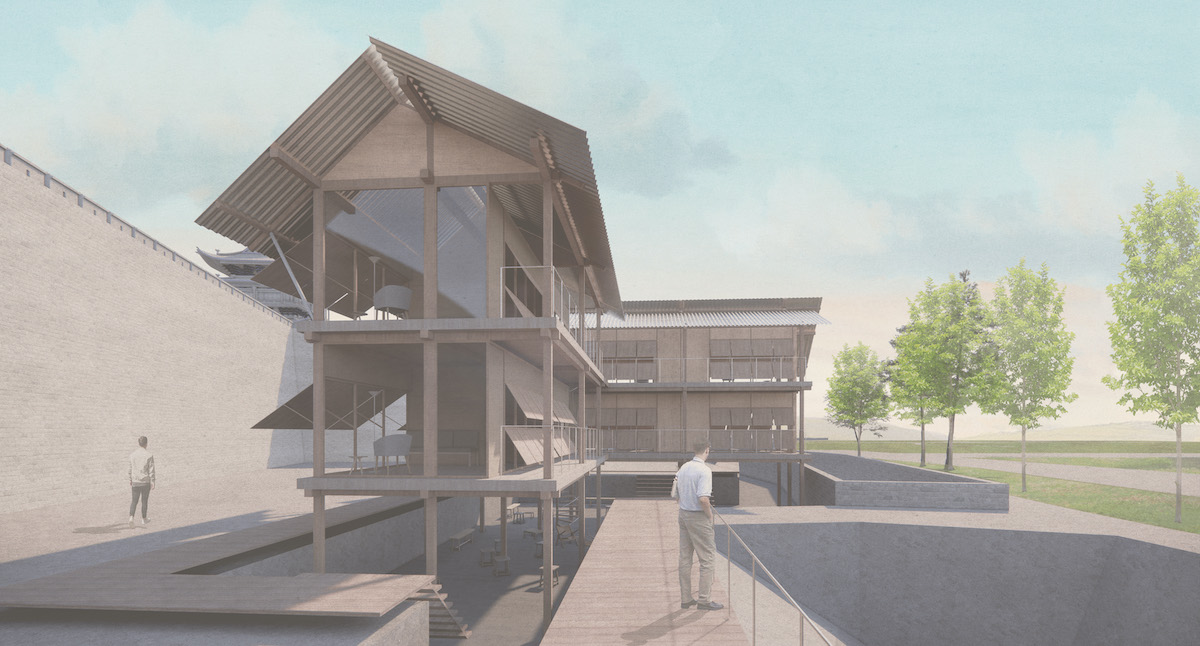
Tourism within China has been facilitated by a boom in infrastructure development, much of it built as part of the so-called Belt and Road Initiative that began in 2013. (The “belt” refers to the Silk Road Economic Belt and “road” to the 21st Century Maritime Silk Road—these are the land-based and sea-based parts of the initiative.) Transportation infrastructure of all types has been rapidly modernized. “The extension of major roadways has meant that places that would have taken you days to get there now take hours,” Neri says. “Before the train that takes 40 minutes from Shanghai to Hangzhou, it used to take three-and-a-half hours by car.” This increase in speed has “definitely increased tourism to places that would not have been easily accessible.”
How do you bring about an authentic connection to culture? How do you bring people together rather than isolating everyone? How do you prevent experience from being entirely commercialized?
A particular type of cultural tourism in China has grown dramatically as a result of this intensification of speed and accessibility. Imagine staged scenes of farmers leading cattle across picturesque bridges—with rows of tourists lined up in the right spot to catch the perfect photo. Neri describes how “developers have picked up on the idea that if you add culture to a common itinerary for tourists, it adds value.” This cold economic logic raises questions: “How do you bring about an authentic connection to culture?” Hu asks. “How do you bring people together rather than isolating everyone? How do you prevent experience from being entirely commercialized?”
Neri and Hu’s studio, “ De/constructing Cultural Tourism ,” looks at these questions as the impetus to exploring ways of creating more meaningful engagement with tourist sites. The problem they pose begins with John Ruskin, the 19th-century architecture theorist and philosopher of travel. Neri recites a famous Ruskin quote, which acts as a riddle: “I would rather teach drawing that my pupils may learn to love nature, than teach the looking at nature that they may learn to draw.” Neri explains that, “For Ruskin, drawing is the catalyst to seeing and understanding the things around us. In Ruskin’s argument, when we see something beautiful, our natural tendency is to want to possess it. But if we don’t understand it, the possession is meaningless.” Generating such understanding is difficult, Hu says: “The state of our contemporary reality involves taking out your iPhone to photograph something rather than sitting there and spending the time to sketch out a building. Nobody really writes in journals anymore. They just take films of themselves that go into the cloud, and they never have time to look at them again.”
The studio’s two locations are UNESCO-listed heritage sites, Ping Yao and the Mogao Caves at Dunhuang. The latter is a Buddhist sanctuary first constructed in 366 AD and located at a strategic point along the Silk Road, and the former is an “exceptionally well-preserved example of a traditional Han Chinese city, founded in the 14th century.” [1] These are among the most visited tourist sites in China, and thus are more likely to become checkboxes on itineraries than places for thoughtful engagement.
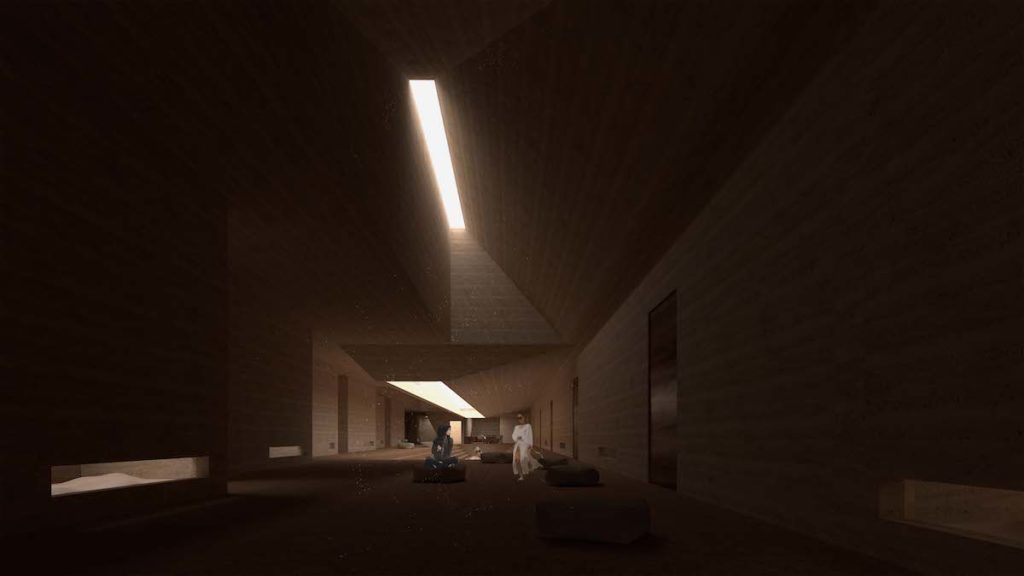
The studio focuses on a particular building type, the kezhan, or travelers’ rest stop. Neri describes one elaborate architectural form that serves as a precedent: “The typology of the caravanserai from the Middle East actually came to China along the Silk Road and became a different form,” he says. “It’s a city in itself. It’s usually round, very much like the famous Tulou in Fujian province, except much bigger. There are buildings inside—it’s a bazaar—and there’s always a hotel component. It’s a place where people come in and not only are they resting, but they’re also trading. It’s also a place of business, a safe environment.” Taking time is a key aspect of the architecture. “The longer you’re there, the more you come to know the inner circle of who’s actually in charge of the place,” Neri says. “It’s not just about fast transactions. It’s about layering. It’s also about hierarchy and vertical relationships. People sleep above and do their commercial activities on the ground floor.” The external orientation is equally nuanced. “Ultimately, our goal is for you to understand all the things around it,” Hu says. “There’s a lot of architectural strategy that students can use: framing views, staging interactions, opening up the layers of culture.”
Neri and Hu’s studio may ultimately provoke more questions than it answers. “The best part of the studio is that no one is traveling, so everyone is itchy to embark on that first trip after things open up,” Hu says. “The studio is like a rest stop for the students as well.”
Daniel D’Oca’s studio, “ Highways Revisited ,” focuses on a slice of American urban history that at first glance has little to do with tourism. D’Oca is an associate professor in practice of urban planning and co-founder of the New York–based firm Interboro Partners , and I talked to him while he was on the road. His studio zeroes in on the local impacts of America’s interstate highway system, which was expanded dramatically beginning with the Federal Aid Highway Act of 1956. The changes brought about by the act were enormous, including an explosion of suburban growth, the emptying of downtowns, and the solidification of automobile culture in the American psyche. Many freeways were routed through low-income minority neighborhoods, changing them profoundly, usually in negative ways. Examples are scattered across the country. D’Oca lists a couple his studio has investigated: “In Detroit, a highway was routed through Black Bottom, a Black neighborhood, more or less destroying it,” he says. “We’re also looking at a situation in El Paso where the fight is not whether to remove a highway, but whether or not to expand it beyond its current sixteen lanes.”

Tourism is not the most pressing issue in these neighborhoods, but it is an inextricable component of the urban dynamics the studio is considering. “The communities we’re working on care primarily about housing, stability, and quality of life issues,” D’Oca says, “but I suspect that tourism would be a desirable feature of a lot of these plans, as long as it turns out equitably.” One way tourism might help is by providing a boost to local economies. Take the Greenwood neighborhood in Tulsa. “This was a thriving Black neighborhood—it was called Black Wall Street—and it was the site of a massacre in the 1920s, an unspeakable tragedy. The second tragedy was the highway, which went right through the neighborhood when it was rebuilding itself,” D’Oca says. “You have a lot of efforts now to remember the past as part of revitalizing this community and others like it—both past tragedies and the history of when it was thriving. I suspect they want tourists, and tourists might want to see the history of Black Wall Street.”
There is a serious conflict between what the community needs and the effects of tourism.
Daniel D’Oca
Although tourism can bring a welcome influx of people, it has the potential to overwhelm. This is perhaps nowhere more evident than in New Orleans, where the Claiborne Expressway runs through the Tremé neighborhood. “You can imagine that if the freeway comes down, the neighborhood will be more desirable, and there will be a feeding frenzy with speculators buying up shopfront houses and turning them into Airbnb rentals,” D’Oca says. “Nobody in the community wants that. There is a serious conflict between what the community needs and the effects of tourism.” D’Oca advises that planners should take care when unleashing the force of tourism. “New Orleans is a cautionary tale,” he says. “The city has been eaten alive by Airbnb speculation. Entire neighborhoods have been bought up by speculators who turn houses into short term rentals. In the Tremé, it is the freeway that is keeping property values low. Fighting for the freeway to come down is only half the battle. The real battle is to make sure there’s an equitable plan for when it does come down.”
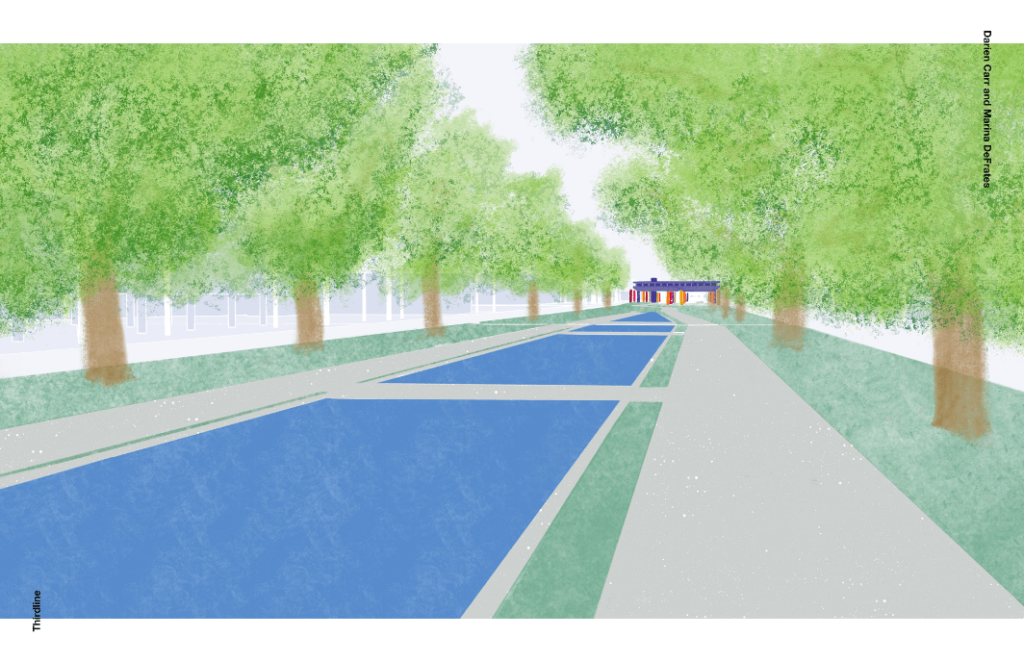
Another tricky question: What happens when tourists stay? D’Oca has noticed that “something interesting has happened in the pandemic” in the small town in upstate New York where he lives. “Some people have moved here as remote work has become more plausible, and a lot of people are buying up second homes to get out of the city. I guess it’s a form of tourism—these are people who aren’t moving here but all of a sudden have houses here.” This has created cultural conflict. D’Oca continues: “It becomes a different vision of what the place should be, and sometimes it’s a zero-sum game. For example, if this is your second home, you don’t want to see growth; you want it to remain a 19th-century pre-industrial hamlet. But a lot of other people don’t have the luxury for their hometown to be that. They need jobs, they need housing.”
D’Oca describes a scene that has played out in similar small towns across America: “In a neighboring town there was a huge fight over a dollar store,” he says. “It was basically local people against weekenders. Some people thought it was the apocalypse—a dollar store coming to town. People like us need to check our class privilege. It’s about the image of the place: whether it will remain an agrarian landscape with hardly any houses in it, or somewhere more livable for working-class people.”
Among the lessons of D’Oca’s studio is how tourism can shade into gentrification. “The connection to tourism that’s really important is that this is a region with a declining population that is desperate for economic development,” D’Oca says. “And the tourist economy is thriving. The town is twice as busy on the weekends now, and increasingly amenities are geared to tourists—business that are only open Thursday to Sunday, selling $15 deli sandwiches. It comes at the expense of people who don’t see this as a boutique town but just as a regular place.”
The studio project of Toshiko Mori is set in Maine, so it is inevitable that tourism factors in. Mori is the Robert P. Hubbard Professor in the Practice of Architecture at the GSD and principal of Toshiko Mori Architect , and I reached her at her office in New York. Tourism has long been a major part of Maine’s economy, and it was hit hard by pandemic travel restrictions: the number of visitors and total tourist revenue each fell by about one-quarter last year. Mori’s studio, “ Between Wilderness and Civilization ,” is set in the small town of Monson, near the Hundred-Mile Wilderness, which is considered to be the wildest section of the Appalachian Trail and is thus a major hiking destination. But the studio is not about tourism. The brief asks students to “balance progress with respect for its ecology” on an abandoned 72 acres of farmland near town, and Mori is interested in other, deeper ways of thinking about the relationship between a place, local people, and visitors.

The studio brief begins with story: “Over one hundred and fifty years ago, Henry David Thoreau was introduced to this forest by a Penobscot guide and chronicled his journey in his collection of essays The Maine Woods. At the end of his journey when he asked his guide if he was glad to have returned home, the guide replied, ‘It makes no difference where I am.’ To him, he belonged to the land, and the land did not belong to anyone—a fundamental mindset for living in balance with nature.”
Playing out the architectural implications of this mindset is a central goal of the studio. There don’t appear to be easy solutions. Monson has suffered job losses as local industries have shifted in recent decades, and it is not clear that plugging into Maine’s flow of tourists would revitalize the town. Hikers equip elsewhere, and the area is packed with picturesque locales. With support from the Libra Foundation, a nonprofit organization based in Portland, Mori has instead set up an experiment in symbiosis with Monson Arts , an artists’ and writers’ residency program. “The foundation bought up housing stock that was in decline, renovated them, and started an artists’ and writers’ residency program—bringing in a total of 90 people in the last couple of years,” Mori says. “They have a restaurant and a general store. The foundation previously bought a building in New Gloucester, Maine, which used to be a horrible institution—they called it an institution for the mentally feeble—that really just placed marginalized people in terrible living conditions. The organization renovated the building and converted its program to an agricultural facility.” The question of the studio: How can one intervene in one of the poorest places in New England to attract young people and propose a new and viable economic base?
Tourism is consumption-based—humans going somewhere to take and take and take. We don’t give back and we don’t even think of the symbiosis that’s necessary to sustain human life in the forest.
Toshiko Mori
Monson Arts does draw tourists of a sort, although they are different from those who come to hike. Instead, Monson is being recognized as “a good laboratory for solving the major problem of how to deal with poverty in rural areas in the United States, and how to save towns from obsolescence,” Mori says. “It’s a kick-starter kind of a program. Because of the artists’ residency, people like museum curators and cultural commissioners have been drawn to see what is going on in Monson. Even in the short time we were involved with Monson, we heard of many different organizations coming to see it as an example, perhaps to consider investing.” For Mori, one idea is to “create a new resource for these visitors.” She notes that “the artists themselves are interested in certain types of tourism. They may want to visit the Skowhegan School of Painting & Sculpture or the Maine Organic Farmers and Gardeners Association , the oldest and largest organic farming organization in the country.”
This circulation of people and ideas will hopefully serve the larger goal of connecting people with the Indigenous way of existing on the land. Monson is situated among the lakes and forests alongside the Piscataquis River, which flows into the Penobscot River, along which the present-day Penobscot Nation is located. Before European settlers, the tribe called the vast watershed of the Penobscot River home. “[The Penobscot] have a very different ethos and understanding of engagement with the place where they live,” Mori notes. “Tourism is consumption-based—humans going somewhere to take and take and take. We don’t give back and we don’t even think of the symbiosis that’s necessary to sustain human life in the forest.”

For the studio, Mori invited an ambassador from the Penobscot Nation to speak to the students about their life. “They travel by canoes on the Penobscot River; it’s a survival technique,” she says. “Which season to go to the coast or the river to fish, and when to forage in the forest. In the past they suffered a great deal because they were forbidden to forage in the forest, they were given ration foods, and their lifestyle was completely changed, leading ultimately to a public health crisis.” Fortunately, “They’re slowly gaining back their way of life,” Mori continues. “It depends on respecting land, not exploiting it. They think of the forest and human society in terms of equal coexistence.” This mindset manifests in all sorts of ways, large and small. Some examples came through in a visit to the exhibit of Penobscot birchbark canoes in Harvard’s Peabody Museum around the corner from the GSD. “For the birchbark canoes, there are ways to peel the bark without damaging the trees,” Mori says. “Another idea is that, when harvesting bark, it is better not to harvest from the best trees, but rather from the second best. That way the best trees can continue to sustain younger trees and protect other species. This is a very important piece of Indigenous wisdom.”
When emphasizing the sense of connection with nature, Mori is quick to point out that we should not be misled by simple distinctions between city and wilderness. “I live in New York, and this is our nature,” Mori emphasizes. “This is the place we live. We have to work with an ecosystem of this particular density, with the lives of people collapsed together in this way.” Mori is ultimately pessimistic about the capacity of tourism to allow connections to such wisdom. “In a real analysis, you would see that tourism is a colonial activity,” she says. “We really have to think twice about it. I think climate change is helping people to see this. The pandemic has helped us realize how high the energy consumption of travel is, and how unnecessary it is. Tourism in a city is similar to tourism in nature: people just skim the surface of glamour of a place like New York. But the people who lived through the pandemic in a city really got to understand its true nature and what makes it work. That’s similar in some ways to how Indigenous people live: living with the land, in good times and bad, then not just leaving because it’s not a fun time. Going through different seasons and difficult predicaments and embracing all the circumstances of a place and people—that is very different from the voyeuristic mentality of tourism.”
So, can the mentality of tourism shift? Mori’s conclusion also summarizes the sentiments of her colleagues D’Oca, Neri, and Hu: “Going forward from the pandemic, we have to be very wise and conscientious tourists. To get away from tourism as consumption, we have to be open-minded to learn from other people and their environments.”
[1] “Mogao Caves,” UNESCO [https://whc.unesco.org/en/list/440]. “Ancient City of Ping Yao,” UNESCO [https://whc.unesco.org/en/list/812].
- Sustainability
- De/constructing Cultural Tourism – Ke Zhan (Traveler’s Rest Stop) Case Study
- Highways Revisited
- Between Wilderness and Civilization: Monson, Maine

The Future of Tourism
Innovation and Sustainability
- © 2019
- Eduardo Fayos-Solà 0 ,
- Chris Cooper 1
Ulysses Foundation, Madrid, Spain
You can also search for this editor in PubMed Google Scholar
School of Events, Tourism and Hospitality Management, Leeds Beckett University, Leeds, UK
- Presents the scientific, technological and cultural drivers for the future of tourism
- Considers alternative roles for tourism in the shaping of intelligent futures
- Analyzes an integrative framework for tourism futures based upon innovation
- Introduces policy and governance proposals for an inclusive and sustainable future of tourism
50k Accesses
95 Citations
2 Altmetric
This is a preview of subscription content, log in via an institution to check access.
Access this book
- Available as EPUB and PDF
- Read on any device
- Instant download
- Own it forever
- Compact, lightweight edition
- Dispatched in 3 to 5 business days
- Free shipping worldwide - see info
- Durable hardcover edition
Tax calculation will be finalised at checkout
Other ways to access
Licence this eBook for your library
Institutional subscriptions
Table of contents (18 chapters)
Front matter, introduction: innovation and the future of tourism.
- Eduardo Fayos-Solà, Chris Cooper
Tourism Futures and the Technological Facets of Innovation
Resources: eco-efficiency, sustainability and innovation in tourism.
- Margarita Robaina, Mara Madaleno
The Deepening Effects of the Digital Revolution
- Carlos Romero Dexeus
Tourism and Economics: Technologically Enabled Transactions
- Larry Yu, Philippe Duverger
Tourism and Science: Research, Knowledge Dissemination and Innovation
- Natarajan Ishwaran, Maharaj Vijay Reddy
Case Studies in Technological Innovation
- Chris Cooper, Eduardo Fayos-Solà, Jafar Jafari, Claudia Lisboa, Cipriano Marín, Yolanda Perdomo et al.
Cultural Paradigms and Innovation
Paradoxes of postmodern tourists and innovation in tourism marketing.
- Enrique Bigné, Alain Decrop
The Future of Ethics in Tourism
- David A. Fennell
Cultural Paradigm Inertia and Urban Tourism
- Chiara Ronchini
Urban Tourism and Walkability
- Salvador Anton Clavé
Intelligence and Innovation for City Tourism Sustainability
Case studies in sociocultural innovation.
- Chris Cooper, Francois Bedard, Benoit Duguay, Donald Hawkins, Mohamed Reda Khomsi, Jaume Mata et al.
Tourism Governance Innovation
Measuring tourism: methods, indicators, and needs.
- Rodolfo Baggio
Tourism Destination Re-positioning and Strategies
Coopetition for tourism destination policy and governance: the century of local power.
- Maya Damayanti, Noel Scott, Lisa Ruhanen
Focusing on Knowledge Exchange: The Role of Trust in Tourism Networks
- Conor McTiernan, Rhodri Thomas, Stephanie Jameson
- sustainable tourism development
- innovation in tourism
- tourism policy
- disruptive business model
- digital transformation
- tourism code of ethics
- tourism governance framework
About this book
This book presents the foundations for the future of tourism in a structured and detailed format. The who-is-who of tourism intelligence has collaborated to present a definitive blueprint for tourism reflecting the role of science, market institutions, and governance in its innovation and sustainability. The book adopts a comprehensive approach, exploring recent research and the latest developments in practice to inform the reader about instruments and actions that can shape a successful future for tourism. Broad in scope, the book incorporates the perspectives of leading tourism academics, as well as the views of tourism entrepreneurs, destination managers, government officials, and civil leaders.
“This book does a good job of examining tourism sustainability and innovation within this environment of uncertainty to the extent that this book is, as mentioned above, a ‘must read’ for those interested in tourism futures.” (Michael Conlin, Journal of Tourism Futures, Vol. 5 (3), 2019)
Editors and Affiliations
Eduardo Fayos-Solà
Chris Cooper
About the editors
Bibliographic information.
Book Title : The Future of Tourism
Book Subtitle : Innovation and Sustainability
Editors : Eduardo Fayos-Solà, Chris Cooper
DOI : https://doi.org/10.1007/978-3-319-89941-1
Publisher : Springer Cham
eBook Packages : Business and Management , Business and Management (R0)
Copyright Information : Springer International Publishing AG, part of Springer Nature 2019
Hardcover ISBN : 978-3-319-89940-4 Published: 05 September 2018
Softcover ISBN : 978-3-030-07899-7 Published: 22 December 2018
eBook ISBN : 978-3-319-89941-1 Published: 22 August 2018
Edition Number : 1
Number of Pages : XXI, 337
Number of Illustrations : 31 b/w illustrations
Topics : Tourism Management , e-Business/e-Commerce , Public Policy , Sustainable Development , Business Information Systems , Knowledge Management
- Publish with us
Policies and ethics
- Find a journal
- Track your research
The future of tourism is sustainable and regenerative

To make tourism sustainable and even regenerative, travellers themselves must undergo a mindset shift — but that's not easy in a cost-of-living squeeze. Image: Reuters/Jonathan Ernst
.chakra .wef-1c7l3mo{-webkit-transition:all 0.15s ease-out;transition:all 0.15s ease-out;cursor:pointer;-webkit-text-decoration:none;text-decoration:none;outline:none;color:inherit;}.chakra .wef-1c7l3mo:hover,.chakra .wef-1c7l3mo[data-hover]{-webkit-text-decoration:underline;text-decoration:underline;}.chakra .wef-1c7l3mo:focus,.chakra .wef-1c7l3mo[data-focus]{box-shadow:0 0 0 3px rgba(168,203,251,0.5);} Naoko Tochibayashi
Naoko kutty.

.chakra .wef-9dduvl{margin-top:16px;margin-bottom:16px;line-height:1.388;font-size:1.25rem;}@media screen and (min-width:56.5rem){.chakra .wef-9dduvl{font-size:1.125rem;}} Explore and monitor how .chakra .wef-15eoq1r{margin-top:16px;margin-bottom:16px;line-height:1.388;font-size:1.25rem;color:#F7DB5E;}@media screen and (min-width:56.5rem){.chakra .wef-15eoq1r{font-size:1.125rem;}} Travel and Tourism is affecting economies, industries and global issues

.chakra .wef-1nk5u5d{margin-top:16px;margin-bottom:16px;line-height:1.388;color:#2846F8;font-size:1.25rem;}@media screen and (min-width:56.5rem){.chakra .wef-1nk5u5d{font-size:1.125rem;}} Get involved with our crowdsourced digital platform to deliver impact at scale
Stay up to date:, davos agenda.
Listen to the article
- Japanese domestic tourism is recovering from the shock of the pandemic but international travel is lagging.
- Travellers increasingly demand sustainable and affordable options — but those are hard to come by in a cost-of-living squeeze.
- To make sustainable and regenerative tourism a reality, travellers themselves must undergo a mindset shift.
Since the significant easing of its pandemic border control measures last October, Japan has seen a steady return of foreign tourists.
According to the Japan National Tourism Organization (JNTO), the number of visitors to Japan in July reached 2.32 million, recovering to about 80% of 2019 levels.
And Japanese people are travelling their own country more, too. According to the travel trend survey by Japan Travel Bureau(JTB), 72.5 million people in Japan traveled within their country during the summer vacation season in July and August — almost returning to pre-pandemic levels. International travel, meanwhile, was low: 1.2 million people , which is 40% of the 2019 figures.
Many people wished to travel abroad but were unable or unwilling to do so cited concerns about safety and health, the lengthy immigration procedures involved in international travel and the unfavourable exchange rates and high costs.
For the outbound recovery to gain momentum, a safe and economically enabling environment is essential.
Have you read?
3 ways hotels and tourists can work together to decarbonize travel, japan airlines' clothing rental service aims for sustainable tourism, overtourism: a challenge to sustainability.
As the influx of tourists revitalizes local economies, a growing concern is emerging: the resurgence of overtourism, where popular destinations are flooded with an excessive number of visitors. In response, Prime Minister Kishida Fumio has announced plans to develop solutions this coming autumn to combat overtourism, addressing its negative impacts on local life, including congestion, traffic jams and litter.
Even before the COVID-19 pandemic, overtourism had started to plague certain Japanese tourist spots. As Japan's tourism industry and tourist destinations hit hard by the pandemic make strides toward recovery, it essential to view these challenges as opportunities for positive change and transform tourism into something more sustainable.
Hotels across Japan are accelerating their sustainability efforts. One noteworthy example is the Tokyo Station Hotel, located within the Tokyo Station building, which is designated as a National Important Cultural Property, is implementing the " CO₂ Zero STAY " programme to virtually eliminate CO₂ emissions generated during a stay by all rooms booked through the official website.
The World Economic Forum’s Platform for Shaping the Future of Mobility works across four industries: aerospace and drones; automotive and new mobility; aviation travel and tourism; and supply chain and transport. It aims to ensure that the future of mobility is safe, clean, and inclusive.
- Through the Clean Skies for Tomorrow Coalition , more than 100 companies are working together to power global aviation with 10% sustainable aviation fuel by 2030.
- In collaboration with UNICEF, the Forum developed a charter with leading shipping, airlines and logistics to support COVAX in delivering more than 1 billion COVID-19 vaccines to vulnerable communities worldwide.
- The Road Freight Zero Project and P4G-Getting to Zero Coalition have led to outcomes demonstrating the rationale, costs and opportunities for accelerating the transition to zero emission freight.
- The Medicine from the Sky initiative is using drones to deliver vaccines and medicine to remote areas in India, completing over 300 successful trials.
- The Forum’s Target True Zero initiative is working to accelerate the deployment and scaling of zero emission aviation, leveraging electric and hydrogen flight technologies.
- In collaboration with the City of Los Angeles, Federal Aviation Administration, and NASA, the Forum developed the Principles of the Urban Sky to help adopt Urban Air Mobility in cities worldwide.
- The Forum led the development of the Space Sustainability Rating to incentivize and promote a more safe and sustainable approach to space mission management and debris mitigation in orbit.
- The Circular Cars Initiative is informing the automotive circularity policy agenda, following the endorsement from European Commission and Zero Emission Vehicle Transition Council countries, and is now invited to support China’s policy roadmap.
- The Moving India network is working with policymakers to advance electric vehicle manufacturing policies, ignite adoption of zero emission road freight vehicles, and finance the transition.
- The Urban Mobility Scorecards initiative – led by the Forum’s Global New Mobility Coalition – is bringing together mobility operators and cities to benchmark the transition to sustainable urban mobility systems.
Contact us for more information on how to get involved.
This initiative, which uses the carbon offset system, calculates and visualizes the amount of CO₂ emissions generated by guest stays and invests the equivalent amount in emissions reduction activities, thereby reducing the emissions to virtually zero. All costs are covered by the hotel itself, meaning that guests contribute to expanding forest conservation efforts and supporting renewable energy simply by staying at the hotel.
Another player in the sustainable hospitality scene is Mori Trust Hotels & Resorts. They are taking steps to preserve tourism resources by introducing eco-friendly amenities like wooden and bamboo toothbrushes and hairbrushes, as well as razors and shower caps with reduced plastic content. They are also eliminating individual packaging for soaps and amenities while charging for these items. The company is currently reassessing the amenities used in their 18 hotels nationwide, which collectively use around 16 tons of plastic each year, and aims to cut down the plastic used in amenities by over 90% by 2024.
Traveller behaviour and tourism
As hotels and other players in the tourism industry move towards a more sustainable future, it is equally crucial that travellers, who are the main drivers of tourism, follow suit and change their attitudes and behaviours.
According to the Sustainable Travel Report 2023 , which gathered insights from over 33,000 travellers across 35 countries and territories, 76% of global travellers — and 56% of Japanese travellers — express a desire to embrace more sustainable travel over the coming 12 months. On the other hand, 76% of global travellers and 75% of Japanese travellers say that the global energy crisis and rising costs are impacting their spending plans. This has led to travellers being more budget-conscious, with only 43% of global travellers and 22% of Japanese travellers willing to pay extra for certified sustainable travel experiences.
In light of this trend, offering discounts and financial incentives by tourism providers may motivate travellers to opt for sustainable travel options. Furthermore, providing more information and choices can also promote sustainable travel, since almost half of both global and Japanese travellers feel there are not enough sustainable travel options available to them.
Regenerative tourism: the future of tourism
"There's one thing we can do: actively choose sustainable hotels and resorts, and contribute to their economic impact. Guests are the key to creating a sustainable environment," says travel journalist Naoko Terada, highlighting a crucial step that we all must take.
To achieve sustainable tourism that considers environmental, social and economic impacts, it is essential to change the mindset of travellers, who must act responsibly in terms of their impact on local communities and the natural environment. The realization of a future in which regenerative tourism, a further evolution of sustainable tourism, becomes mainstream depends on changing the behaviour of both hosts and travellers.
In the World Economic Forum's Travel & Tourism Development Index 2021: Rebuilding for a Sustainable and Resilient Future , Japan took the top spot in the development index ranking.
Japan, a highly regarded tourist destination, is leading the way in the future of regenerative tourism — where the more tourists visit, the more the place changes for the better — which will have a significant impact on the transformation of the global tourism industry.
Don't miss any update on this topic
Create a free account and access your personalized content collection with our latest publications and analyses.
License and Republishing
World Economic Forum articles may be republished in accordance with the Creative Commons Attribution-NonCommercial-NoDerivatives 4.0 International Public License, and in accordance with our Terms of Use.
The views expressed in this article are those of the author alone and not the World Economic Forum.
Related topics:
The agenda .chakra .wef-n7bacu{margin-top:16px;margin-bottom:16px;line-height:1.388;font-weight:400;} weekly.
A weekly update of the most important issues driving the global agenda
.chakra .wef-1dtnjt5{display:-webkit-box;display:-webkit-flex;display:-ms-flexbox;display:flex;-webkit-align-items:center;-webkit-box-align:center;-ms-flex-align:center;align-items:center;-webkit-flex-wrap:wrap;-ms-flex-wrap:wrap;flex-wrap:wrap;} More on Davos Agenda .chakra .wef-nr1rr4{display:-webkit-inline-box;display:-webkit-inline-flex;display:-ms-inline-flexbox;display:inline-flex;white-space:normal;vertical-align:middle;text-transform:uppercase;font-size:0.75rem;border-radius:0.25rem;font-weight:700;-webkit-align-items:center;-webkit-box-align:center;-ms-flex-align:center;align-items:center;line-height:1.2;-webkit-letter-spacing:1.25px;-moz-letter-spacing:1.25px;-ms-letter-spacing:1.25px;letter-spacing:1.25px;background:none;padding:0px;color:#B3B3B3;-webkit-box-decoration-break:clone;box-decoration-break:clone;-webkit-box-decoration-break:clone;}@media screen and (min-width:37.5rem){.chakra .wef-nr1rr4{font-size:0.875rem;}}@media screen and (min-width:56.5rem){.chakra .wef-nr1rr4{font-size:1rem;}} See all

Davos 2024 Opening Film

Building trust amid uncertainty – 3 risk experts on the state of the world in 2024
Andrea Willige
March 27, 2024

Why obesity is rising and how we can live healthy lives
Shyam Bishen
March 20, 2024

Global cooperation is stalling – but new trade pacts show collaboration is still possible. Here are 6 to know about
Simon Torkington
March 15, 2024

How messages of hope, diversity and representation are being used to inspire changemakers to act
Miranda Barker
March 7, 2024

AI, leadership, and the art of persuasion – Forum podcasts you should hear this month
Robin Pomeroy
March 1, 2024

The Rise of Virtual Reality Tourism/Digitization of Culture in the Time of COVID-19
Flights canceled, famous attractions closed to the public, once crowded streets now vacant— emptied of tourists snapping photos. In the age of the COVID-19 pandemic, traditional tourism has ground to a screeching halt in most places. Tourism has had to evolve to match the unprecedented and prolonged global travel restrictions, a situation that has made a profound impact on nations and industries around the globe. It has been indicated that the global tourism sector should expect to suffer a drop of about US$8.1 trillion in revenue due to the pandemic and will likely not recover until 2024. With many of their most popular landmarks, cities, and heritage sites closing or implementing restrictions, countries have had to radically rethink their tourism industries and cultural institutions have had to adapt to a time of reduced visitors and in-person engagement. The intersection of innovation with the need to digitize experiences and content in order to reduce human interaction have converged uniquely in 2020, marking a critical moment in the rise of virtual reality tourism and the digitization of culture.
Virtual reality tourism technologies have been evolving for the past few years, used primarily as an educational tool, allowing users to engage with the history, geography, and cultural aspects of location and serving as a substitute for physical visitation. It incorporates cutting edge technologies, such as high resolution 360- degree imaging and simulated movement capabilities to enable users to view, tour, and engage with landmarks and tourist destinations without leaving their homes. Museums, cultural sites, and locations of worldwide-renown can be explored on personal computers and tablets. One such site, the Seokguram Grotto hermitage and monastery complex in South Korea, utilized VR technology to construct a 3D stereopsis of the site and provide a digitized experience for visitors. The COVID-19 pandemic has created an additional opportunity for virtual tourism to provide travel-related content accessible around the world and explore the additional benefits of VR technology.
Many governments have been crafting virtual tours in hopes of attracting viewers who wish to visit cities around the world without the current risks of travel: exposure to the virus, or the logistical complications of widespread, pandemic-related bans and restrictions. Cities such as Paris, which attracted 38 million tourists in 2019 alone, have adopted virtual technology to continue to showcase iconic landmarks, by using the interactive features of Google Arts and Culture: users can select sites of interest and navigate the landscapes by clicking their way from one vantage point to another. The Paris Tourist Board website, for example, also allows users to view landmarks such as the Eiffel Tower and the Palais Garnier. Because of the 2020 Olympics’ postponement, the Japan National Tourism Organization created a 360-degree virtual tour that can be viewed via smartphone or with VR goggles, Japan: Where Tradition Meets the Future , which virtually transports users to well-known landmarks including the Tokyo Tower and the Sagano Bamboo Forest, blending culture and technology in an innovative and engaging way. Smaller towns that are less tourist-dependent are also hoping to retain exposure and relevance by creating virtual representations of their architecture. This way people can continue to experience the landscapes and perhaps become inspired to travel to the destination post-pandemic. Germany’s Herrenberg is one such town; they created a “virtual twin” utilizing computerized technologies usually used for high-level aerospace tasks to replicate the town’s architecture on a digital platform, enabling visitors to immerse themselves in the sites of the town center via VR glasses.
Digitization of Culture
Outdoor landmarks and city streets are not the only places that can now be enjoyed virtually as people hunker down in their homes. Cultural institutions, particularly museums, which face a severe reduction in the number of visitors strolling through galleries and perusing collections due to pandemic-related restrictions, have also started to adapt and modernize to continue to attract attention and virtual visitors. An empirical study of 100 of the largest state museums in Italy revealed that, throughout the most restrictive period of national lockdown, there was a sharp increase in online cultural initiatives conducted by museums via social media in order to continue stimulating viewer engagement through digital material. In this way, social media platforms—such as Instagram, Facebook, and Twitter—have been an invaluable tool in promoting cultural engagement during the COVID-19 crisis.
Besides simply engaging people in museum content, social media and digital platforms have also connected people during this time of limited social interaction. The Italian Ministry of Cultural Heritage, for example, organized unique, virtual community events including the ArtYouReady virtual flash mob, an initiative that encouraged online users to post pictures of their favorite Italian cultural sites. Such virtual opportunities and initiatives have continued throughout the pandemic, likely remaining a staple for cultural organizations’ public engagement strategies.
The evolution of digital engagement at museums in Europe was highlighted in a post written by Chiarra Zuanni, assistant professor in digital humanities at the Centre for Information Modelling at the University of Graz, for Europeana, a European organization that works to support and empower the digitization of cultural heritage. Zuanni compiled a map to visually depict the evolving digital activities of museums throughout Europe. The map identified various categories of digital offerings, such as contemporary collecting projects, social media initiatives (local hashtags, targeted projects, etc.), streaming content, virtual tours, online exhibitions, games, and educational content. The map enables users to select locations or activities of interest and access direct links to the respective museum’s interactive sites. The map shows a widespread rise in online activity from museums across the continent, providing a look into just a small fraction of museums that are adopting modernized and digitized tactics to maintain and foster relationships with a global audience in a time when in-person interactions and the usual flow of tourists have been severely curbed.
COVID-19 has caused museums’, galleries’, and historic residences’ usage of digital technology to transition from being a mere supplementary tool used to offer additional and secondary services and content to being the primary source of continued engagement with the arts. The pandemic has created the unique opportunity for museums to radically redefine their marketing and content strategies, forcing traditionally archaic institutions to adapt to the modern world at a rapid speed.
New Opportunities to Explore
Is this the future? Are the days strolling through cobblestone streets, snapping photos at iconic landmarks and wandering through bustling art galleries simply experiences of the past? Not necessarily. When the pandemic subsides and the world reawakens from lockdowns, restrictions, and travel bans, travel will likely resume. While it may take years for the industry to fully recover, tourism will eventually reemerge as a prominent economic sector. Cultural institutions will reopen, welcoming visitors from around the world to engage with history and art once more.
Yet, although the COVID-19 pandemic devastated numerous economic sectors and rendered several aspects of daily life and travel unrecognizable, it has also unlocked the enhanced opportunity for countries and organizations to harness the full potential of virtual reality tourism. Museum attendance across several countries, particularly attendance at art museums, has been in decline in recent years. Virtual offerings however, seem to be driving significant user interest due to the increase in virtual engagement with cultural and artistic content on cultural websites. The increased adoption of technology could help prevent museums from buckling under the weight of low visitor rates if they can identify ways to accrue revenue through digital means.
In the same vein, the COVID-19 epidemic and subsequent lockdown have prompted countries to rethink their tourism strategies, opening the door for an already burgeoning virtual tourism industry to take root. Easily accessible for users around the world, providing access to landmarks and locations that are currently restricted, and free or low in cost for users, virtual tours allow for global experiences to be enjoyed by large, international audiences. While not a replacement for the thrill of physical travel, the virtual tourism sector offers intriguing opportunities for accessible global experiences.
The intersection of modern, cutting-edge innovation with a global pandemic has created a pivotal moment in how we access, view, and support tourism and cultural markets, both of which are critical to developing and sustaining national economies. The use of digital technologies in light of the COVID-19 epidemic highlights the benefits of rising technological innovations, offering viable and fascinating avenues for nations to adapt to a largely unprecedented world in the years ahead.

Abby LaBreck
Abby LaBreck is an Executive Content Editor & Staff Writer for the HIR. She is interested in European affairs and transatlantic relations. She has previously written about French culture/politics.
Recent Posts
The united states of europe and liberalism in the 21st century: interview with beate meinl-reisinger, chairwoman of austria’s neos party.
A New Vision for Thailand: Interview with Pita Limjaroenrat, Member of the Thai House of Representatives and Former Leader of the Move Forward Party
Israel, Gaza, and Operation Swords of Iron: Interview with Sharren Haskel, Member of the Israeli Knesset
Medical Servitude: The Other Side of Cuban Medical Diplomacy
Remember Us: A Peek Into Childhood Autism in Ghana
You Might Be Interested In
Cambodia’s triumph and tragedy: the un’s greatest experiment 30 years on, the artificial intelligence revolution in an unprepared world: china, the international stage, and the future of ai, rated c for censored: walt disney in china’s pocket.

Innovators magazine
- food | water
clean energy
- INSIDE IDEAS
- Challenges/Funding
- What’s on
- Innovation Academy
- Magazines/Publications
- Our Mission
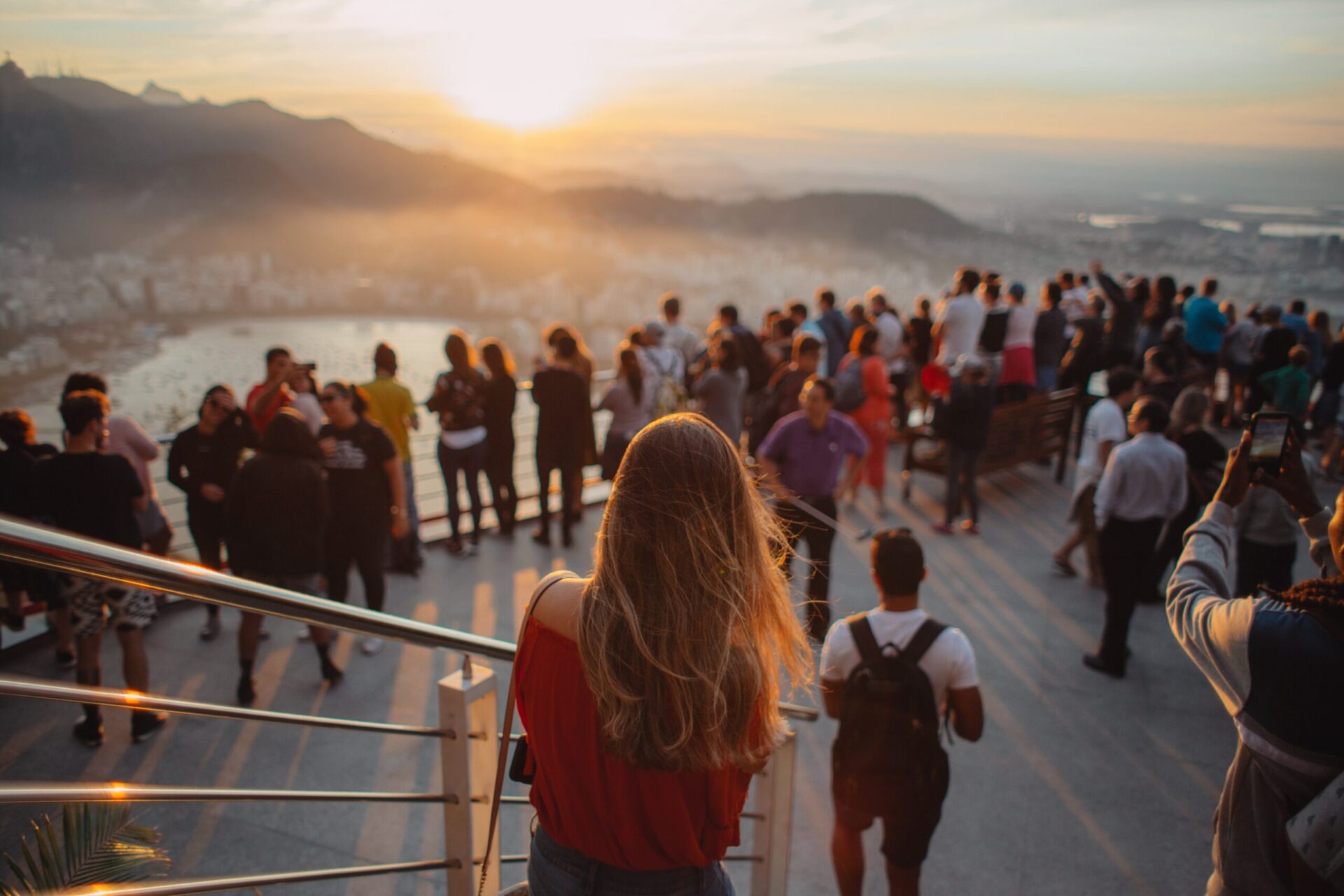
Editor's Picks
What is the future for tourism.
Overtourism was a serious problem pre-pandemic, the question now – as restrictions continue to ease, is will it return? To help answer that and explore ways in which it can be avoided, Dr Martha Honey and Kelsey Frenkiel join me on today’s episode of Inside Ideas .
They are both tourism experts, and authors who have written extensively on the world of travel. Offering a unique insight in to the state of the industry: where it was going, and where it might be heading next, they recently released their book Overtourism: Lessons for a Better Future , which they edited together.
Dr Honey is CEO of Responsible Travel Consulting and co-founder and former executive director of the Center for Responsible Travel ( CREST ); and Kelsey Frenkiel is a program manager at CREST. Before the pandemic hit, overtourism was the burning issue on their minds.
We can take the lessons that we learned from Covid and come up with a better future for the tourism industry. Kelsey Frenkiel
“Overtourism had been defined in the years prior to 2018, but it really came to the world’s stage at that time, and actually – I think we can credit a lot of news media for covering the problem and making sure the world knew that residents were really fed up. They were marching in the streets in Barcelona and Venice telling tourists to go home. And not only those daytrippers, in Venice it was very much the cruise tourists,” Frenkiel said. “So, in 2018 CREST started off by hosting our World Tourism Day Forum in September, which we do every year, on overtourism and finding solutions. Coming out of that event, we took some of the case studies and those lessons learned and decided to come up with a book. That year we also saw 1.5 billion tourists cross international borders and all of the projections were saying that this was going to increase exponentially.”
She continued: “We never imagined that, in the middle of writing this book, tourism would halt completely and I think in 2020 there was only something like 400 million international arrivals, which is still a huge number, but for a time it was halted completely, obviously brought on by a global health crisis. I think what we saw was that Covid 19 triggered new and unique challenges for tourism and it actually proved to us that this information was more timely than ever. So we took that opportunity to frame the book, talk about the pandemic and how this information could be used.”
The book charts a path towards sustainable tourism, one that is underpinned by a commitment to people, planet, and prosperity.
Frenkiel added: “We came up with 13 guiding principles for the future of tourism, so for example, seeing the whole picture – tourism often isn’t looked at very holistically. We used better metrics, so not just measuring tourism by the number of people visiting but what impacts they are having. Those are the kind of steps that we took to chart a better path forward after Covid, and also on the back of the responses that we were seeing from people because of Covid and the new challenges that they were dealing with. What we want everyone to know is that this is an opportunity to really reset.”
A return to a business as usual world of overtourism is something the pair don’t want to see and they say there are plenty of alternatives.
“The problem of overtourism and climate change were really the two biggest catastrophes facing the tourism industry,” Dr Honey said. Which, for some time, had been increasing calls for more sustainable and regenerative forms of tourism.
“Sustainable travel, responsible travel is actually superior for the traveller. It’s not just the right thing for the planet, or for the local community, or the environment, but it actually provides a superior vacation – we don’t need to apologise for trying to get people to do the right thing,” Dr Honey explained. “Done properly, done well – it is a superior kind of vacation. The origins of eco-tourism, which is the first sort of term within the tourism field that had a kind of ethics behind it, it was not just describing the kinds of travel, but it talked about the impact of travel and that, done well, it can be positive. From the original concept of eco-tourism we have seen a flowering of all kinds of other terms – with the most recent term being ‘regenerative tourism’ – leave a place better than you found it.”
Global citizens
The book provides a roadmap for moving tourism forward beyond the pandemic because, as Dr Honey points out, travel is vital in opening minds.
“When you travel, especially if you travel in a way that doesn’t just take you to an enclave, like an all-inclusive beach resort, but in a way that actually gets you out meeting other people, then this is a profound form of education that is stimulating parts of our brains that are not quite stimulated by classroom learning. It’s a different type of learning, experiential, and in a way it can be more profound than book learning because all your senses are involved, and so building global citizenship through travel is an extremely important reason for keeping the travel industry going, and it was threatened by the pandemic, but we are convinced that we need this as human beings, as societies.”
As people begin to travel and plan where they might go in the future, it is time to discuss what that should look like. So I am delighted to welcome today’s guests on the show to discuss a topic that is important to so many of us.
Listeners and followers of Inside Ideas can also get 20% off Overtourism: Lessons for a Better Future here by using the code HONEY.
Prince William reveals Earthshot finalists
What should an economy value.

Marc is Editor-at-Large for Innovators Magazine and host of INSIDE IDEAS, his OnePoint5Media video podcast show. Marc is a member of the World Economic Forum Expert Network, Resilient Futurist, and award-winning Global Food Reformist.

Changemakers are flocking to the new world of EU innovation

How our deepest desires can lead to better decision-making

How to use gaming to better understand the climate crisis

World’s first green hydrogen-powered flight will takeoff in 2028
Privacy Overview

About the Future of Tourism Coalition
We are a coalition of six non-governmental organizations that have come together to stand united in an appeal for change.
Our Coalition

The Center for Responsible Travel (CREST) is a nonprofit research organization dedicated to increasing the positive global impact of responsible tourism. CREST assists governments, policy makers, tourism businesses, nonprofit organizations, and international agencies with finding solutions to critical issues confronting tourism, the world’s largest service industry. Learn about CREST’s innovative field projects, research, and advocacy at www.responsibletravel.org .

The Destination Stewardship Center is a volunteer-driven nonprofit organization dedicated to protecting the world’s distinctive places by supporting wisely managed tourism and enlightened destination stewardship. We gather and provide information on how tourism can help and not harm the natural, cultural, and social quality of destinations around the world. We seek to build a global community and knowledge network for advancing this goal. Join us at www.destinationcenter.org.

Green Destinations is a non-profit foundation for sustainable destination development and recognition, leading a global Partnership of representatives, expert organisations and academic institutions. We work for the benefit of the Green Destinations Community: destination representatives and stakeholders. Together we make their places better and more sustainable. Learn more at www.greendestinations.org.
Sustainable Travel International is a non-profit organization dedicated to protecting and conserving our planet’s most vulnerable destinations. We are transforming tourism’s impact on nature and people by working alongside local communities, engaging travelers and businesses in responsible practices, and strengthening destination management. Through our work, we aim to safeguard nature, combat climate change, and empower communities to preserve the integrity of destinations around the globe. To learn more, visit www.sustainabletravel.org .

Tourism Cares unites the travel industry to advance its positive impact to help people and places thrive. For nearly 20 years, Tourism Cares has been the travel industry’s nonprofit network bringing its members from around the globe together to create powerful connections and drive action. We believe it is in our best interest to support the destinations we all depend on so that communities, travelers and businesses can prosper. Learn more at www.tourismcares.org.

The Travel Foundation is a leading global charity that works in partnership with governments, businesses and communities to develop and manage tourism to maximise its benefits for communities and the environment, so that destinations can thrive. Founded in 2003, it has worked in nearly 30 countries around the world. Its head office is based in the UK and it has a global network of project managers. Learn more at www.thetravelfoundation.org.uk.
Coalition Advisor

The Global Sustainable Tourism Council (GSTC) establishes and manages global sustainable standards, known as the GSTC Criteria. There are two sets: Destination Criteria for public policy-makers and destination managers, and Industry Criteria for hotels and tour operators. The GSTC Criteria form the foundation for accreditation of certification bodies that certify hotels/accommodations, tour operators, and destinations as having sustainable policies and practices in place. GSTC does not directly certify any products or services, but it accredits those that do. Learn more at www.gstc.org .
Advisory Committee
The Advisory Committee provides the Future of Tourism Coalition with expertise and guidance on areas that are strategic for the transformation of tourism and may otherwise be under-represented. It provides broader perspectives to ensure the movement remains true to its Guiding Principles, mission, and vision, and that the approach is inclusive, integrated, and representative.
Advisory Committee members serve in an individual capacity, endorsed by their organizations, but not as their representatives. They act on a voluntary, pro bono basis and meet as a full group at least twice each year.
The Advisory Committee currently consists of 13 members:
Alessandra Alonso
Women In Travel cic
Cristina Blackburn
Director, Private Sector Engagement
World Wildlife Fund
Randy Durband
Global Sustainable Tourism Council (GSTC)
Alicia Fajardo
#TurismoRESET
Chris Flynn
President and CEO
World Tourism Association for Culture and Heritage
Stephanie Jones
National Blacks in Travel & Tourism Collaborative
Judy Kepher-Gona
Sustainable Travel and Tourism Agenda
Kelley Louise
Founder and Executive Director
Impact Travel Alliance
Ben Sherman
World Indigenous Tourism Alliance (WINTA)
Jeremy Smith
Tourism Declares a Climate Emergency
Anna Spenceley
IUCN WCPA Tourism and Protected Areas Specialist Group
(TAPAS Group)
Masaru Takayama
Founding Chair
Asian Ecotourism Network
Executive Director
Travel Unity
- Vision & Mission
- Company Structure
- Management Team
- Board Members
- Our Culture
- Our Offices
- Enterprises
- Talent Development
- Tencent Academy
- Work Environment
- Employee Activities
- Environment
- Quarterly Results & Investor News
- Announcements & Financial Reports
- Conference Calls & Investor Calendar
- Investor Kit
- Equity & Bond Information
- Environment, Social and Governance
- Shareholder Information
- Corporate News
- Financial Releases
- Tencent Perspectives
- Media Library
- 简体 | 繁体 | English

The Future of Tourism: Immersive Cultural Experiences From Anywhere, Anytime
From the Forbidden City to the Dunhuang Caves to the Great Wall of China, Tencent has supported a number of major sites listed under the UNESCO World Heritage Convention to digitize and preserve priceless cultural assets. As a result, more visitors can appreciate these wonders of the world through virtual online tours. The added benefit of having high-definition, 3D images of historic relics allows exhibition visitors to study intricate patterns and designs more clearly than in real life.
More good news is on the way for cultural buffs. Leveraging Tencent Video’s interactive mixed reality (MR) technology, our MR tourism solution will make it more affordable for museums, heritage landmarks and natural attractions to create their own compelling MR experiences. Put human interaction in the mix – whether real or digital – the new software development heralds a new era of opportunities in content creation and cultural tourism.
More for Less – Flexibly and Efficiently
Until recently, providing a high-quality virtual tourism experience meant excessively long hours on location to conduct proper image recording. It requires professional manpower to achieve satisfying results, leading to high cost. Tencent’s cloud-enabled MR cultural tourism solution significantly reduces the cost of producing immersive MR experiences compared to traditional on-site filming method.
Six key features of the new MR solution:
1. Video shooting from fixed camera position, mirrored virtually with real-time rendering for seamless imagery.

2. Portable QR-code green screen matting for realistic and large-scale reconstruction of scenery.

3. The solution recognizes movements and gestures, restores relationship between light and shadow, and supports natural interaction with virtual backgrounds and objects.
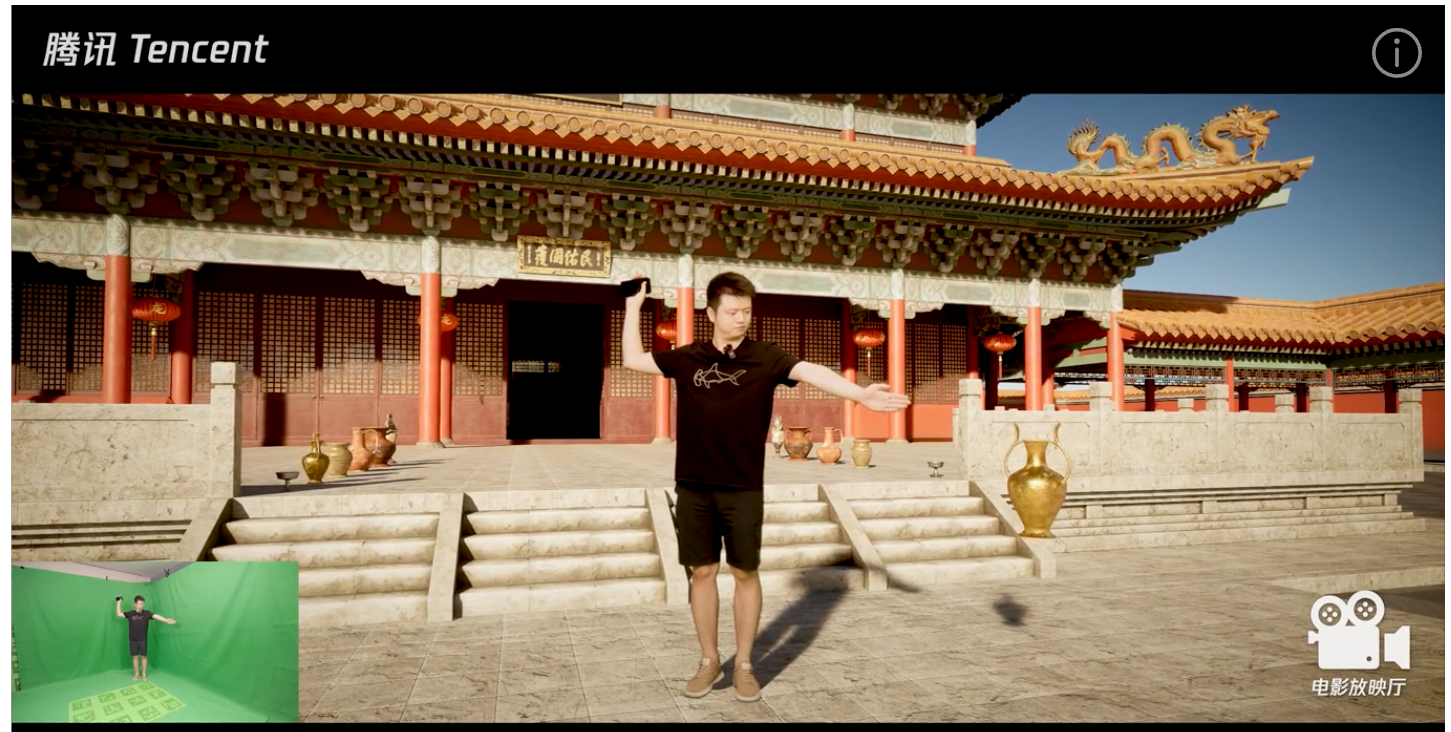
4. 360-degree panoramic backgrounds, then AI merges people with virtual scenes.
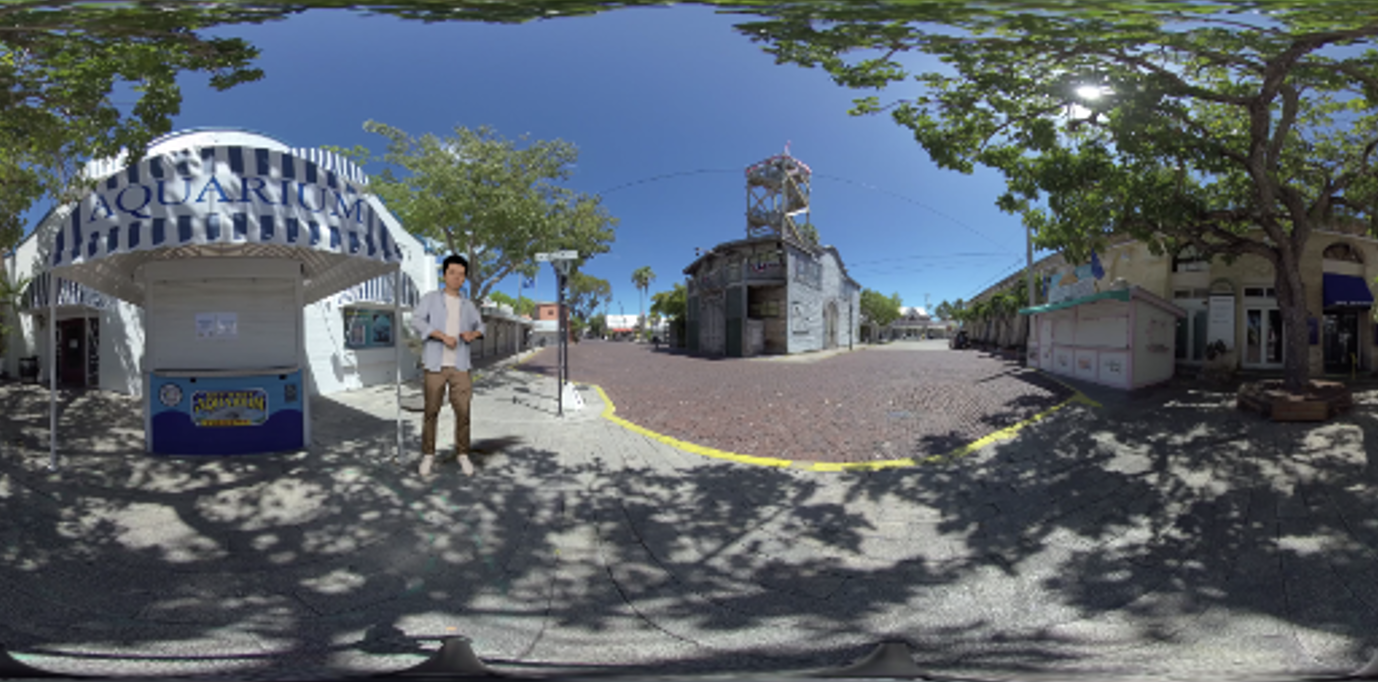
5. AI matting technology creates scenes with real people and virtual backgrounds without the need for a green screen.

6. People from different locations can be rendered in virtual scenes and interact with each other.
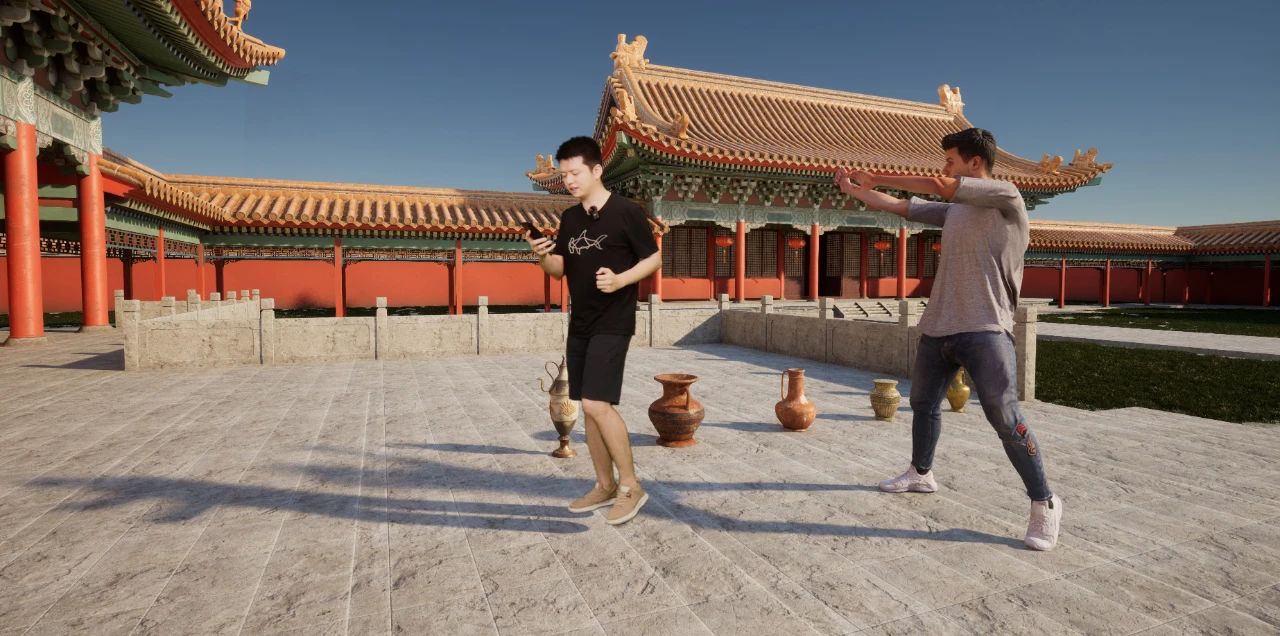
Four Applications of Tencent’s MR Technology
Tencent's MR technology can revolutionize the production of traditional and virtual reality videos, as well as create immersive virtual live rooms. With the help of cutting-edge technologies such as 3D engines, cloud rendering, image-style tracking, and virtual-reality interaction, you can integrate people into virtual scenes seamlessly to enhance the viewing experience of videos and streamline their production. Our self-developed algorithm drastically reduces the deployment cost and complexity of live-broadcasting set-up, allowing both companies and individuals to achieve high-quality and cost-effective production.
1. Explore tourist attractions with your digital avatar
Whether it’s a country park or a historic landmark, visitors can choose to explore offline attractions at their own pace with a digital avatar acting as their tour guide. The motion-capture software will allow visitors to create their own tour guide.
To activate the digital human guide, visitors simply scan a QR code at key locations around the attractions. They can then interact with it on a digital screen just as they would with a human tour guide, asking questions, seeking information, and obtaining directions.
2. Travel anytime through livestreaming
Scenic attractions and heritage sites will be recorded around the clock and broadcast live in an uninterrupted stream via the cloud. A virtual tour guide will provide commentary at any time to online visitors. This feature can be used as a creative marketing tactic to promote the attraction as well as encourage people to visit the site in person.
3. Immersive experience with cultural sites and relics
Tourists can integrate themselves into the virtual world and interact with cultural relics and virtual humans using a camera or smartphone. By applying MR technology, AI and advanced background matting solutions, anything from a large-scale scene to an intricate artwork can be recreated without green screens. Visitors can get close to and examine the cultural relics in detail , giving new life to artifacts that are precious or fragile and are otherwise at risk of damage.
4. Put on a show starring a combination of real and digital humans
Overcome spatial and resource limitations and host a launch event or celebration with digital avatars sharing the stage with a physical one. Tencent’s MR technology lets you create various backgrounds, whether it’s a television studio, conference hall, or outdoor stadium. Real-life presenters can then take to the stage and perform with their virtual avatar counterparts.
A World of Possibilities
Such simple yet professional technologies open a world of marketing possibilities for smaller museums and tourist venues. Whether it’s offering previews before visit or integrated virtual and real navigation, artwork exhibitions, and restoration of cultural relics and historic sites, the virtual world is increasingly fused with real life in innovative ways.

- Tencent Careers
- Campus Recruitment
- Global Recruitment
- Customer Services
- Partnership
- Procurement
- Media & Investors
Legal Information
- Service Agreement
- Privacy Policy
- Intellectual Property Rights

- Legal Statement
- Integrity Policy
- 粤网文【2017】6138-1456号
- 粤B2-20090059
- 粤公网安备 44030502008569号
粤网文【2017】6138-1456号 粤B2-20090059 粤公网安备 44030502008569号 Copyright © 1998 - 2024 Tencent. All Rights Reserved. 腾讯公司 版权所有
欢迎来到Tencent.com!
我们希望使用分析型Cookies和类似技术 (“Cookies”) 来改善我们的网站。 Cookies收集的信息不会识别您个人。有关我们使用的Cookies的类型以及您的偏好选项(包括如何更改您的偏好设置)的更多信息,请查看此处的 Cookies政策 。
歡迎來到Tencent.com!
我們希望使用分析型Cookies和類似技術 (“Cookies”) 來改善我們的網站。 Cookies收集的信息不會識別您個人。有關我們使用的Cookies的類型以及您的偏好選項(包括如何更改您的偏好設置)的更多信息,請查看此處的 Cookies政策 。
Welcome to Tencent.com!
We would like to use analytics cookies and other similar tracking technologies (“Cookies”) to help us improve our website. The Cookies collect information in a way that does not directly identify anyone. For more information about the Cookies we use and your options (including how to change your preferences), see our cookies policy here .
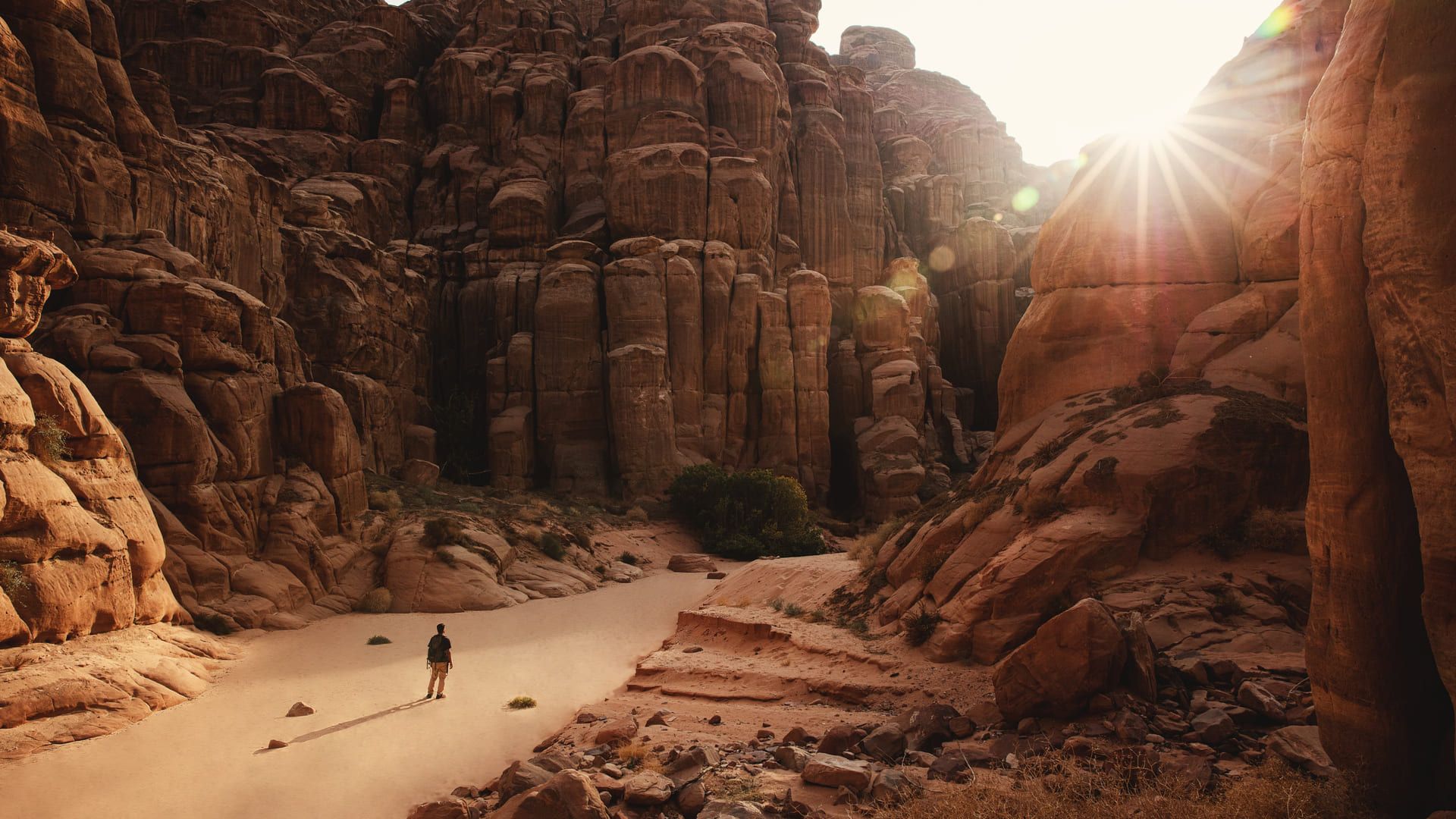
Changing the Future of Tourism
- Our Business
NEOM is the world’s most ambitious tourism project. Built on an ancient land, enhanced by world-leading design, immersive digital experiences and seamless travel, it will reshape the possibilities of global travel. Nurturing raw, untouched landscapes and spectacular coastal waters, this will be a new model for measurably regenerative tourism, and a destination like no other.
Coming soon
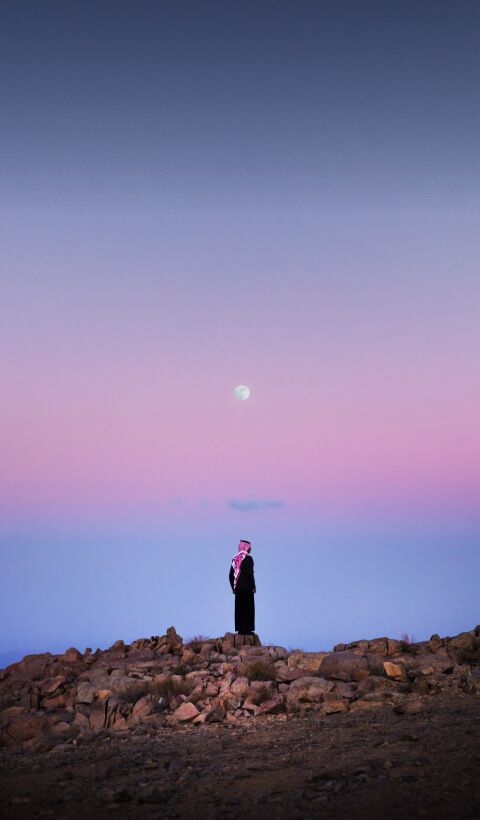
NEOM is a land that few have seen - untrod, untracked, unswum and ready to be explored by intrepid travelers with an appetite for adventure.
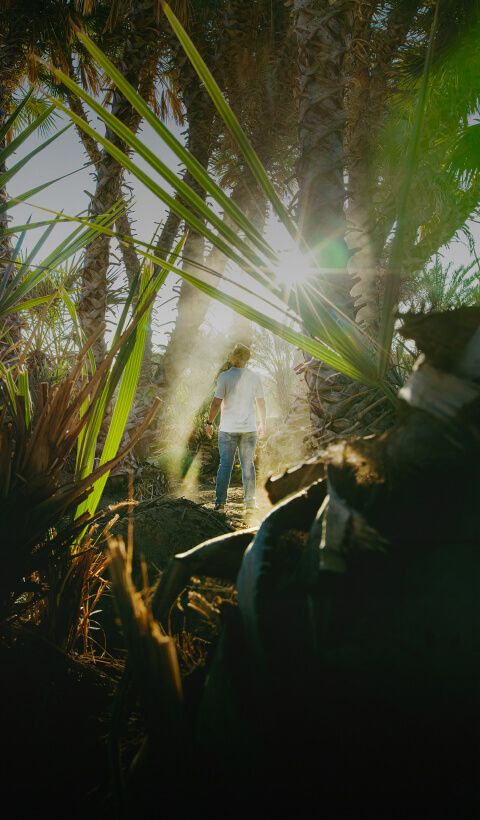
From the mountains of Trojena and the futuristic city of THE LINE to the luxury island Sindalah and the stunning Red Sea coast, NEOM is home to a plethora of destinations that will cater to every traveler.
Future destinations
Trojena’s mountain elevations range from 1,500m to 2,600m and cover an area of nearly 60 square kilometers. The area’s climate is also cooler than the rest of the region and in winter it transforms into a snowy wonderland.
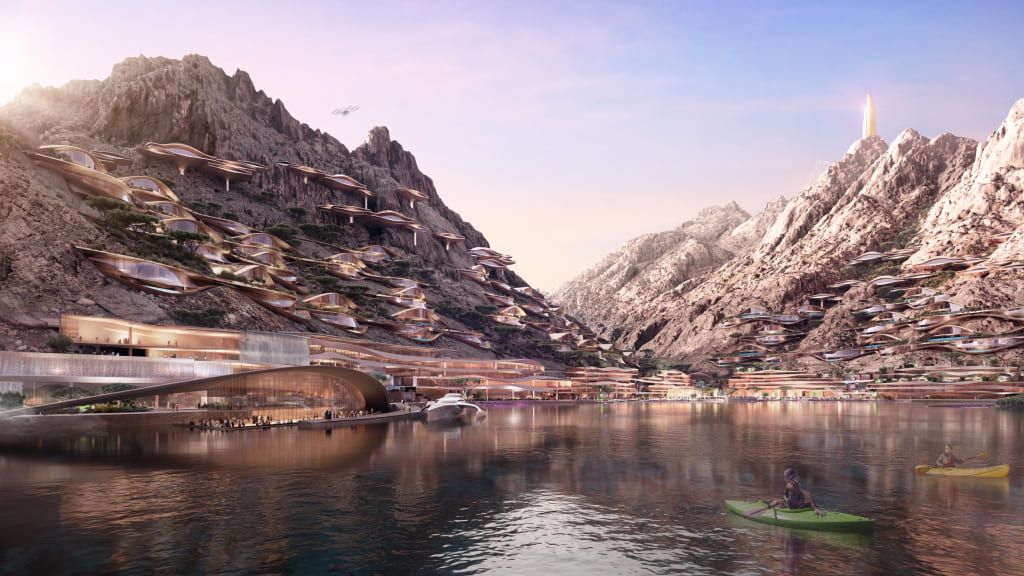
A place where people, industries and technology all come together in harmony with nature, Oxagon offers unparalleled connectivity to global markets and exceptional livability, all powered by 100% clean energy.
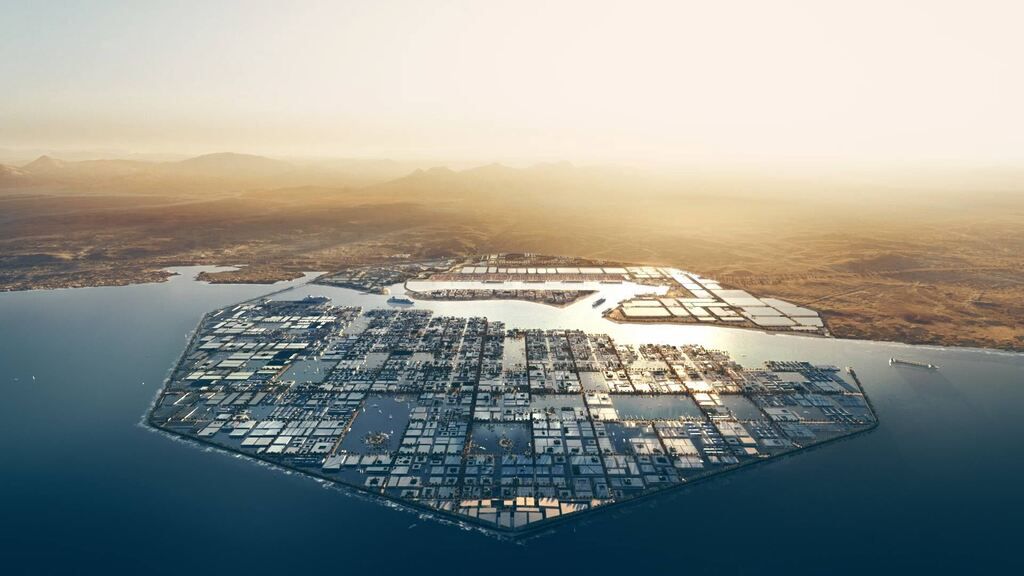
At just 200 meters wide, but 170 km long and 500 meters above sea level, THE LINE prioritizes health and wellbeing. It offers the perfect year-round climate thanks to an optimal balance of sunlight, shade and natural ventilation.
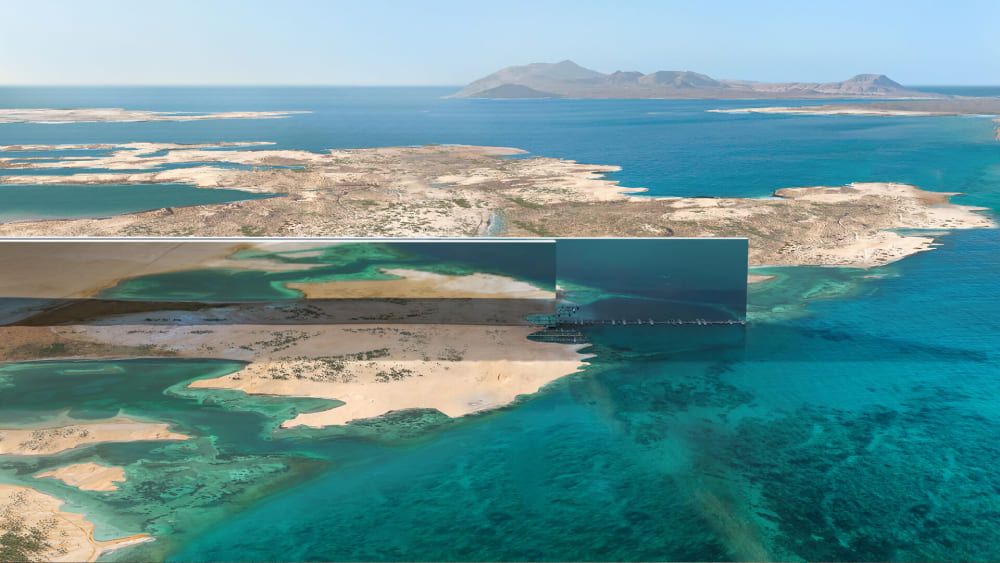
An incomparable island destination with unmissable experiences above and below the water, Sindalah is a year-round luxury destination, thanks to its stunning climate and great connectivity to the nearby Mediterranean.
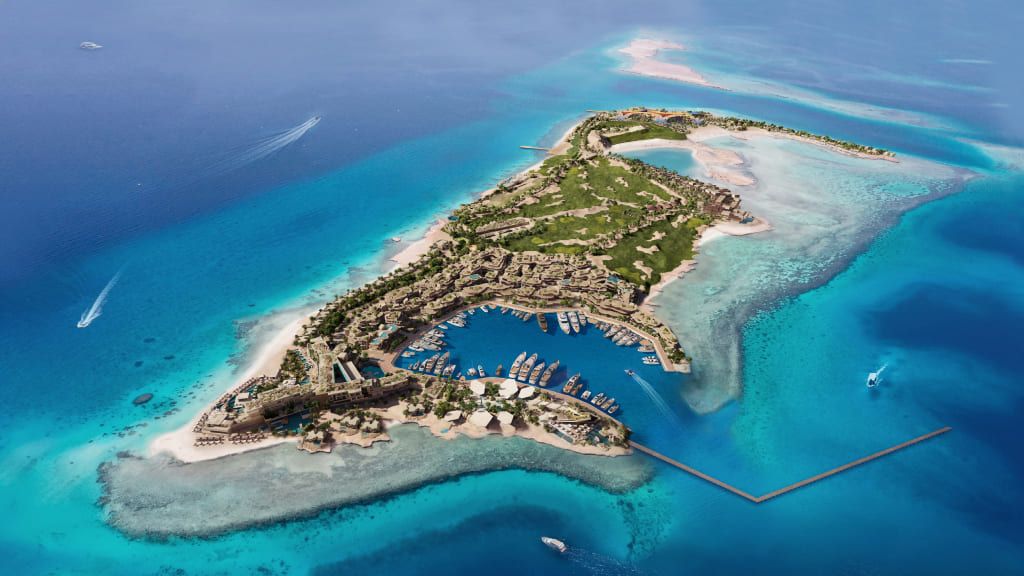
Islands of NEOM
The vibrant waters of NEOM are home to some of the most picturesque and pristine islands in the Red Sea. From the jagged majesty of Yuba to the serenity of Sindalah, they all offer stunning beaches, diverse landscapes and rare wildlife.
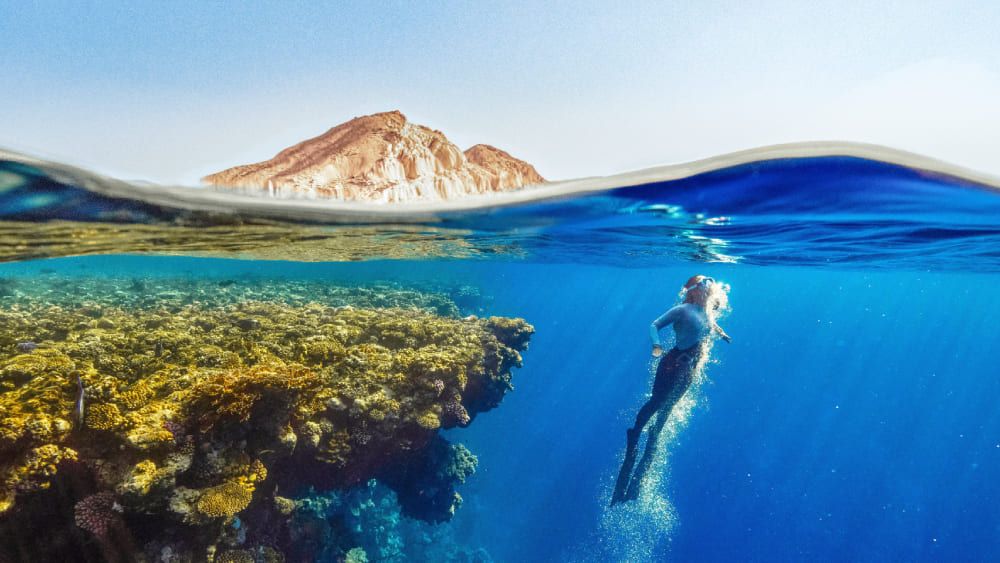
Hisma Desert
Amongst expansive red sands and spectacular sandstone rock formations, the Hismah Desert offers a tangible link to the beginnings of humanity. The rocks tell stories in the form of ancient artworks, left by our ancestors millennia ago.
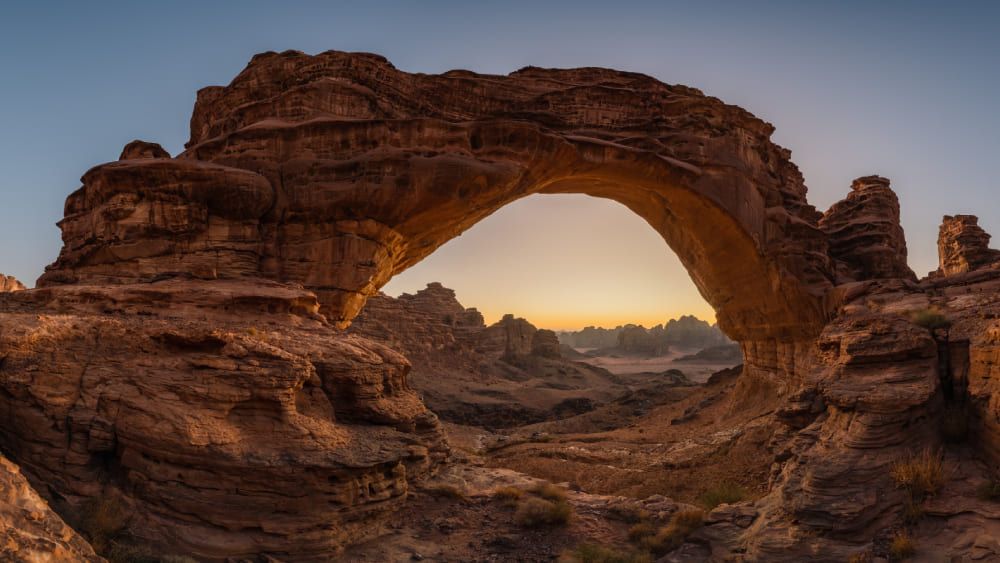
Midian Tombs
Carved into the mountains surrounding Al-Bad’, the Midian Tombs are the last remnants of the ancient land of Midian, believed to date back to the 12th century. Midian was also once home to the Prophet Moses, peace be upon him.
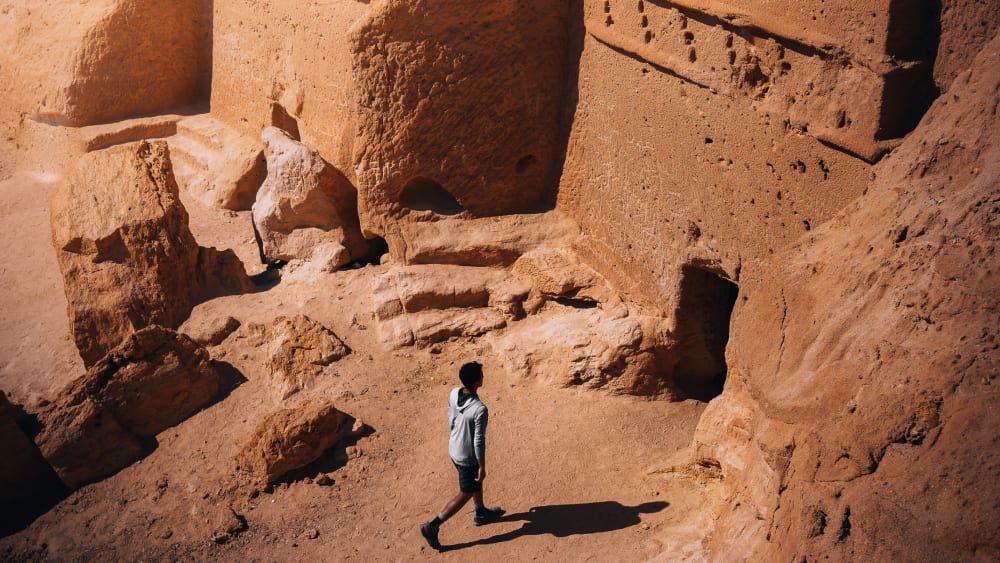
Wildlife Reserve
A serene and secluded natural habitat full of diverse wildlife – with high-end resorts situated near to untouched heritage sites. A pristine environment combines digital activations with augmented reality features.
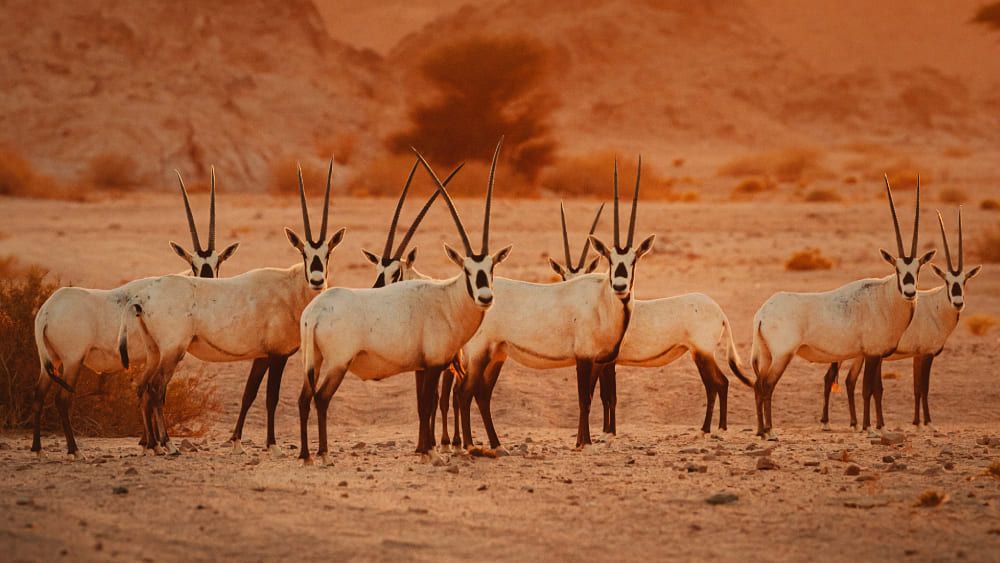
Use gestures to explore future destinations
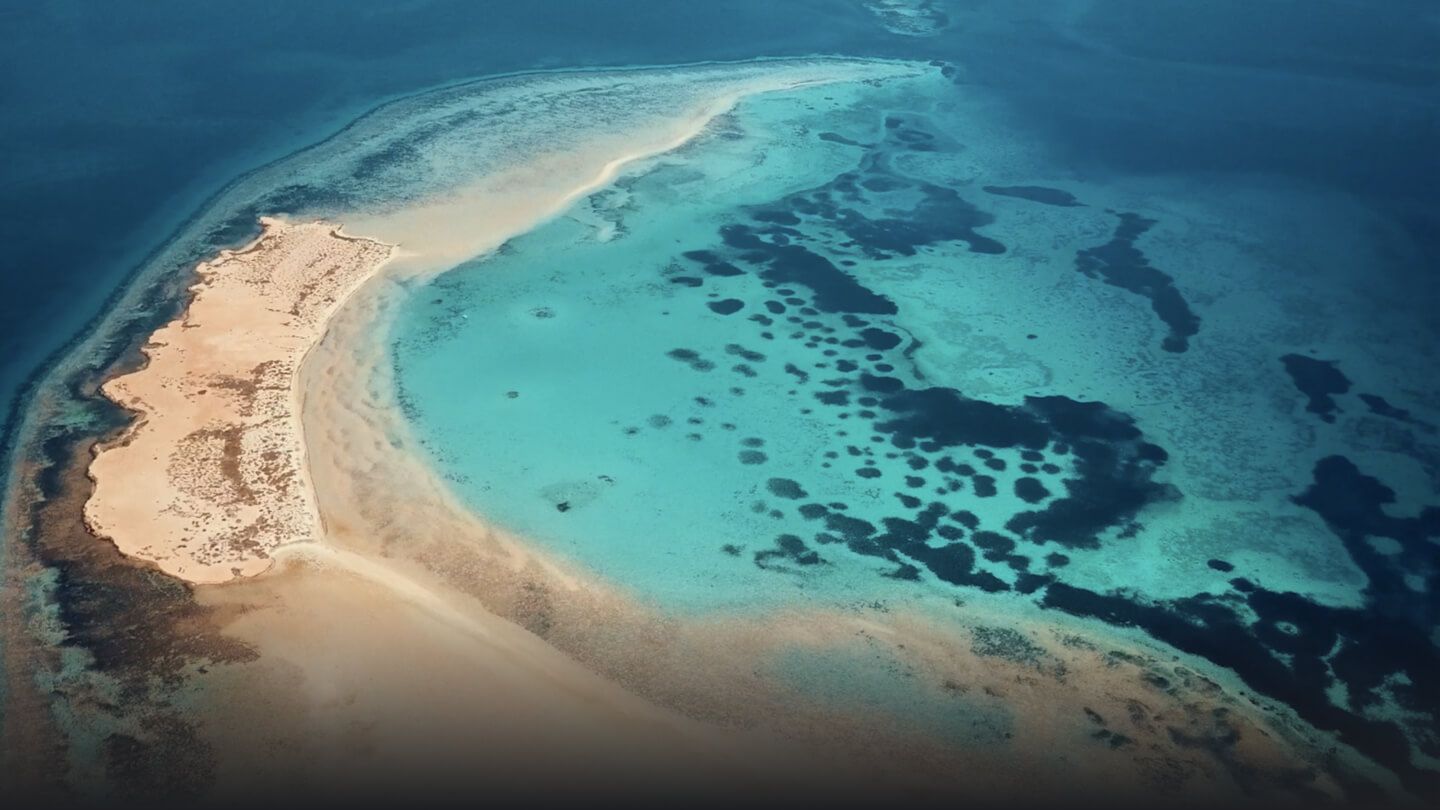
Capturing the moment with Getty Images
NEOM has partnered with Getty Images and Unsplash to create an extensive visual library, offering a sneak peek into the region’s diverse natural environments. Images capture the stunning beauty of NEOM’s biodiversity, from pristine coastline to majestic deserts and towering mountains.
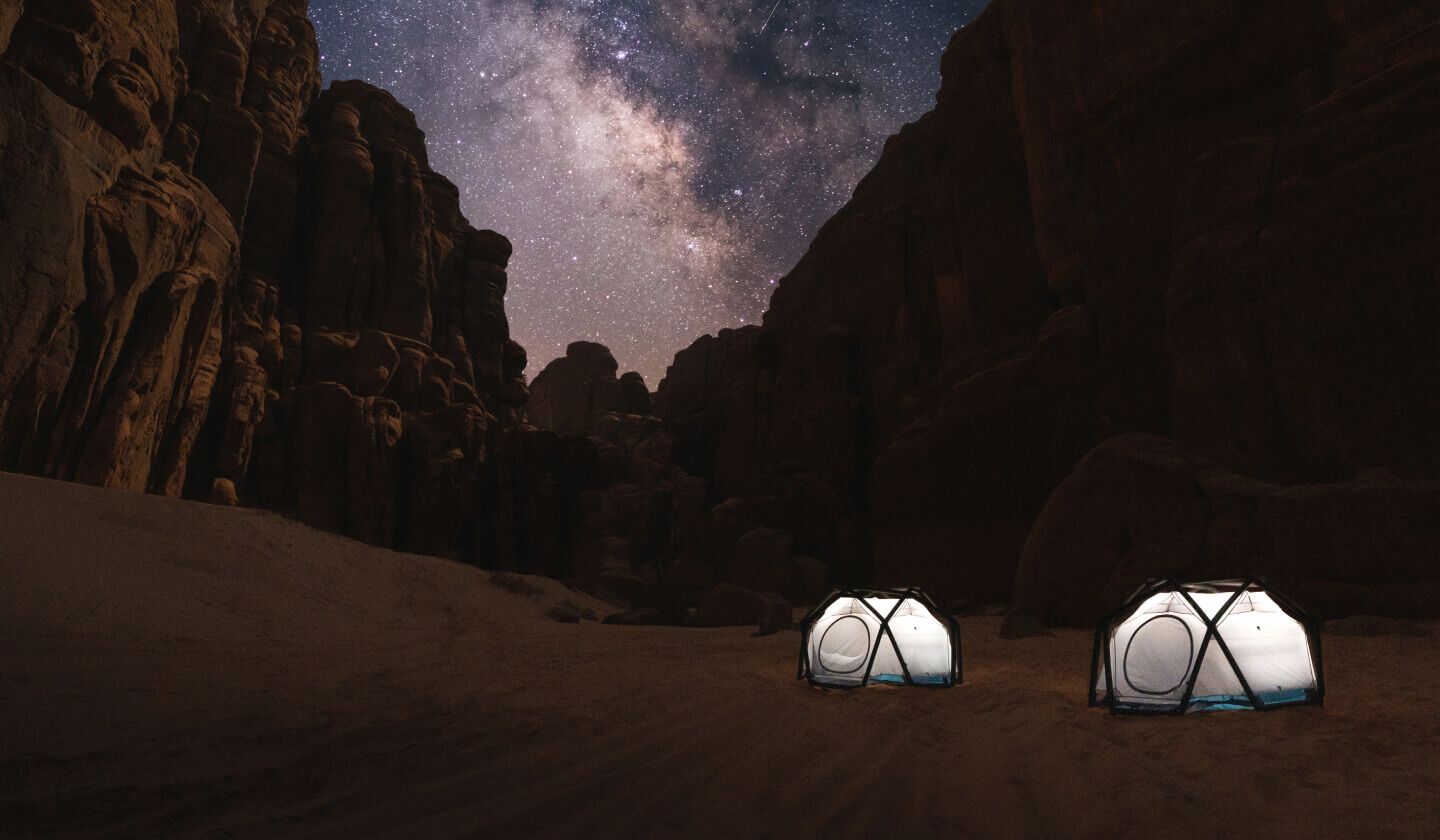
This is NEOM
Experience the extraordinary
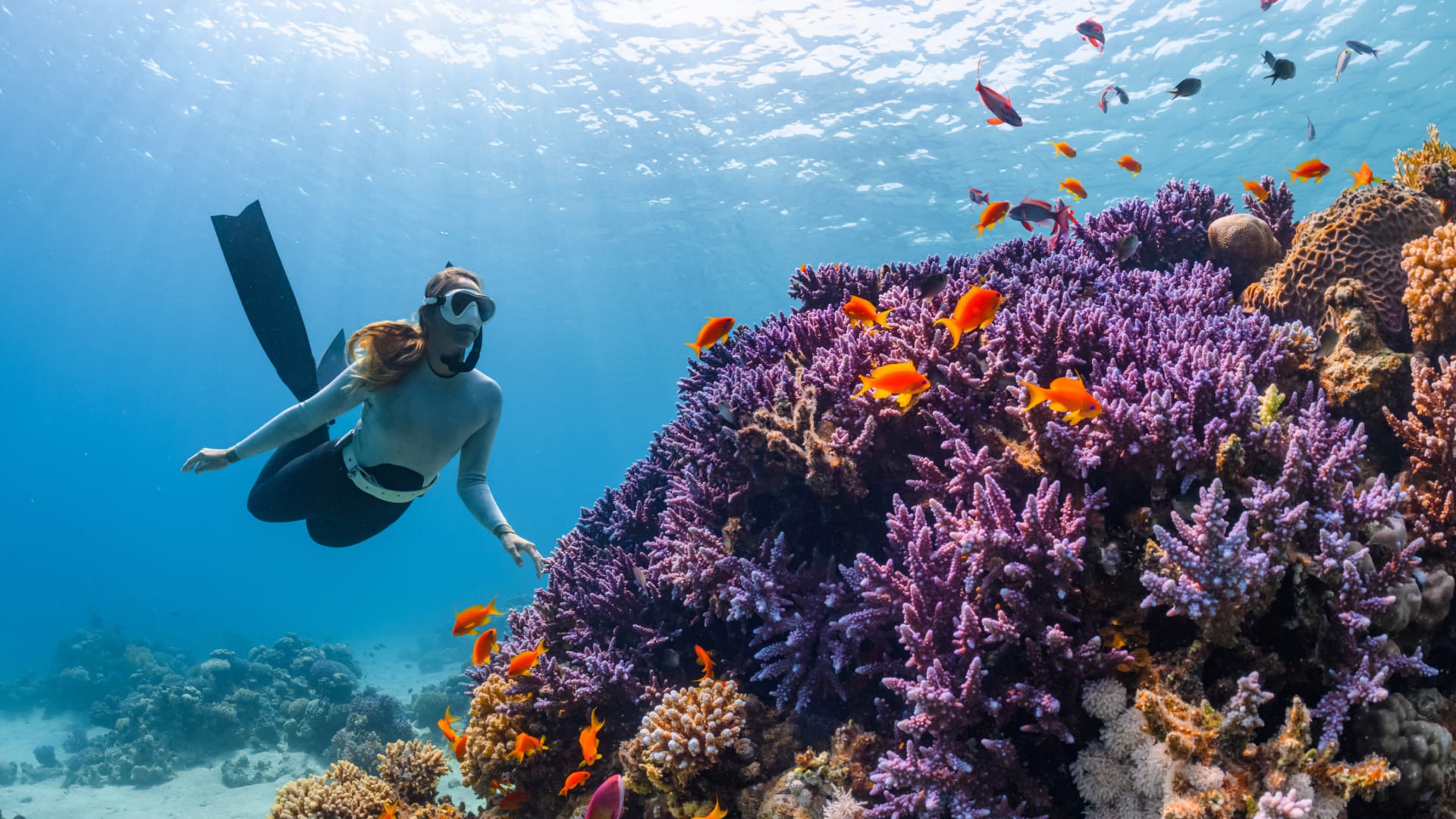
Dive into pristine waters
Find a world of biodiversity

Explore stunning scenery
Home to otherworldly landscapes
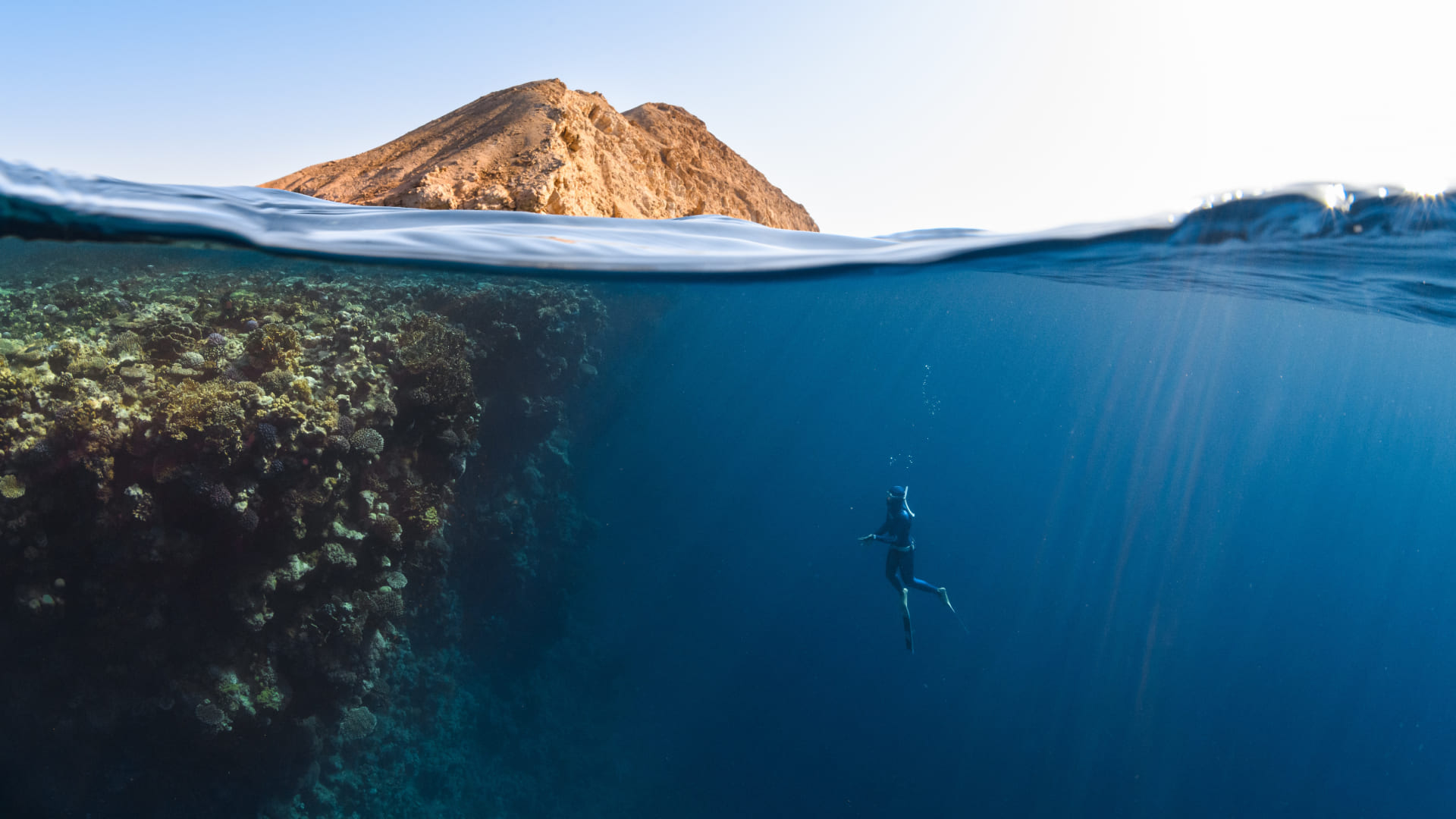
Traverse untouched coastline
A Red Sea paradise
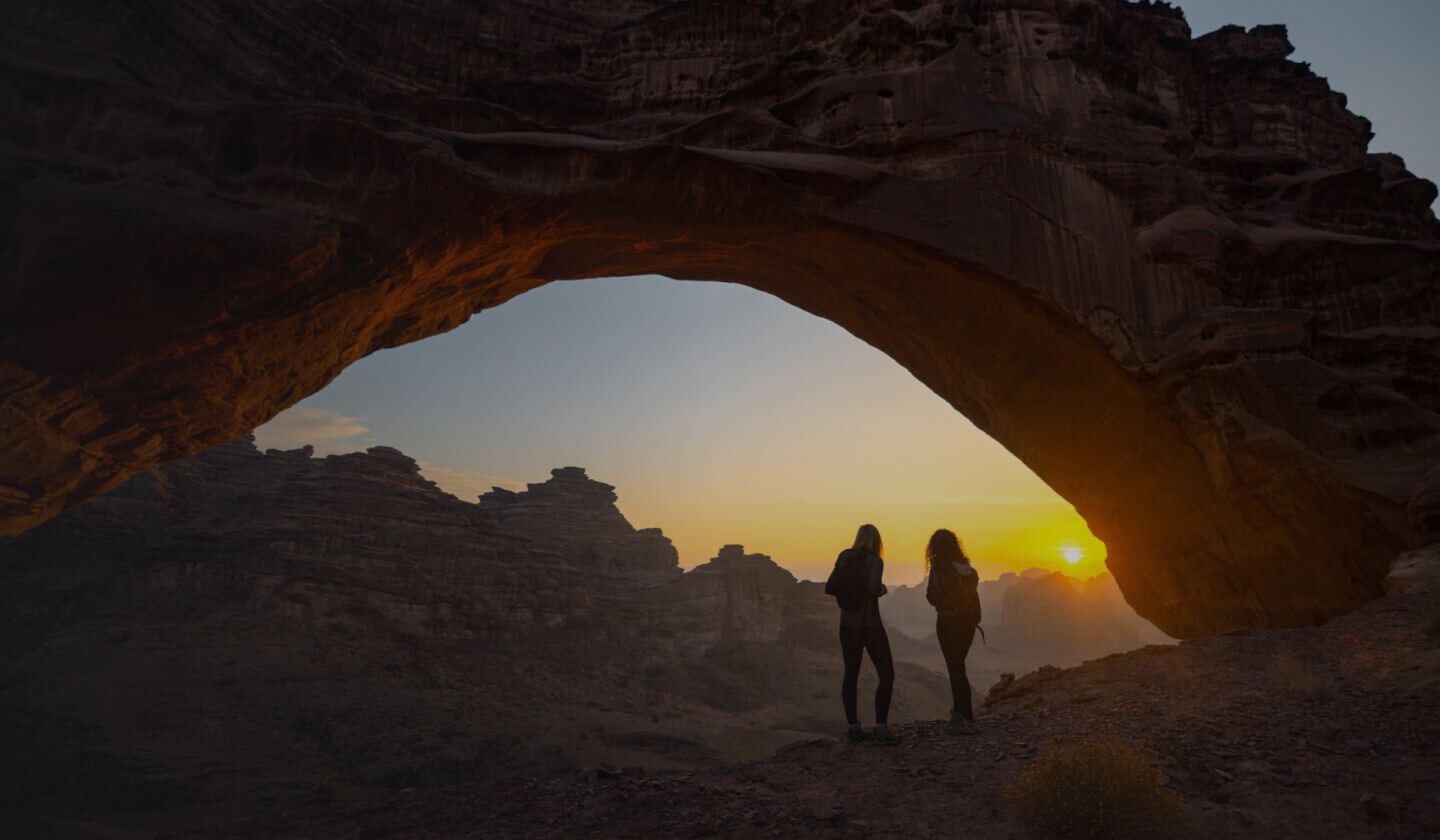
Discover jaw-dropping scenery

Unlock new adventures
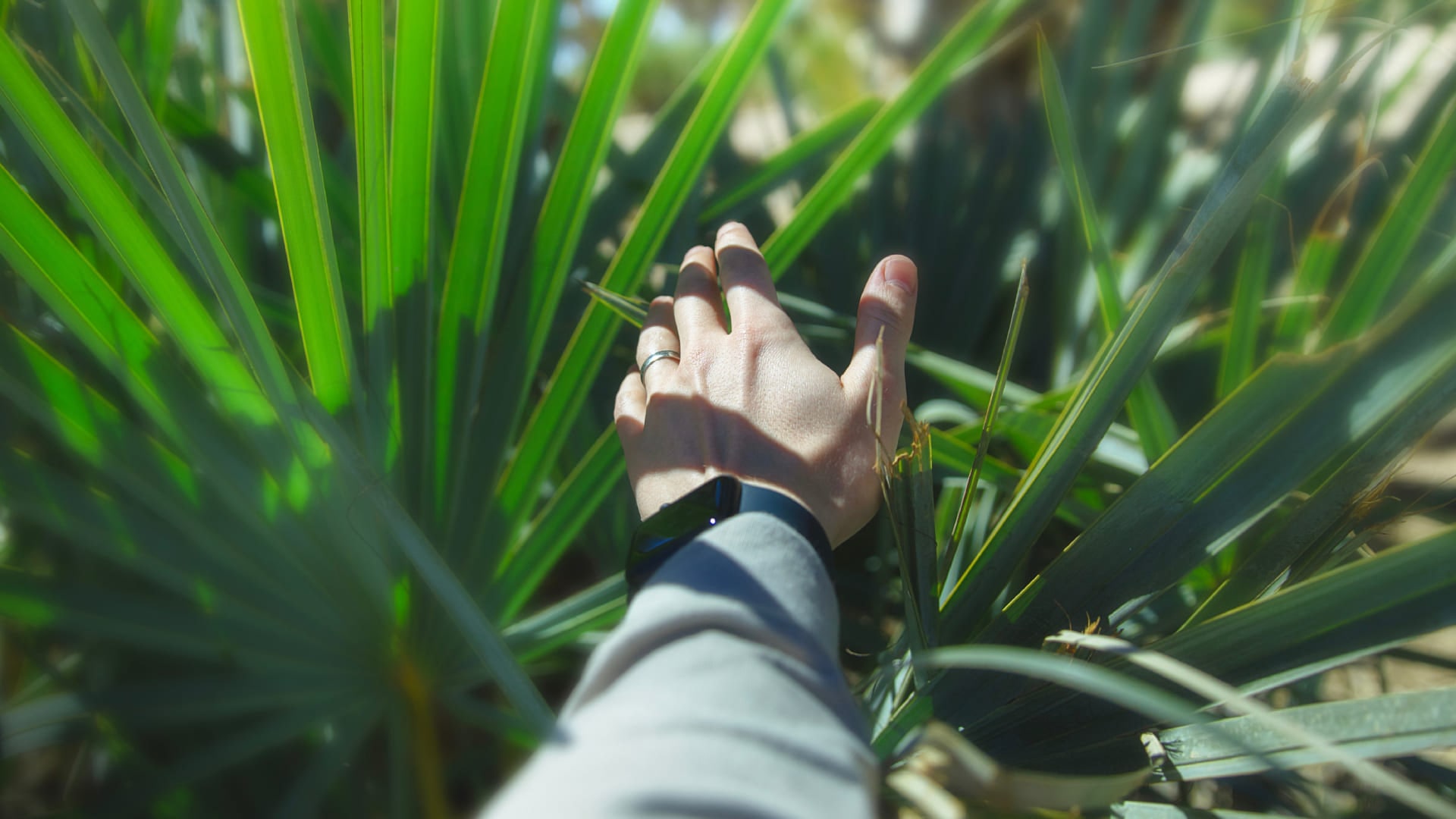
A world of infinite horizons
Immerse yourself in majestic nature

An undiscovered destination
Escape to tranquil dunescapes
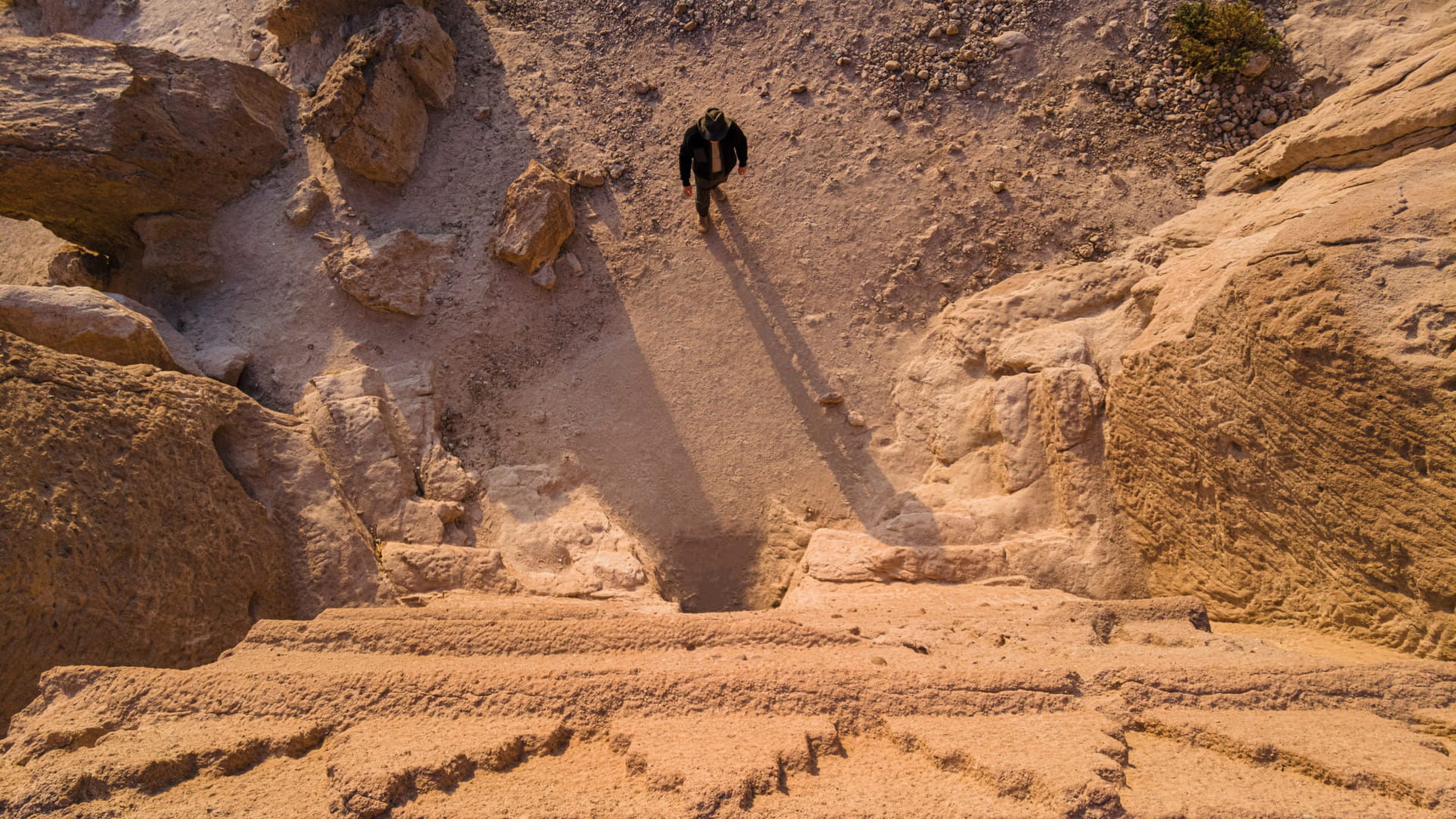
An odyssey to remember
Uncover a whole new region

The NEOM tourism team is committed to building strong relationships and working in partnership with the global travel trade.

Niall Gibbons
Tourism Managing Director
Niall Gibbons has more than 20 years of experience in the industry, including 14 years as Tourism Ireland chief executive, promoting Ireland as a destination for international visitors. He is a fellow of the Institute of Chartered Accountants and a business graduate of Trinity College Dublin.

Marwa Almadani
Heritage Director
Marwa Almadani has more than 16 years of experience spanning the development of learning experiences, engagement strategies and in delivering key projects for institutions in the Kingdom of Saudi Arabia.

Bridget Woods
Destination Development Director
With more than 25 years of experience in hospitality and tourism, Bridget Woods has extensive knowledge across all facets of the industry – including asset development, adventure and nature-based touring, as well as heritage and tech-enabled experience development and aviation attraction.

Survey and Excavations Sr. Manager
With 25 years of experience, Jamal Omar has served in roles at the Saudi Commission for Tourism and National Heritage – as director general of research center and director general of the National Museum and vice-president for National Heritage. At NEOM, he oversees all surveys and excavation work.

Natasha Martin
Innovation and Engagement Senior Manager
Natasha Martin has 15 years' experience working with early-stage destinations around the world, from Nepal to Nicaragua. Her expertise is in strategy planning, product development and tourism marketing.

Jesse Desjardins
Marketing Senior Manager
With experience in the private and public sectors, Jesse Desjardins has worked with leading destination and experience products across Australia, Asia and the Middle East. At NEOM, he leads consumer tourism marketing efforts, focused on delivering large-scale global partnerships and media projects.
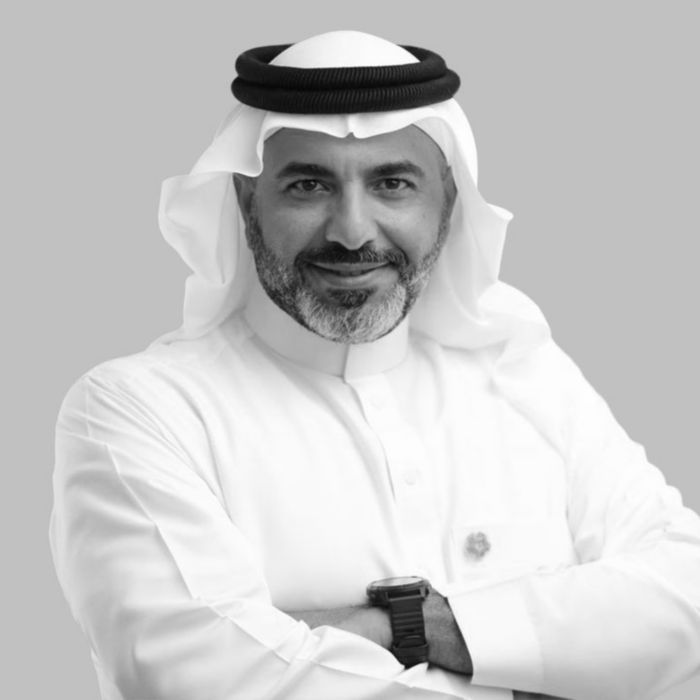
Abdulaziz Al Sanousi
Cultural Tourism Sr. Manager
With more than 22 years of experience in tourism, Abdulaziz Al Sanousi has worked as a tour guide, consultant, manager and innovator. At NEOM, he leads the development of stories and narratives designed to enrich each visitor's experience.

Jeff McLucas
Sr. Project Manager
Jeff McLucas has 35 years' experience working on the design and construction of hotels and airports. His expertise is in construction management and project management. At NEOM, he leads the development of meetings, incentives, conferences and exhibitions.

Francine Stevens
Digital Services Sr. Manager
With more than 25 years of experience in telecommunications and technology, Francine Stevens has expertise in digital innovation, service design and technology solutions. At NEOM, she is leading innovation in digital services and the product design of photography safaris.

Naif Alharbi
Tourism Business Manager
Managing the business side of the Tourism sector, Naif Alharbi's duties include a range of operational, administrative and financial functions – as well as collaboration with a wide range of internal and external stakeholders, agencies and government entities.

Athanas Jamo
Research and Insights Manager
With 15 years of strategic marketing experience in Europe and the Middle East, Athanas Jamo leads the research and insights function for the Tourism sector. His objective is to place NEOM at the forefront of global industry trends and strengthen destination competitiveness.

Ross Walsby
Tourism Development Manager
Ross Walsby has 15 years of experience working both client-side and as a consultant in the development and delivery sector. As a chartered surveyor – he is experienced in strategic briefs, design management, tendering and procurement, contract negotiation and contract administration.

Rusudan Mamatsashvili
Regulation and Planning Manager
Rusudan Mamatsashvili has 15 years of experience in the Tourism sector, working in public and private sectors – as well as academia. Previously holding the position of first deputy head at the Georgian Tourism Board, she aims to create an enabling environment for business growth.

Cherith Speers
Tourism Events Lead
Cherith Speers has more than 15 years of international events experience. In her role at NEOM, she leads events for the Tourism sector – including tradeshows, trips and experiential activations.

Planning Specialist
After graduating from Adelphi University in New York, Enas Asiri completed a placement at the prestigious Ritz Carlton in Jeddah - before joining NEOM. Working in the tourism planning department, she supports efforts to create a sustainable and enabling environment for development.

Trade Specialist
Joe Booty has a decade of experience in the hospitality and tourism fields – specifically in the development of mountain and ski experiences. At NEOM, he works to build relationships with key trade operators and their clients.

Anas Anajlan
Project Manager
A strategy manager with eight years of experience managing projects across the globe, Anas Alajlan's expertise includes project delivery, strategic growth and transformation. In his role at NEOM, he is responsible for strategy design and execution.
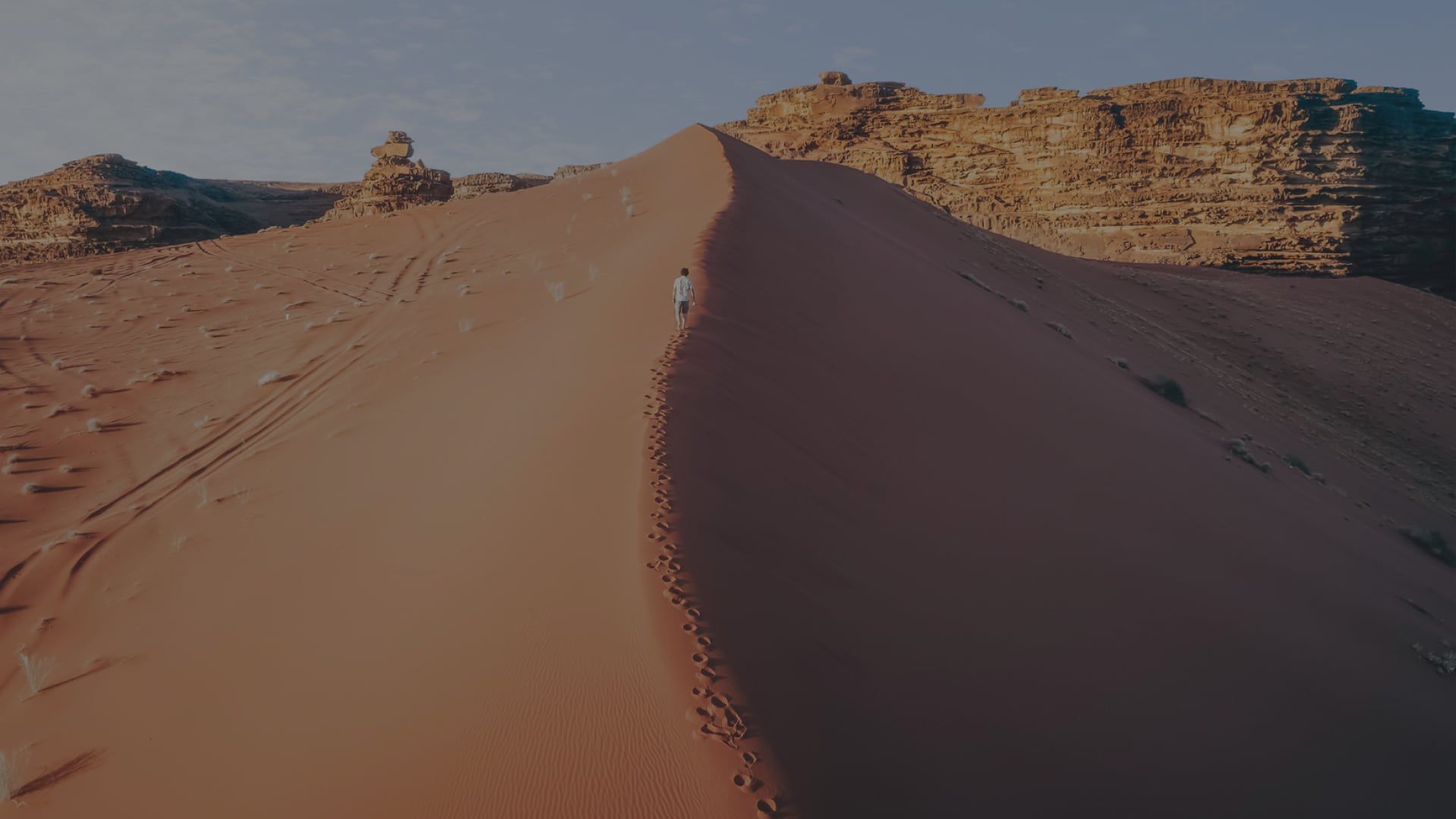
A new model for protection, preservation & regeneration
Tourists, residents and wildlife will benefit from our regreening and rewilding model - with 95% of NEOM’s land protected for nature.

The request to the URL needs to be verified.
The request to the URL is paused, and must be verified for you to access it. This question is for testing whether you are a human visitor, and to prevent automated spam submission.
What code is in the image submit
Incident ID: 14604593417030998648
For comments and questions: [email protected]

Sustainable Development
For people and planet.
Tourism is both highly vulnerable to climate change while at the same time contributing to it. Threats to the sector are diverse, including direct and indirect impacts such as more extreme weather events, pollution, water shortages, biodiversity loss and damage to assets and attractions at destinations, among others. Accelerating climate action in tourism is therefore of utmost importance for the resilience of the sector.
The green transformation of the tourism sector is needed, not just for the planet, but also for tourism itself, for boosting competitiveness and increasing resilience.
To mark World Environment Day 2020, the One Planet Sustainable Tourism Programme , which is led by UNWTO, announced its new vision for global tourism– growing better, stronger, and balancing the needs of people, planet and prosperity. The One Planet Vision for the Responsible Recovery of the Tourism Sector is structured around six lines of action to guide responsible tourism recovery for people, planet and prosperity, namely public health, social inclusion, biodiversity conservation, climate action, circular economy and governance and finance.
UNWTO also focuses on the fight against plastic pollution while effectively facing the public health and hygiene challenges of the COVID-19 pandemic. The Global Tourism Plastics Initiative, led by UNWTO , the United Nations Environment Programme (UNEP) and in collaboration with the Ellen MacArthur Foundation, published the Recommendations for the Tourism Sector to Continue Taking Action on Plastic Pollution during COVID-19 Recovery illustrating how reducing the plastic footprint, increasing the engagement of suppliers, working closer with waste service providers, and ensuring transparency on the actions taken, can significantly contribute to the responsible recovery of the tourism sector.
From 93 companies and organizations, a further 32 signatories were welcomed on board during 2021 and 2022 , among them TUI Group, Palladium Hotel Group, Sustainable Hospitality Alliance, Hostelling International, Thompson Okanagan Tourism Association and Visit Valencia. To mark the confirmation of the new signatories, UNWTO and the United Nations Environment Programme, in conjunction with the Ellen MacArthur Foundation, held a special panel discussion with the theme Eliminate. Innovate. Circulate. Strategies from the Global Tourism Plastics Initiative.
Another key initiative designed by UNWTO is International Network of Sustainable Tourism Observatories (INSTO), a network of tourism observatories monitoring the economic, environmental, and social impact of tourism at the destination level. The initiative is based on UNWTO’s long-standing commitment to the sustainable and resilient growth of the sector through measurement and monitoring, supporting the evidence-based management of tourism. Since its establishment in 2004, as of September 2022, a total of 33 observatories have joined the UNWTO INSTO network, including five that joined during the pandemic, Mallorca, Barcelona, Yukon, and Bogotá and Malaga). The INSTO observatories are required to monitor 11 mandatory issue areas : tourism seasonality, employment; destination economic benefits; energy management; water management; waste (sewage) management; solid waste management; climate action; accessibility; local satisfaction; and governance.
Glasgow Declaration: A Commitment to a Decade of Climate Action in Tourism
The UN Climate Change Conference (COP26) (4 November 2021, Glasgow, Scotland)
UNWTO served as the voice of tourism at the UN Climate Change Conference (COP26) (4 November 2021, Glasgow, Scotland), launching the Glasgow Declaration on Climate Action in Tourism geared to commit the tourism sector to take strong to reduce emissions by at least half over the next decade and to reach net zero emissions as soon as possible before 2050.
The " Glasgow Declaration: A Commitment to a Decade of Climate Action in Tourism " sets out a clear and coherent sector-wide message and approach to climate action over the next decade, in line with the broader scientific framework and the urgency to act now.
The commitments that the Glasgow Declaration proposes to its signatories are:
- Support the global commitment to at least halve emissions by 2030 and reach zero by 2050. o Deliver climate action plans within 12 months of signing up (or updating existing plans) and implement them.
- Publicly report on targets on an annual basis.
- Align with 5 shared pathways to accelerate tourism's transformative capacity. These are: measure, decarbonise, regenerate, collaborate and finance.
- Work in a spirit of collaboration, share good practices and solutions, and disseminate information.
Up to September 2022 more than 600 signatories had committed to the Declaration , including many important players such as the World Travel and Tourism Council (WTTC), leading global Hotel group., Accor, the Pacific Asia Travel Association (PATA), as well as Booking, Expedia, Intrepid and others.
“The historic deal is the beginning of decarbonization the world via tourism. Our main four pillars to enforce the declaration will be to measure, decarbonize, regenerate, and unlock innovative financing. This is the initial start, and we will work to attract more private companies. When there is a crisis, there is always an opportunity to invest, learn, and develop sustainably.” - UNWTO Secretary-General Zurab Pololikashvili.
Innovation and Digital Transformation
From the very start of the current leadership mandate, in 2018, UNWTO has emphasized the importance of embracing and investing in new ideas. A new department was created in the Organization to deliver on the potential of innovation through promoting entrepreneurship, recognizing leading innovators and providing them with the practical and financial support they need to turn ideas into action.
To anticipate, address and overcome the new challenges and trends of the tourism sector, UNWTO is currently focused on a strategy on Innovation, Education, Digital Transformation, and Investments. The UNWTO Innovation Network works to promote exchange of knowledge among actors and change-makers with the objective of contributing to the promotion of the United Nations Sustainable Development Goals.
The enormous Interest in UNWTO’s innovation ecosystem and start-up competitions keeps growing, showcasing the talent unleashed and our shared readiness to hear new voices and embrace new ideas. Up to September 2022, the UNWTO global innovation ecosystem counts on than 12,000 start-ups from 160 countries, with US$83 million mobilized and 300 corporate partners working on new tourism technologies.
Tourism for Investments and Entrepreneurship
Entrepreneurship in tourism is built on collaboration between governments, academia, corporations, micro, small and medium enterprises (MSMEs) and start-ups, as well as investors, supporting business partners and other stakeholders. Restarting tourism is unthinkable without investments that boost economic growth, job creation and sustainability.
UNWTO is collaborating with institutions including the World Bank’s International Finance Corporation and the Inter-American Development Bank. These partnerships have attracted more than 200 investors as part of UNWTO’s global investment network , advancing critical work such as supporting hotel chains from 50 countries in becoming more sustainable.
In 2022, for the third consecutive year, UNWTO partnered with FDI intelligence from the Financial Times to develop a joint publication on Tourism Foreign Direct Investments (FDI) , analysing data on Greenfield investments trends. Using both data from fDi Markets and UNWTO, the Tourism Investment Report 2022 found that while the tourism sector has been showing signs of recovery, foreign direct investment (FDI) into the sector remained low in 2021 and continued a downward trajectory in the first of 2022, outlining the key challenges as well as highlighting the sector’s biggest investors.
To further the partnership to grow green investments in the tourism sector, UNWTO and the International Finance Corporation (IFC) launched the Green Investments for Sustainable Tourism. Seven countries participated in the pilot phase (India, Indonesia, Jamaica, Philippines, South Africa, Thailand, and Vietnam), and the initiative will continue to grow. Alongside this, a new UNWTO Investment Guidelines Series: Enabling Frameworks for Tourism Investment was launched to focus on investment opportunities in several key destinations .
Tourism for Gender Equality
UNWTO is committed to enhancing the positive impact of tourism on women’s lives, and, in so doing, contributing to the achievement of Sustainable Development Goal 5 – to "achieve gender equality and empower all women and girls". As a sector with a majority female workforce worldwide (54%) and most women in low-skilled or informal work, women have felt the economic shock to tourism caused by and the pandemic the hardest. As such, UNWTO produced a Series of Recommendations for an Inclusive Response to ensure that women are not left behind.
The UNWTO project ‘ Centre Stage: Women’s Empowerment During the COVID-19 Recovery ’, is designed to strengthen, coordinate and focus work on gender equality in tourism governmental institutions. It is currently being implemented with the support of the German Society for International Cooperation (GIZ), on behalf of the Federal Ministry for Economic Cooperation and Development of Germany and UN Women.
Through the Centre Stage project, UNWTO has supported four National Tourism Administrations, tourism businesses, NGOs and tourism organizations from Jordan, Costa Rica, the Dominican Republic, and Mexico, as they implement a one-year action plan for women’s empowerment. This included targeted training programmes, measures to boost female career progression, improvements to the legal framework and the collection of sex-disaggregated tourism employment data.
Other publications spearheaded by UNWTO include Gender Mainstreaming Guidelines for the Public Sector in Tourism and the Gender Inclusive Strategy for Tourism Businesses , a new set of guidelines addressing the needs of women in the tourism sector. These guidelines provide concrete recommendations for governments working to achieve the Sustainable Development Goals and the objectives of international women’s rights treaties such as relevant ILO Conventions and the Convention on the Elimination of all Forms of Discrimination Against Women (CEDAW).
Meanwhile, the Regional Report on Women in the Middle East maps the participation of women in the tourism sector across the region prior to the pandemic. In doing so, it assesses the contribution of tourism to advancing the United Nations Sustainable Development Goal 5. The report, compiled to mark the 2020 G20 Saudi Presidency, aims to inform further work on gender equality and equip stakeholders with tools they need to boost women's empowerment.
Tourism for Social Inclusion
According to WHO, 15% of the world’s population (1 billion people) live with some form of disability. Accessibility for all to tourism facilities, products, and services should be a central part of any responsible and sustainable tourism policy. Accessibility is not only about human rights. It is a business opportunity for destinations and companies to embrace all visitors and enhance their revenues.
Recovery should include accessibility as a central pillar in measures to improve destinations’ offer and competitiveness, contributing to inclusive environments, services, and employment.
UNWTO continues to build on its successful partnership with the Spanish ONCE Foundation and the European Network for Accessible Tourism (ENAT) . The joint work will continue to focus on the promotion of good practices during the current crisis, the application of standards , the measurement of accessible tourism, as well as labour inclusion and institutional disability inclusive policies. All three have contributed to the International Standardization Organization ( ISO Standards ) being the first global standard aimed at implementing and improving accessibility throughout the tourism value chain.
Launched on the 2020 International Day of Persons with Disabilities , the UNWTO Inclusive Recovery Guide Issue I: Persons with Disabilities, suggests measures for the whole tourism value chain to build back better, becoming more accessible and more competitive. Just as other guidelines on the UNWTO series, this document will continue to be updated.

Tourism for Youth Development
Young people are disproportionately impacted by interlinked global crises, from climate change to conflicts to persistent poverty. The COVID-19 pandemic has exacerbated these fragilities and has put youth in the spotlight, particularly given the potential social and economic consequences for this demographic, both in emerging and mature destinations.
Youth development and engagement are cross-cutting issues in the 2030 Agenda for Sustainable Development , and they can be a powerful catalyst to advance the contribution of tourism particularly for Goal 8 on economic growth and jobs, and Goal 12 on sustainable consumption and production as they can lead a transformation into a more responsible way of traveling. As the leaders of tomorrow, it is pivotal that young people become involved in shaping the global vision for the future.
UNWTO recognises youth as the present and future of the sector introduced several youth centred initiatives. Amongst them is the UNWTO Students League . The league is an innovative 360º competition for students that fosters talent development, Bridges the gap between studies and the realities of the sector and produces solutions for the Challenges of the Sector aligned with the SDGs.
Also placing young people at the centre of tourism’s future is the Global Youth Tourism Summit (GYTS) , the first edition was held on 29 June-July 2, 2022, in Sorrento, Italy, and welcomed more than 120 young delegates from more than 61 countries, alongside UNWTO Ambassadors for Tourism drawn from the worlds of sport, business and gastronomy. The event included a series of international events, workshops, and other educational initiatives, that will give children and youth a unique platform to share and discuss ideas and shape their visions for the future of sustainable tourism within the 2030 Agenda for Sustainable Development.
Out of the Summit, the Sorrento Call to Action offers a bold and ground-breaking vision for young people to be active participants in tourism’s restart and growth as a pillar of sustainable and inclusive development.
Protecting Culture and Heritage
UNWTO promotes resources aimed at strengthening the dialogue between tourism and culture, while also promoting the exchange of good practices showcasing inclusive management systems and innovative cultural tourism experiences.
Tourism and the audio-visual industry are natural bedfellows. Tourists connect directly with the sites where films and television series are made, which gives these places added value to support the sustainable development of the sector. UNWTO and Netflix have partnered on the publication of a report which looks at the role of film and series as drivers for tourism and cultural affinity. The Global Report on Cultural Affinity and Screen Tourism explores the growing affection one has towards a particular country or culture displayed on the screen.
Against this backdrop, the cultural expressions of Indigenous peoples feature among the most distinctive features of tourism destinations, making them relevant players within the sector. Despite their global significance, Indigenous peoples have historically been among the most marginalized of population groups. UNWTO has developed measures to give indigenous communities access to relevant information , which may be compromised by linguistic and physical obstacles, or scarce external contacts . Previous work with the communities, allowed tourism operators to facilitate information flow between community focal points and crisis-management entities .
Again, UNWTO and its partners presented the Weaving the Recovery project to help Indigenous women benefit from tourism through fair trade and community entrepreneurship. This initiative, which brings together UNWTO, the World Indigenous Tourism Alliance (WINTA), Centro de las Artes Indígenas (CAI) and the NGO IMPACTO, was selected as one of the ten most promising projects among more than 850 initiatives to address the most pressing global challenges. The project will test different methodologies in pilot communities, starting with Mexico, to enable indigenous women access markets and demonstrate their leadership .
Tourism for Rural Development
Tourism is a lifeline for rural communities, providing jobs, supporting rural businesses and protecting natural and cultural heritage. However, its true force still needs to be fully deployed.
UNWTO designated 2020 as the ‘ Year of Tourism and Rural Development ’, a theme shared with that year’s World Tourism Day. For the occasion, UNWTO partnered with Google Arts & Culture to bring together a new collection to help anyone to choose their perfect virtual travel experience, with thousands of museums and cultural destinations to explore. Alongside this, the UNWTO Recommendations on Tourism and Rural Development were released to provide expert guidance for a wide range of stakeholders.
UNWTO then designated World Tourism Day 2021 as a day to focus on “ Tourism for Inclusive Growth ”. This was an opportunity to look beyond the statistics and acknowledge that, behind every number, there is a person. It was a way to promote the potential of tourism to create jobs and opportunities, to advance and highlight the role tourism can play in preserving and promoting natural and cultural heritage and curbing urban migration.
With the vision of making tourism a force for transformation, rural development, and community wellbeing, UNWTO launched the ‘ Best Tourism Villages by UNWTO ’. promotes and enhances the role of tourism in safeguarding rural villages, along with their landscapes, natural and cultural diversity, knowledge systems, and local values and activities. It was launched on the opening of UNWTO’s Regional Office in the Middle East, underscoring the focus of the Office on, among other issues, the role of tourism in rural development. In the first round, 44 villages from 32 countries were granted the recognition, and these will benefit from continued mentoring and be given a platform to share ideas and knowledge.

Parallel to this, and under the leadership of the G20 Saudi Presidency, UNWTO and the G20 Tourism Working Group developed the AlUla Framework for Inclusive Community Development through Tourism to help fulfil the sector’s potential to contribute to and achieve the Sustainable Development Goals. The Framework provides guidance and inspiration to all governments, as well as all other key stakeholders in the tourism sector, empowering local communities with the aim of fostering a truly holistic and integrated approach to development through tourism.
The new UNWTO Tourism for Rural Development Programme, which includes the Best Tourism Villages initiative, will provide training for national governments and municipalities, as well as grants for individual destinations. A first Observatory on Tourism for Rural Development will also provide key data and guide decision-making in the sector.
Meeting New Tourism Trends
Tourism continues to evolve, with new travel trends emerging and growing. From mountain tourism, gastronomy and wine tourism, and sports tourism to mention just a few, UNWTO supports its Members to embrace new trends and to diversify their tourism sectors.
Mountain tourism has significant potential to stimulate local economic growth and social change due to its close links with other economic activities, its contribution to GDP and job creation, and its capacity to promote the dispersal of demand. For many destinations, foodmaking as well as winemaking represent an integral part of their history and identity and have become the key elements in their branding. Gastronomy and wine tourism represents an opportunity to revitalize and diversify tourism, promote local economic development, involve many different professional sectors, and bring new uses to the primary sector.
The Guidelines for the Development of Gastronomy Tourism have been developed by UNWTO and the Basque Culinary Center (BCC), a UNWTO affiliate member, as part of an ongoing collaboration. The guidelines serve as a practical toolkit to support the development of gastronomy tourism in destinations by providing recommendations on key aspects such as planning and management by national tourism administrations (NTAs), national tourism organizations (NTOs) and destination management organizations (DMOs).
In a further boost to Africa’s gastronomy and tourism potential, a dedicated session to celebrate the continent’s diverse culinary offering was held during the 6th UNWTO World Forum on Gastronomy Tourism in Bruges, Belgium.

“It was a significant period in the history of African gastronomy celebrating the continent’s diverse culinary culture and opened doors for people to get curious about African gastronomy. It was a brilliant idea and it exposed my project and gave me a platform to move on.”
The UNWTO World Forum on Gastronomy Tourism builds on the Organisation’s work in promoting innovation. The Gastronomy Forum similarly represents a unique opportunity for experts from across the growing field of gastronomy tourism to share new ideas and best practices in promoting Rural Tourism and Regional Development. Likewise, the UNWTO Global Conference on Wine Tourism allows leaders in their field to find concrete solutions to build back better and make tourism an enabler of the way forward towards a more sustainable, inclusive and resilient future for rural communities.

Working together, UNWTO and the Union of European Football Associations (UEFA) will build on the potential of sports to celebrate shared humanity, foster friendship across borders and create experiences and opportunities for people everywhere. Tourism and football are natural partners, bringing joy to many millions with benefits going far beyond vacations or single matches.
Tourism Transformed
Tourism emerged out of crisis at a crossroad. If it is to realize its full potential to drive sustainable and inclusive development while also fulfilling its climate action responsibilities, the sector cannot continue along the same, pre-pandemic path. UNWTO emphasizes the vital importance of rethinking and transforming tourism.
In the build up to World Tourism Day 2022, the determination of both the tourism sector and of tourists themselves to do more and to do better is evident. However, the actions of individual tourists, single businesses and destinations will not in themselves be enough to deliver transformation at the speed or scale required.
Looking ahead, UNWTO emphasizes the importance of whole-government approaches to tourism reform, alongside enhanced public and private partnerships. Tourism can only deliver on its unique power to provide opportunity and drive sustainable and inclusive growth if it is given practical and economic support. The future starts now.

Record $517K raised to empower future leaders in travel industry management
- April 11, 2024
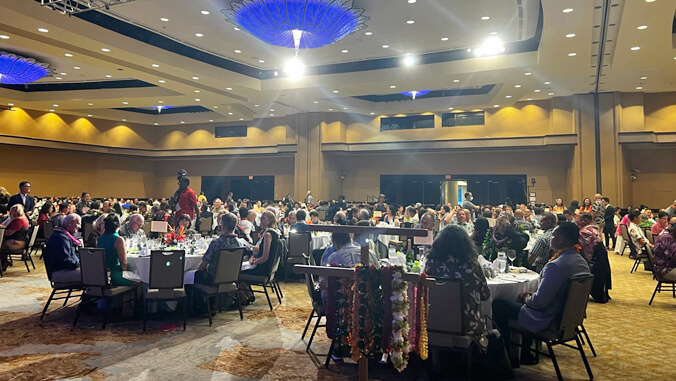
The University of Hawaiʻi at Mānoa Shidler College of Business ’ School of Travel Industry Management ( TIM school) held its 22nd annual Celebrate a Legacy in Tourism gala on April 10, at the Sheraton Waikīkī. Also marking the college’s 75th anniversary, this year’s fundraiser raised a record-breaking $517,000 thanks to the generous support of the hospitality and Hawaiʻi business community.
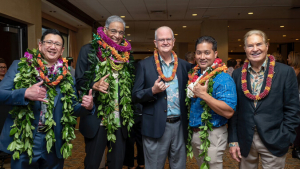
“We’re proud to recognize Mufi Hannemann, Holden Lim and Kyo-ya as trailblazers in their industry, who continue to inspire current and future graduates,” said Shidler College Dean and First Hawaiian Bank Chair of Leadership Management Vance Roley. “Further, it’s incredible that over half a million dollars has been raised to support student scholarships. We applaud the efforts of our volunteer table sales committee and the 2024 honorees to greatly amplify our impact.”
2024 honorees
Celebrate a Legacy in Tourism honors individuals who have made significant and long-term contributions to Hawaiʻi ’s tourism industry. This year, the Legacy in Tourism Award was presented to Muliufi “Mufi” Hannemann; Holden Lim, BBA ’89 was inducted into the TIM Alumni Hall of Honor; and Kyo-ya Hotels & Resorts, LP received the Distinguished Service Award.
Hannemann was honored with the Legacy in Tourism Award for his vast contributions to the tourism industry and dedication to fostering the development of students. As president and CEO of the Hawaiʻi Lodging & Tourism Association, chair of the Hawaiʻi Tourism Authority board, and board member of the U.S. Travel and Tourism Advisory Board, Hannemann has played a pivotal role in shaping the state’s tourism landscape. His founding of the Pacific Century Fellows and service to the TIM school as an advisory council member further showcases his commitment to nurturing future leaders.
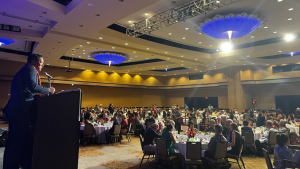
Lim, president of Hospitality Link International, Inc. , was presented with the TIM Alumni Hall of Honor award, recognizing his professional achievements and continued support of the TIM school. Lim’s career in the hospitality industry began in 1989 at the Westin St. Francis in San Francisco and over the years, he contributed significantly to firms like HVS International and Sonnenblick-Goldman Company, orchestrating over $4.5 billion in real estate transactions. Lim remains engaged with the TIM school, currently serving on the TIM Alumni Association as secretary.
Kyo-ya Hotels & Resorts, LP , was recognized with the Distinguished Service Award for their contributions to Hawaiʻi ’s tourism industry and the community, providing many hours of service and volunteer hours to various local causes. Kyo-ya expanded its footprint across Hawaiʻi and California, including iconic properties like The Royal Hawaiian and Sheraton Maui. Additionally, Kyo-ya serves as a pipeline for hospitality careers, hiring numerous graduates from UH and mentoring high school and college students, ensuring the continuity of generations in the islands.
This year’s presenting sponsor was Marriott International; contributing sponsors were Bank of Hawaii; Central Pacific Bank; First Hawaiian Bank; Hawaiʻi Lodging & Tourism Association, Iron Workers Stabilization Fund & Iron Workers Local 625; KV & Associates and Stanford Carr Development; Kyo-ya Hotel & Resorts, LP ; “Sheraton Old Timers” group; and The Westin Maui and Trinity Investments. Hawaii Business magazine once again served as the 2024 media partner.
To support the TIM school or Shidler college, contact Jennifer Lieu, director of development at [email protected] . For a full list of past honorees click here .
Related Posts:
- $425K raised to support UH Travel Industry…
- UH TIM professor earns Pacific Business News’…
- 20th annual TIM School fundraiser honors Roy…
- previous post: UH Mānoa hits academic rankings record with 8 subjects in U.S. top 20
- next post: NCIS Journey: Mānoa students go behind the scenes

If required, information contained on this website can be made available in an alternative format upon request. Get Adobe Acrobat Reader
About Calendar COVID-19 Updates Directory Emergency Information For Media MyUH Work at UH
Gagana Samoa
Kapasen Chuuk
Kajin Majôl
ʻŌlelo Hawaiʻi
- Administrative
More From Forbes
How abu dhabi is bringing the world’s first esports island into its future.
- Share to Facebook
- Share to Twitter
- Share to Linkedin
Aerial view of Abu Dhabi, United Arab Emirates, high-rise buildings and some of the emirate's ... [+] 200-plus islands.
In Abu Dhabi, two modern high-rises bookend a cluster of multi-story, low-lying buildings. At the moment, the structures appear in renderings for what would be the world’s first esports island. But while investments in esports have been cooling off in many places around the globe, plans for the industry-defining megaproject are heating up in the capital city of the United Arab Emirates.
News of the esports island emerged as True Gamers, an operator of a global network of gaming lounges and clubs, announced intentions for a $280 million investment in what is projected to be a $1 billion development. The island would include a digital technology and innovation workspace in one tower, a resort hotel in another tower, a complex of training and meeting spaces, and an arena designed for hosting multi-format events and exhibitions. Even in concept, the project advances Abu Dhabi among regional destinations that are rapidly growing as global centers for sports and sports-led development.
The location being eyed for the esports island is in the centrally-located Al Raha district of residential, retail, commercial, and recreational properties nearby the city’s Zayed International Airport. It sits across a waterway from the sports- and leisure-focused Yas Island .
Yas is renowned for hosting prestigious sports events like the Formula 1 season finale, UFC mixed martial arts cards, NBA exhibition games, and DP World Tour golf tournaments. It welcomes hundreds of thousands of visitors to its Ferrari World, Waterworld, Warner Bros. World, and SeaWorld theme parks. Luxury hotels, shopping malls, golf courses, restaurants, and nightlife venues lend to an entertaining year-round atmosphere. For most of the time since opening in 2009, Yas has also presented a range of health and fitness sessions for the public, including making the entire F1 track available twice weekly for walking, running, or bicycling by people of all ages, abilities, and interests.
While Yas may stand out as a prominent destination for sports-related amenities among Abu Dhabi's array of 200 islands, it is not alone. Another is Huydayriat Island , a 3000-hectare (approximately 7500-acre) fitness- and nature-focused island that includes a surf park, cycling tracks, a velodrome, football pitches, basketball and tennis courts, running and walking trails, skate parks, an obstacle course, watersports, and sixteen kilometers (about ten miles) of beaches. Saadiyat Island has cultural, heritage, educational, residential, recreational, hospitality, and tourism offerings, including kayaking routes that wind around and into the Louvre Abu Dhabi museum.
Apple Issues New Spyware Attack Warning To iPhone Users
Nyt strands hints spangram and answers for friday april 12th, juiced o j simpson once had a hidden camera prank show and made stabbing jokes on it.
Department of Culture and Tourism Abu Dhabi chairman Mohamed Khalifa Al Mubarak recently shared that the emirate’s tourism strategy considers more than $10 billion in state-sponsored and public-private partnership infrastructure investments between now and the end of the decade . The results of those projects figure to add $24.5 billion to the nation's annual gross domestic product. An island that caters to esports and gaming would fit in among those plans and the range of nature preserves, cultural sites, leisure spots, tourist attractions, and commercial centers across the emirate’s existing islands.
But an esports investment wouldn’t come into being for purposes of economic opportunism or public relations gains. It would be because it aligns with the objectives and goals of Abu Dhabi Vision 2030 , the roadmap set forth by the government in 2006 to ensure a sustainable economy.
During the past two decades, governments of cities and nations across the Gulf region have been making massive investments into transforming their economies from a reliance on oil-based operations to an interest in knowledge-based organizations. The strategy aims to enable self-sustaining industries in anticipation of the day in the middle of this century when the bulk of oil reserves are figured to run dry.
The model that the UAE is following to achieve that is “unique and novel,” says Robert Salomon, dean of the NYU Stern School of Business at NYU Abu Dhabi and a professor of management at NYU Stern. “The traditional model in the developing world has been export-led growth. For Abu Dhabi, it’s ‘let's just jump from an oil-based, developing economy and go straight toward services and a knowledge-based economy.’”
The trillions of dollars of investment being committed to these changes are not being driven primarily by economic development, though. They are being powered more so by social impact.
The Abu Dhabi economy is fashioned around a society designed for living, working, and connecting. In terms of approach, it bucks the classical model that puts economics over society. In terms of culture and worldview, it places a premium on improving social pursuits as a means to stirring economic opportunities. Sports and sports-led development are part of that ambition.
“One of the features that defines a developed country is leisure time. And one of the things that people do when they have leisure time is they dedicate more time to sport,” Salomon says. “Sport is one of the markers of a society that has developed.”
From Salomon’s perspective, Abu Dhabi’s local and global investments in sports, the arts, entertainment, film, and creative services are indicators that the emirate has arrived at an inflection point in its evolution. That opens its leadership and people into a new round of thinking-through the questions about what developed countries do and what developed countries can do. “A project like the esports island is consistent with that happening,” he says.
As the esports island emerges on the horizon, Abu Dhabi has a well-established track record of hosting esports events. For example, it recently welcomed back the Blast Premier World Final, an international tournament with a $1 million prize pool, for the second time. Events like that highlight the region’s growing presence in the esports industry.
Esports-related revenue in the region had an annual increase of nearly eight percent to almost $2 billion last year and is on pace to continue rising through the end of the decade, according to a report by Niko Partners . Saudi Arabia generated more than half of the revenue, followed by the UAE with almost one-third of it. This surge in esports, alongside Abu Dhabi's increasing focus on gaming and digital entertainment, is evident decisions such as the integration of Abu Dhabi Gaming—a government-led initiative that aggregates the local gaming ecosystem around talent development, game development, digital education, and esports—into the portfolio of the Department of Culture and Tourism Abu Dhabi late last year.
From ancient times through the middle of the past century, the Abu Dhabi economy was fueled by fishing and pearl diving. Then came oil and trade. Now and in the foreseeable future, it is knowledge and culture. With plans for projects like the world’s first esports island on the rise, Abu Dhabi is primed to further its status as a global sports hub.

- Editorial Standards
- Reprints & Permissions
An official website of the United States government
The .gov means it’s official. Federal government websites often end in .gov or .mil. Before sharing sensitive information, make sure you’re on a federal government site.
The site is secure. The https:// ensures that you are connecting to the official website and that any information you provide is encrypted and transmitted securely.
- Publications
- Account settings
Preview improvements coming to the PMC website in October 2024. Learn More or Try it out now .
- Advanced Search
- Journal List
- Elsevier - PMC COVID-19 Collection

Envisioning the futures of cultural tourism
Xavier matteucci.
a Department of Tourism and Service Management, MODUL University Vienna, Am kahlenberg 1, 1190 Vienna, Austria
b Domain of Creative Business, Inholland University of Applied Sciences, the Netherlands
c Academy for Hotel & Facility, Breda University of Applied Sciences, the Netherlands
d School of Tourism & Hospitality, University of Johannesburg, Johannesburg, South Africa
Licia Calvi
Simone moretti.
e Academy for Tourism, Breda University of Applied Sciences, the Netherlands
In the wake of the Covid-19 pandemic, the future of tourism is a much-debated topic both in academic and non-academic circles with commentators expounding contrasting perspectives. This conceptual paper contributes to such debates and aims at envisioning plausible futures of cultural tourism, in particular. For that purpose, we first discuss cultural tourism trends and the future scenarios available in the literature. Then, we articulate three cultural tourism visions of the decades to come: a utopian, a dystopian and a heterotopian vision. Finally, we conclude that the heterotopian vision provides the most nuanced interpretation of the future of cultural tourism and we discuss the potential ramifications of such a vision.
1. Introduction
In a recent editorial note in the Journal of Tourism Futures, Yeoman (2020) suggests that with the current Covid-19 outbreak "the future of tourism is a blank piece of paper". In other words, what tourism may look like in the future can take different forms, and tourism futures are yet to be "written". The future of tourism is currently a much-debated topic both in academic and non-academic circles with authors expounding contrasting perspectives. Some conjure optimistic scenarios while others have a more pessimistic perspective. With regards to the latter, in a recent thematic issue on tourism of the French magazine Socialter (2020) , most of the activists, practitioners, academics and politicians interviewed contend the lack of substantial governmental and industry commitment to transform the modus operandi of the tourism industry. While these concerns are directed to the tourism industry in general, these are also certainly true to specific forms of tourism such as cultural tourism. In fact, cultural tourism, which is estimated to account for about 39% of all tourism activities ( UNWTO, 2018 ), until recently received extensive media coverage for its poor sustainability performance as epitomised by the overtourism phenomenon.
The outbreak of the Covid-19 pandemic has had a severe impact on the tourism industry and the cultural and creative industries. According to Gössling, Scott, and Hall (2020) , the international travel bans affected over 90% of the world’s population, which resulted in about 80% decline in the international tourism economy for the year 2020 ( OECD, 2021 ). During the first lockdown in spring, especially air travel and cruise lines were by far being hit the hardest due to the closing off of borders. Moreover, the introduction of post-travel quarantine periods has caused a significant decline in tourism demand, whereby accommodations and attractions have had to stop operations all together ( Gössling et al., 2020 ). In addition, strict gathering restrictions have also affected people's mobility significantly, thereby causing cafes and restaurants to change physical operation to delivery mode, as well as postponing or cancelling any large events such as conventions, festivals and sports events. Within a few days only, many cities have shifted from a state of overtourism to one of non-tourism.
In this context, many people wonder how cultural tourism will look after the pandemic. Postma, Heslinga, and Hartman (2020) have discussed the possible future of tourism after the Covid-19 crisis, noting that, depending on the length of the pandemic and the type of governance (top down or bottom up), tourism may be "downsized" to a smaller scale, or quickly return to a "business as usual" situation, including issues such as overtourism. In their contribution, they note the need for further discussion on the future of tourism. This conceptual paper, therefore, aims at envisioning plausible futures of cultural tourism. To inform our conceptual analysis, we draw from recent discussions in the wider tourism scholarship. As a departure point in this endeavour, we acknowledge the context in which cultural tourism is embedded. We then proceed with a brief review of cultural tourism trends and of four scenarios for cultural tourism recently elaborated by Calvi, Moretti, Koens, and Klijs (2020) . We discuss these trends and scenarios and articulate them under three cultural tourism visions of the decades to come: a utopian, a dystopian and a heterotopian vision. Finally, we conclude that the heterotopian vision provides the most nuanced interpretation of the future of cultural tourism and we discuss the potential ramifications of such a vision.
2. The context of cultural tourism and future scenarios
Any attempt at envisioning the future of cultural tourism requires a broad understanding of how several societal trends and global forces have contributed to shape how people live. Understanding the way cultural tourism is currently performed and consumed also necessitates exploring the link between the concept of culture and traditions, heritage, lifestyles, local values and beliefs. Additionally, any speculation about the future of cultural tourism is confronted with the speed and complexity of changes occurring in the world. While it is beyond the scope of this paper to examine each of these social trends and global forces, it is important to highlight a number of key phenomena that are relevant to our discussion. A central concept and multi-dimensional predicament to this discussion is the Anthropocene . The Anthropocene is a geological period, which refers to the human activities that have been impacting the planet since the industrial revolutions of the nineteenth century ( Gren & Huijbens, 2014 ). Most of humans' detrimental impacts are linked to a highly unregulated, profit-driven system of extraction of resources and exploitation. Braidotti (2019) expounds that this toxic "system rests on advanced technologies, the financialization of the economy and the overwhelming power of the media and cultural sectors" (p. 40). To refer to the Anthropocene, Braidotti uses the term Capitalocene, which bluntly unveils the self-destructive power of capitalism, a worldwide prevailing economic system based on the private ownership of means of production.
The political economy of global tourism is intricately tied to the capitalist system, whereby tourism significantly contributes to environmental change ( Hall, 2011 ) and social injustice ( Higgins-Desbiolles, 2008 , Jamal and Higham, 2021 ), which seriously threaten cultural heritage ( Hall, Baird, James, & Ram, 2016 ). Cultural tourism development is a considerable policy issue and policy making is a crucial element of the governance process ( Hall, 2011 ). In the context of cultural tourism, the role of governance in a post-pandemic phase has been discussed by Calvi et al. (2020) , who recognise that any attempt to identify future developments of cultural tourism requires an attentive consideration of the way culture is interpreted by destination managers and embedded in the tourism products developed. Informed by an extensive review of the cultural tourism and sustainability literatures (see Calvi & Moretti, 2020 ), these authors have identified two broad cultural tourism governance approaches: a “community-oriented” and an “economy-oriented” one. While the economy-oriented approach to cultural tourism relies on local cultural resources with the aim to maximise the economic benefit for the tourism industry, the community-oriented approach aims at revitalising local cultures, and at maximising community wellbeing.
Alongside these modes of governance, the authors regard cultural tourism demand as the other key parameter that has been shaping the evolution of cultural tourism. The last two decades have witnessed a shift in tourists' consumption of culture. On the one hand, tourists are not merely seeking to experience iconic heritage sites and tangible cultural assets; instead, an increasing number of tourists are now looking for to experience authenticity in the contemporary way of life of the places they visit ( Frisch et al., 2019 , Richards, 2018 ). On the other hand, many tourists are also "actively and knowingly seeking the inauthentic as the basis of their experience" ( Ravenscroft & Matteucci, 2003 , p. 2). Smith (2016) refers to these individuals as "new leisure tourists"; such new leisure tourists are associated with experiential tourism , a subset of cultural tourism. Calvi et al. (2020) conceptualise these two separate consumer segments as a "slow" and a "fast" cultural tourism demand. The slow cultural tourism demand is characterised by small and fragmented niches, where people are eager to experience specific "authentic" elements of local culture, and willing to pay a premium-price for that authenticity. An example would be the flamenco tourists who partake in flamenco courses in Andalusia, Spain ( Matteucci, 2018 ). The fast cultural tourism demand corresponds to a more uniform, global, less authenticity-driven type of demand, which is also focused on "consuming" local cultures as an element of a price-sensitive tourism experience.
Based on the intersection of cultural tourism demand and modes of governance, Calvi et al. (2020) have identified four distinctive scenarios of cultural tourism futures: (1) a community-driven slow cultural tourism, (2) an economy-driven slow cultural tourism, (3) a globalised cultural tourism and (4) a glocalised cultural tourism (see Fig. 1 ).

Scenarios for the future of cultural tourism ( Calvi et al., 2020 ).
The model presented in Fig. 1 is based on the assumption that the supply side of cultural tourism will respond to consumer trends; yet Calvi et al. (2020) also recognise that the supply of cultural products may, to some extent, also be shaped by a destination's governance approach. Because, sometimes, the products and trends pushed by the supply side can significantly influence consumer expectations, the role and function of the cultural tourism supply is here emphasised. Each one of these four scenarios is briefly presented below.
The community-driven slow cultural tourism scenario combines the prevalence of a slow cultural tourism demand with the adoption of a community-oriented governance approach. In this scenario, bottom-up participatory initiatives steer cultural tourism development. What is considered "local culture" by the community, its social and ecological dimensions, becomes the core of the cultural offer. Tourism products and service supply mainly make use of local and regional products, using traditional production techniques and mostly employing local human resources. No mass-produced products are offered to tourists and each tourist experience tends to be personalised. As a consequence, in exchange of a personalised and authentic cultural experience, prices may be relatively high. Destinations may need to deploy creative strategies in order to attract specific types of cultural tourists - only a small portion of the global cultural tourism demand. A risk for destinations, however, may be that niches of cultural tourists may not generate sufficient benefits for fostering community prosperity.
The economy-driven slow cultural tourism scenario is characterised by the prevalence of a slow cultural tourism demand combined with the adoption of an economy-oriented governance approach. In this scenario, the top-down mode of governance prevails and it accommodates the governing elite's (political power, DMO, industry) interpretation of local culture, which stimulates its use with the core aim to maximise the economic benefit to the tourism industry (with moderate indirect and induced economic impact sprinkling to the community). In this scenario, Calvi et al. note that governance relies on a flexible regulatory framework to stimulate local entrepreneurship; however, due to the limited size of the slow tourism segment, most businesses may consist of small companies in terms of employees and profits. Rather than enabling genuine encounters, and due to compromises necessary to maximise businesses’ profitability, elements of local authenticity are instrumentally exploited to stage "authentic" cultural experiences. As a consequence, tourism and cultural service providers sometimes make use of material, labour and techniques that are extraneous to the local fabric. Commodification processes may impinge upon the views of residents and tourists towards the "authenticity" of local cultures ( Richards, 2007 ). The dangers with this scenario is that residents may blame tourism for commoditising their local culture but also that destinations may eventually lose their appeal.
Globalised cultural tourism entails an economy-oriented model of governance that caters to the "fast" consumption patterns of what McKercher (2002) has referred to as incidental cultural tourists. While tourists want to experience elements of the local culture such as "must-see" attractions, they are less likely to seek out the nooks and crannies of everyday local life. Due to the size of this mass market, the supply-side landscape is dominated by rather large companies such as international chains. In developing regions, low-skilled tourism jobs are mostly filled by locals, while non-local workers tend to occupy managerial positions. As the demand is more uniform, and the scenario is supply-driven, most of the tourism stakeholders are concerned with attracting growing numbers of visitors. The likely consequences of such a governance approach are the deterioration of the socio-cultural fabric, environmental damage, excessive economic dependence on tourism as typified in regions affected by overtourism.
G localised cultural tourism is characterised by a community-oriented governance approach and a "fast" demand for price sensitive tourism experiences ( Calvi & Moretti, 2020 ). In this scenario, cultural tourism initiatives are mainly led by small and medium-sized local businesses that promote authentic aspects of local cultures. Tourists who constitute this fast demand not only have a limited knowledge of the local culture, but many are satisfied with or even expect inauthentic experiences. Therefore, glocalised cultural tourism may be confronted with the risk of a demand and supply mismatch, whereby a cultural tourism offer based on authentic cultural resources and manifestations may fail to meet tourists' expectations of less-authentic but entertaining cultural products. The local cultural tourism industry may be, therefore, compelled to find a challenging equilibrium between (a) partial adjustments of their cultural offerings to meet larger segments of price-sensitive and less authenticity-driven tourists (therefore shifting towards forms of globalised cultural tourism), and (b) the danger of community antagonism towards forms of tourism associated with overtourism. In extreme forms, this may even lead to specific tourism-oriented ‘cultural tourism’ areas where parts of an original destination are brought together in a more easily accessible and/or sanitised form.
3. The future of cultural tourism revisited: three visions
The four scenarios expounded by Calvi et al. (2020) provide valuable food for thought. When these authors contend that "resilient destinations will need to be prepared to adapt to any of these scenarios" (p. 38), they seem to suggest that the future of destinations will be shaped by one of these four scenarios. However, because destinations are complex, fragmented and multidimensional entities, one may argue that while some governance modalities may predominate in some contexts, all scenarios may coexist to various degrees at the destination level. Based on complex conjunctures shaped by social, cultural, political, environmental and economic contingencies, we therefore anticipate three potential cultural tourism futures that may unfold. We describe these as utopian, dystopian and heterotopian. We acknowledge that concepts like utopia and dystopia are contested and open to multiple interpretations ( Isaac, 2015 ). In this paper, we consider these two as ideal types of cultural tourism development that are fitting with two concurrent narratives that appear to be taking shape in the tourism discourse with regards to post-pandemic development ( Brouder, 2020 , Zenker and Kock, 2020 ). By relating these to cultural tourism, it becomes possible to appreciate a range of possibilities and dangers that may lie ahead for cultural tourism. The heterotopian future combines elements of both ideal types and seeks to provide insights to the circumstances under which both ideal types may develop in real-life settings.
3.1. A utopian future
The future of cultural tourism is uncertain; yet, some positive changes can be anticipated. While the term utopia may be seen as both naive or unrealistic, the value of imagining utopias resides in illuminating the path we may need to take to an end goal ( Yeoman, Palomino-Schalscha, & McMahon-Beattie, 2015 ). In other words, envisioning a utopian cultural tourism may inspire decision-makers such as tourists, hosts, planners and developers as well as business operators. Therefore, utopias possess a latent agentic power, which may be exercised in practice. Beyond mere recovery, the tourism industry has now an opportunity to transform itself. Before the pandemic outbreak, a number of critical voices (e.g., D'Sa, 1999 ; Higgins-Desbiolles, 2008 ; Higgins-Desbiolles, Carnicelli, Krolikowski, Wijesinghe, & Boluk, 2019 ; Weaver & Jin, 2016 ) had already urged for an equitable transformation of tourism. Some of these calls for more sustainable tourism futures are embedded within anti-capitalist discourses of a new global order, which reflect wider and more dramatic global disruptions threatening mankind and life on earth. In our view, a utopian cultural tourism future would be characterised by greater collective wellbeing propelled by degrowth strategies led by post-anthropocentric community-driven modes of governance and slow tourism practices.
While the UNWTO has long been an advocate of sustainable growth, a growing number of researchers are now questioning whether sustainable growth is attainable at all ( Fletcher and Rammelt, 2017 , Hickel and Kallis, 2020 , Parrique et al., 2019 ). Furthermore, some (e.g., Gascón, 2019 ) have criticised the UNWTO's tourism growth agenda as counter-productive to societal welfare. An alternative to sustainable growth is tourism degrowth ( Fletcher et al., 2019 , Higgins-Desbiolles et al., 2019 , Milano et al., 2019 , Sharpley, 2020 ). Kallis et al. (2018) define degrowth as "voluntary, radical political and economic reorganisation leading to drastically reduced resource and energy throughput while welfare, or well-being, improves" (p. 292). Degrowth should not be confused with economic decline or recession. Hall (2010) equates degrowth to "steady-state tourism [...] that encourages qualitative development but not aggregate quantitative growth to the detriment of natural capital" (p. 131). In the same vein, Büscher and Fletcher (2017) specify that a radical degrowth should be accompanied by more sustainable modes of consumption and production. For example, Martinez Alier (2009) argues that if degrowth is to be socially sustainable in any region, a fairly substantial redistribution of wealth and resources will be a prerequisite.
Degrowing and slowing cultural tourism might be a daunting challenge; however, the concept of degrowth does fit with that of creative tourism and New Urban Tourism, both of which emphasise the importance of localhood and placemaking practices in the creation of cultural tourism ( Bargeman and Richards, 2020 , Frisch et al., 2019 ). Such a more localised place-based approach may contribute to a more equitable development of cultural tourism, in line with the destination that is visited. In a utopian future, leadership imbued with an ethics of care and strong political commitment ( Guia, 2021 ) would facilitate a substantive paradigm shift in cultural tourism governance that stimulates such practices. A paradigm shift would entail abandoning the current anthropocentric view that nature is instrumental to human pleasure and embrace a post-anthropocentric ontology ( Matteucci, Nawijn, & Von Zumbusch, 2022 ). Post-anthropocentrism not only ascribes equal status and intrinsic value to both human and non-human forms of life but it also highlights their fundamental interconnection and interdependency ( Benson, 2019 ). Because wellbeing emerges through the dynamic interplay of material and non-material actors in the social-ecological system ( Onfray, 2015 , White, 2017 ), a post-anthropocentric mindset would seek to understand the complex role played by these various actors.
A utopian cultural tourism future would be one where local communities realised that it was their collective responsibility to effectuate change in order to prioritise residents' wellbeing. In this view, cultural tourism governance would be based on grassroots movements ( Latouche, 2006 ), community partnership and ethical modes of consumption. Emphasis would be put on the local production and consumption of cultural tourism products and services that are endogenous. For being less dependent on outbound markets ( Romagosa, 2020 ), domestic and proximity tourism would be prioritised. If local residents spent their time, money and energy in the vicinity of their home, social capital leakages would be avoided and place attachment would be strengthened ( Hollenhorst, Houge-Mackenzie, & Ostergren, 2014 ). Utopian cultural tourism would also attend to cultural diversity as a key dimension of carrying capacity indexes ( Higgins-Desbiolles et al., 2019 ).
The lessons learnt from the first Neighbourhood Forum of Tourism held in Barcelona suggest that key tourism degrowth measures would consist of cutting funds and subsidies to tourism agencies and tourism promotion campaigns (a.k.a. demarketing) and, fostering modes of participatory tourism governance and urban planning processes ( Milano et al., 2019 ). Participatory governance means putting citizens at the centre of decision-making because cultural "tourists may have much to learn from host communities about sustainable living and the protection of natural and cultural resources" ( Smith, 2016 , p. 251). The community-driven slow cultural tourism scenario elaborated by Calvi et al. (2020) resonates with our portrayal of a utopian future. Furthermore, a utopian cultural tourism would be one that not only aligns with but also enforces the application of the SDGs and one that redefines the "right to tourism", ratified by Article 10 of the 2017 UNTWO’s Framework Convention on Tourism Ethics ( Tremblay-Huet, 2020 ). For a more equitable and sustainable future, Higgins-Desbiolles et al. (2019) similarly argue that the rights of local communities would prevail over the rights of tourists and the rights of tourism multinational companies to make profits. In short, cultural tourism degrowth initiatives would offer a great opportunity for debates and dialogue to flow through and give impetus for multi-stakeholders to explore the underlying issues of overtourism (or mass cultural tourism). Although tourism degrowth faces critics, there may currently be few viable alternatives.
3.2. A dystopian future
The utopian picture presented above postulates that degrowth-based cultural tourism destinations would operate under very different social, economic, cultural and political principles from the ones that are currently dominant. A radical transition would need to happen fast in order to curb many of the ongoing anthropocentric disruptions. These disruptions include an accelerated loss of biodiversity, plants and animal extinction rates, global warming at an unprecedented alarming rate, plastic pollution and high levels of nitrogen and phosphorous in soils due to fertilisers ( Carrington, 2016 ). Gowdy (2020) pessimistically argues that it “seems unlikely that the policies required to keep warming at manageable levels will be implemented in time to avoid catastrophic climate change” (p. 4). The Anthropocene impacts directly on cultural tourism as historic buildings, ancient city walls and cultural treasures are under threat from rising sea levels (e.g., cities like Venice, Lübeck, Sabratha are at risk). Extreme weather conditions also impact on cultural heritage in different ways. Periods of extreme heat can harm paintings, cloths, wallpapers or ornaments made of natural materials (e.g. leather).
Dystopian elements of a social and political nature can also be discerned with regard to certain current cultural tourism practices. This is exemplified by destinations seeking to add extraneous popular attractions to their cultural product portfolio (e.g., Christmas markets and branded museums) in order to find a competitive edge. This serial reproduction of culture ( Richards & Wilson, 2006 ) has been associated with processes of cultural commodification and homogenisation as well as cultural identity alienation. Dystopia is also revealed in destinations suffering from overtourism, either because they are overrun with tourists, physical touristification (e.g., tourist shops replacing non-tourist services) or insensitive or inappropriate tourist behaviour ( Koens, Postma, & Papp, 2018 ). It can also be that cultural heritage comes to represent such an economic value, that tourism and non-tourism actors compete for the use of public spaces. Such processes are already underway in historic cultural cities such as Barcelona and Venice, where residents feel their interests have become subservient to the interests of tourism ( Milano et al., 2019 , Seraphin et al., 2018 ). Rather than contributing to quality of place of a destination, this may lead to monocultural tourism ghettos. The Covid-19 pandemic has shown that sudden undertourism has had strong negative impacts on cities like Barcelona where many people depend on tourism for income. Early experiences after the first Covid-19 lockdown and the subsequent situation of undertourism, suggest the pandemic has led to the rise of a discourse of quickly rebuilding tourism and facilitating tourism businesses to make up for lost income (e.g., by creating a green pass to facilitate travel in Europe or by giving up public space for the extension of terraces for cafes) ( Higgins-Desbiolles, 2020 ). This discourse may further negatively impact on local cultures by commercialising sites of local importance and public spaces.
In a similar vein, in a dystopian future, being nominated as a World Heritage Site, is not necessarily positive. While World Heritage Sites attract large numbers of visitors, it is far from evident that this results in increased financial opportunities for local stakeholders or protection of the site ( Caust & Vecco, 2017 ). Hollenhorst et al. (2014) likened tourism economies at a destination to "leaky buckets"; tourists may pour money in, but this leaks straight out to stakeholders outside of the local economy. In such a future, World Heritage status "could be seen as a marketing device more than a protection approach" ( Caust & Vecco, 2017 , p 8). When heritage becomes viewed more as a consumption good aimed at satisfying tourists' demands, instead of as an intrinsically culturally valuable asset ( Simpson, 2016 ), this can also lead to local heritage being presented as more extreme and stereotypical. This is particularly worrying in places where the cultural product is not inherently positive (e.g., dark tourism, slum tourism), and a negative depiction can lead to entrenchment of prejudices or stigmatisation of host communities ( Koens and Thomas, 2016 , Rofe, 2013 ).
Even in cases where tourism enhances the public image of an area, and local community members are active participants in the production of cultural tourism, it can still lead to local community members being disempowered ( Richter, 2010 ). Local communities and entrepreneurs may lose out to businesses from outside the locality, which have better connections and market access. As a result, locals may be used as low-wage staff instead, to provide a whiff of authenticity and presumed support of local culture ( Koens & Thomas, 2016 ). As such, in a dystopian future, well-intentioned ideas for more social and sustainable tourism development can be corrupted or misused to serve the (economic) interests of a small number of stakeholders ( Scheyvens, 2009 ). The same can be said about tourism employment. While tourism is often hailed as providing "weaker" groups in society with employment opportunities, Walmsley, Koens, and Milano (2021) note that this is not self-evident. They argue that unfettered tourism growth can lead to lower nominal and real wages, deepen divisions in the labour market, also between local and migrant workers, increase work pressure without sufficient remuneration as well as a deterioration of working conditions. This vision of the future is akin to the globalised cultural tourism scenario articulated by Calvi et al. (2020) .
Although, in name, the importance of overcoming these issues is recognised within the wider tourism industry, they are insufficiently addressed, as supranational and business organisations have been described as ignorant and disinterested in tackling these issues ( Gössling, 2020 ). Büchs and Koch (2019) contend that extant economic growth modes of governance are so deeply rooted in modern societies that any potential transition would require a radical shift in the mentalities that underpin the system. It is unlikely that such a radical shift will come to be around the world. Instead, it appears more likely that the world of tomorrow, therefore, will be one of scarce environmental and social resources, competition over public space, and rivalry and conflicts. At the same time, such a dystopian future shall not be viewed as a fatality. Even in what may be presumed as potential dystopic places, initiatives are unfolding to come to positive change ( Panayiotopoulos & Pisano, 2019 ).
3.3. A heterotopian future
The likelihood of witnessing a radical political change that would re-focus policy from growth to degrowth and the fair distribution of the benefits of cultural tourism is questionable. Indeed, Sharpley (2020) deplores that more than twenty years of sustainable tourism scholarship and policy have led to little progress towards sustainable tourism development. This failure has been primarily attributed to four decades of neoliberal capitalism whose symptoms include weaker government roles and looser regulations, marketisation and privatisation of public space and services, reduced taxes on the rich, offshoring of wealth and power, and excessive individualism ( Monbiot, 2016 ). Although neoliberal policies are everywhere plagued by market failures, neoliberal capitalism as we know it today may linger for a while. Indeed, as Aubenas and Benasayag (2002) observe, capitalism is not a historical upheaval; rather, it is a form of civilisation, a long journey of thought, of culture, of life, of which we are all a part. In fact, growth-based capitalism pervades all spheres of social life from education, research to welfare systems ( Büchs & Koch, 2019 ). While a systemic change may be underway ( Higgins-Desbiolles, 2020 ), we fear that this change may be slow and firstly materialise in the form of pockets of resistance. Informed by Foucault (1986) essay entitled "Des espaces autres" [Of other spaces], we describe these pockets of resistance to mainstream neoliberal practices as heterotopian.
Heterotopias are frequently understood as counter-sites or sites of resistance ( Topinka, 2010 ). Foucault argues that six principles characterise heterotopias; four of these are pertinent to our discussion. First, heterotopias can be found in any culture, yet through different forms, and in them, people's actions deviate from the norms to some extent. Second, people may use heterotopias in variegated ways over time; therefore, heterotopias embody processes of alternate social ordering ( Hetherington, 1997 ). Third, although heterotopias are separate spaces, they are connected to other sites in that people can enter and exit them freely. The fourth principle is that heterotopias serve a function in relation to all other spaces, namely either heterotopias offer the illusion of a perfect social world or serve as sites of transgression where one can escape the normative behavioural patterns of the mainstream. Contrary to utopia, the heterotopia is a real space in which a utopian vision of the world can be enacted or, as Saldanha (2008) contends, "heterotopia is [...] more of an idea about space than any actual space" (p. 2089). In any case, the power of heterotopias lies in their potential to emancipate those who dwell in them.
Rather than merely being utopian or dystopian, we anticipate the future of cultural tourism, therefore, to be heterotopian. A heterotopian future would manifest itself as the multiplication of bubbles of ethical consumption and practices within a slowly decaying mainstream neoliberal order. These bubbles of ethical consumption and practices correspond to what we have introduced as pockets of resistance. Pockets of resistance already exist in the form of cooperatives, social enterprises and non-profit businesses. A Southern French example is Hôtel du Nord , a residents' cooperative network with an internet platform, which promotes the social value of heritage, and the recognition of Marseille' non-touristic districts through heritage walks and private accommodation services. The central concerns underlying this initiative are to keep alive the history of Marseille's northern and poorer districts, and to improve the lives of its most vulnerable residents ( Miedes-Ugarte, Florez-Ruiz, & Wanner, 2020 ). Other examples include the European initiative Migrantour, which promotes cultural diversity by connecting migrants to cultural tourists ( Vietti, 2018 ), and community-based projects in Latin America that are guided by the tenets of buen vivir [living well together], an indigenous philosophy underpinned by concerns about collective wellbeing ( Chassagne & Everingham, 2019 ). These examples are heterotopian for their marginality, their heterodox practices based on the precepts of solidarity, social justice, cultural diversity and slow encounters, and for their emancipatory power.
The intrinsic value of these pockets of resistance or heterotopias resides in the production of the myriad experiences that would allow destination stakeholders to meet, exchange ideas, collaborate, establish new networks, join forces in order to hone development practices, which would produce relational goods. Creativity and learning may emerge from collaborative actions, which in turn, may foster socially inclusive political visions. In fact, White (2017) asserts that "relational goods can only be produced through collaboration" (p. 132). In a similar vein, for French philosopher Gilles Deleuze (1988) , the act of creation is in itself an act of resistance. For their place-specific character, grassroots cultural tourism interventions would represent singular, creative departures from the unidimensional mode of capitalist governance ( Aubenas & Benasayag, 2002 ). While mainstream neoliberal policies would typically follow experiential marketing recipes to establish enclaves of superficial cultural consumption (see Simpson, 2016 for a compelling analysis of Dubai, Macau and Las Vegas), cultural tourism heterotopias would be spaces of creativity, social relationships, knowledge and citizenships. Creative slow tourism activities would be pursued in heterotopias whereby privileging social encounters, fomenting cultural skills and diversity and care for nature. Successful pockets of resistance may inspire other communities, particularly as it can be expected that there will be demand for alternative modes of tourism consumption. For example, the economy-driven slow cultural tourism and glocalised cultural tourism scenarios that were mentioned earlier in this paper would fit well within a hetereotopian vision, where local bubbles of utopia welcome tourists that are upset with overtouristified destinations and seek ethical tourism experiences. Therefore, such cultural tourism pockets could multiply and sprawl to other neighbourhoods and regions.
4. Conclusion
This paper has presented three cultural tourism futures described as utopian, dystopian and heterotopian, which we expect to coexist to various degrees at a destination level even when some consumption and governance modalities may predominate in some contexts. A utopian future would be marked by global degrowth strategies led by post-anthropocentric community-driven modes of governance and slow cultural tourism practices. This utopian vision resembles the community-driven slow cultural tourism scenario and the perspective of Matteucci, Nawijn, & Von Zumbusch, 2022 , who urge tourism destinations to follow a new materialist governance approach, which prioritises the needs and concerns of local communities over those of tourists and the travel trade. While a utopian future would solve many of the predicaments of the Anthropocene, the past decades of tourism policy have revealed that policymakers are reluctant to embrace shifts in their governance paradigm ( Hall, 2011 ). Indeed, as Christin (2020) notes, capitalism can digest Covid-19 very well with some adaptations and compensatory measures. For instance, in mid-May 2020, the French government released 18 billion euros to help tourism overcome what former Prime Minister Édouard Philippe described as "the worst ordeal" in the country's history. As Christin warns, with recovery packages on the horizon lies the illusion of green tourism growth that perpetuates an unsustainable tourism system, thus leading to a potential dystopian future ( Milano & Koens, 2021 ).
A dystopian future would be one where community wellbeing is further undermined. We do not anticipate such an apocalyptic future as portrayed by Wright (2016) in which wealthy tourists hunt underprivileged residents in a safari-like fashion; instead, our dystopian vision would resonate with the scenario of globalised cultural tourism. Here, top-down cultural tourism governance would favour a fraction of powerful stakeholders at the expense of a majority of residents. The issues and dilemmas engendered by overtourism would linger and possibly worsen; increasing conflicts may arise as residents' antagonism towards tourists and tourism grow. While a utopian future may be overly optimistic, a dystopian future characterised by business-as-usual practices may not be tenable for much longer. Informed by decades of tourism market failures and recent cultural tourism trends and debates, rather we anticipate the future of cultural tourism to be heterotopian.
A heterotopian future better accounts for contingencies, and the many struggles and social movements unfolding in many places. We suggest that pockets of resistance to mainstream cultural tourism practices will emerge in various forms. These pockets of resistance will be marked by ethical modes of consumption and governance, as well as by democratic and egalitarian relationships between tourists and hosts. Considering that it is unlikely that a governance paradigm shift takes place from one day to the next, we expect these bubbles of ethical consumption to develop slowly, spread and become role models for many community-led cultural tourism initiatives. As alternative creative practices and experiences, such cultural tourism interventions are deemed to be heterotopian for their rebellious character and their emancipatory power. At the same time, there is always the risk that they become elitist bubbles for a selected group of well-paying tourists.
Even if the future of cultural tourism remains uncertain, a growing number of voices (e.g., Higgins-Desbiolles et al., 2019 ; Jamal & Camargo, 2014 ; Koens, Smit, & Melissen, 2021 ; Matteucci, Nawijn, & Von Zumbusch, 2022 ) are calling for the urgent need for cultural destinations to put local communities at the centre of tourism planning and management. As Krippendorf (1987) had already explicitly articulated in his seminal work the Holiday Makers , for cultural tourism destinations to be resilient, decision-makers will need to commit to "humanising" tourism . The recognition that tourism is a socially constructed phenomenon ( Cohen & Kennedy, 2013 ) suggests that tourism activities rely on human conventions and decisions; thus, cultural tourism is not merely governed by inexorable economic forces. If tourism is dependent on human conventions, therefore, cultural tourism can be changed if decision-makers agree to do so. The vested interest of a few villains ( Weaver, 2011 ) may, however, account for the key obstacle to meaningful changes in cultural tourism destinations. This being said, an affirmative philosophy of life appears more fruitful than indulging in denial or negativity. Despite the dark or "absurd" side of tourism, Albert Camus (1913–1960) would advise us to defy challenges, resist and face the future with zest and passion. Perhaps, the future of cultural tourism should be envisioned as one of rebellion against conventional bureaucratic practices and the power of big business. This way of apprehending everyday life would bring joy to those who seek to live more meaningful lives here and now. In the same vein, more than 30 years ago, Krippendorf (1987) had already pleaded for acts of resistance calling for "rebellious tourists and rebellious locals" (p. 107). Therefore, as long as there will be some injustice to overcome, believing in a better cultural tourism future will be a matter of action.
This work was supported by the European Union’s Horizon 2020 research and innovation programme [No. 870708].
Declaration of Competing Interest
No potential conflict of interest was reported by the authors. The contents of this paper are the sole responsibility of the authors and can under no circumstances be regarded as reflecting the position of the Research Executive Agency and European Commission under the European Union’s Horizon 2020 programme.
Biographies
Xavier Matteucci specialises in tourism experiences, well-being, cultural tourism, qualitative research methodologies and the theory of science.
Ko Koens specialises in new urban tourism, overtourism, slum tourism, sustainable urban tourism and governance.
Licia Calvi specialises in cultural heritage, experience design, digital storytelling.
Simone Moretti specialises in social impacts of tourism, sustainable tourism, cultural tourism.
- Aubenas F., Benasayag M. Résister, c’est créer. La Découverte. 2002 [ Google Scholar ]
- Bargeman B., Richards G. A new approach to understanding tourism practices. Annals of Tourism Research. 2020; 84 doi: 10.1016/j.annals.2020.102988. [ PMC free article ] [ PubMed ] [ CrossRef ] [ Google Scholar ]
- Benson M.H. New materialism: An ontology for the Anthropocene. Natural Resources Journal. 2019; 59 (2):251–280. doi: 10.2307/26800037. [ CrossRef ] [ Google Scholar ]
- Braidotti R. A theoretical framework for the critical posthumanities. Theory, Culture & Society. 2019; 36 (6):31–61. doi: 10.1177/0263276418771486. [ CrossRef ] [ Google Scholar ]
- Brouder P. Reset redux: Possible evolutionary pathways towards the transformation of tourism in a COVID-19 world. Tourism Geographies. 2020; 22 (3):484–490. doi: 10.1080/14616688.2020.1760928. [ CrossRef ] [ Google Scholar ]
- Büchs M., Koch M. Challenges for the degrowth transition: The debate about wellbeing. Futures. 2019; 105 :155–165. doi: 10.1016/j.futures.2018.09.002. [ CrossRef ] [ Google Scholar ]
- Büscher B., Fletcher R. Destructive creation: Capital accumulation and the structural violence of tourism. Journal of Sustainable Tourism. 2017; 25 (5):651–667. doi: 10.1080/09669582.2016.1159214. [ CrossRef ] [ Google Scholar ]
- Calvi, L., & Moretti, S. (2020). Future of cultural tourism for urban and regional destinations. Deliverable D2.2 of the Horizon 2020 project SmartCulTour (GA number 870708), published on the project web site on October, 2020 . 〈 http://www.smartcultour.eu/deliverables/ 〉.
- Calvi, L., Moretti, S., Koens, K., & Klijs, J. (2020). The future of cultural tourism; Steps towards resilience and future scenarios. ENCATC, 2, pp. 34–40. 〈 https://www.encatc.org/media/5695-encatc_magazine_issue2-final-2.pdf 〉.
- Carrington, D. (2016). The Anthropocene epoch: scientists declare dawn of human-influenced age. The Guardian Online . 〈 https://www.theguardian.com/environment/2016/aug/29/declare-anthropocene-epoch-experts-urge-geological-congress-human-impact-earth 〉.
- Caust J., Vecco M. Is UNESCO World Heritage recognition a blessing or burden? Evidence from developing Asian countries. Journal of Cultural Heritage. 2017; 27 :1–9. doi: 10.1016/j.culher.2017.02.004. [ CrossRef ] [ Google Scholar ]
- Chassagne N., Everingham P. Buen vivir: degrowing extractivism and growing wellbeing through tourism. Journal of Sustainable Tourism. 2019; 27 (12):1909–1925. doi: 10.1080/09669582.2019.1660668. [ CrossRef ] [ Google Scholar ]
- Christin, R. (2020). Repartir, mais pas comme avant. Le Monde Diplomatique, juillet , pp. 16–17. 〈 https://www.monde-diplomatique.fr/2020/07/CHRISTIN/61948 〉.
- Cohen R., Kennedy P. Palgrave; 2013. Global sociology. [ Google Scholar ]
- Deleuze G. Interview with Claire Parnet. Films du Losange; Paris: 1988. L'abécédaire de Gilles Deleuze. R comme résistance. 〈https://youtu.be/voRRg3HBQnE〉 [ Google Scholar ]
- D'Sa E. Wanted: tourists with a social conscience. International Journal of Contemporary Hospitality Management. 1999; 11 (2/3):64–68. doi: 10.1108/09596119910250670. [ CrossRef ] [ Google Scholar ]
- Fletcher R., Mas I.M., Blanco-Romero A., Blázquez-Salom M. Tourism and degrowth: An emerging agenda for research and praxis. Journal of Sustainable Tourism. 2019; 27 (12):1745–1763. doi: 10.1080/09669582.2019.1679822. [ CrossRef ] [ Google Scholar ]
- Fletcher R., Rammelt C. Decoupling: A key fantasy of the post-2015 sustainable development agenda. Globalizations. 2017; 14 (3):450–467. doi: 10.1080/14747731.2016.1263077. [ CrossRef ] [ Google Scholar ]
- Foucault M. Of other spaces. Diacritics. 1986; 16 (1):22–27. [ Google Scholar ]
- Frisch T., Sommer C., Stoltenberg L., Stors N. Tourism and everyday life in the contemporary city. 1st ed. Routledge; 2019. [ Google Scholar ]
- Gascón J. Tourism as a right: A "frivolous claim" against degrowth? Journal of Sustainable Tourism. 2019; 27 (12):1825–1838. doi: 10.1080/09669582.2019.1666858. [ CrossRef ] [ Google Scholar ]
- Gössling S. Utopian visions or dystopian prospects for tourism? A perspective article. Tourism Review. 2020; 75 (1):179–181. doi: 10.1108/TR-01-2019-0034. [ CrossRef ] [ Google Scholar ]
- Gössling S., Scott D., Hall C.M. Pandemics, tourism and global change: A rapid assessment of COVID-19. Journal of Sustainable Tourism. 2020:1–20. doi: 10.1080/09669582.2020.1758708. [ CrossRef ] [ Google Scholar ]
- Gowdy J. Our hunter-gatherer future: Climate change, agriculture and uncivilization. Futures. 2020; 115 doi: 10.1016/j.futures.2019.102488. [ CrossRef ] [ Google Scholar ]
- Gren M., Huijbens E.H. Tourism and the Anthropocene. Scandinavian Journal of Hospitality and Tourism. 2014; 14 (1):6–22. doi: 10.1080/15022250.2014.886100. [ CrossRef ] [ Google Scholar ]
- Guia J. Conceptualizing justice tourism and the promise of posthumanism. Journal of Sustainable Tourism. 2021; 29 (2–3):503–520. doi: 10.1080/09669582.2020.1771347. [ CrossRef ] [ Google Scholar ]
- Hall C.M. Changing paradigms and global change: From sustainable to steady-state tourism. Tourism Recreation Research. 2010; 35 (2):131–143. doi: 10.1080/02508281.2010.11081629. [ CrossRef ] [ Google Scholar ]
- Hall C.M. Policy learning and policy failure in sustainable tourism governance: From first-and second-order to third-order change? Journal of Sustainable Tourism. 2011; 19 (4–5):649–671. doi: 10.1080/09669582.2011.555555. [ CrossRef ] [ Google Scholar ]
- Hall C.M., Baird T., James M., Ram Y. Climate change and cultural heritage: Conservation and heritage tourism in the Anthropocene. Journal of Heritage Tourism. 2016; 11 (1):10–24. doi: 10.1080/1743873X.2015.1082573. [ CrossRef ] [ Google Scholar ]
- Hetherington K. Routledge; 1997. The badlands of modernity: Heterotopia and social ordering. [ Google Scholar ]
- Hickel J., Kallis G. Is green growth possible? New Political Economy. 2020; 25 (4):469–486. doi: 10.1080/13563467.2019.1598964. [ CrossRef ] [ Google Scholar ]
- Higgins-Desbiolles F. Justice tourism and alternative globalisation. Journal of Sustainable Tourism. 2008; 16 (3):345–364. doi: 10.1080/09669580802154132. [ CrossRef ] [ Google Scholar ]
- Higgins-Desbiolles F. The “war over tourism”: Challenges to sustainable tourism in the tourism academy after COVID-19. Journal of Sustainable Tourism. 2020; 29 (4):551–569. doi: 10.1080/09669582.2020.1803334. [ CrossRef ] [ Google Scholar ]
- Higgins-Desbiolles F., Carnicelli S., Krolikowski C., Wijesinghe G., Boluk B. Degrowing tourism: Rethinking tourism. Journal of Sustainable Tourism. 2019; 27 (12):1926–1944. doi: 10.1080/09669582.2019.1601732. [ CrossRef ] [ Google Scholar ]
- Hollenhorst S.J., Houge-Mackenzie S., Ostergren D.M. The trouble with tourism. Tourism Recreation Research. 2014; 39 (3):305–319. doi: 10.1080/02508281.2014.11087003. [ CrossRef ] [ Google Scholar ]
- Isaac R.K. Every utopia turns into dystopia. Tourism Management. 2015; 51 :329–330. doi: 10.1016/j.tourman.2015.05.001. [ CrossRef ] [ Google Scholar ]
- Jamal T., Camargo B.A. Sustainable tourism, justice and an ethic of care: Towards the Just Destination. Journal of Sustainable Tourism. 2014; 22 (1):11–30. doi: 10.1080/09669582.2013.786084. [ CrossRef ] [ Google Scholar ]
- Jamal T., Higham J. Justice and ethics: Towards a new platform for tourism and sustainability. Journal of Sustainable Tourism. 2021; 29 (2–3):143–157. doi: 10.1080/09669582.2020.1835933. [ CrossRef ] [ Google Scholar ]
- Kallis G., Kostakis V., Lange S., Muraca S., Paulson S., Schmelzer M. Research on degrowth. Annual Review of Environment and Resources. 2018; 43 (1):291–316. doi: 10.1146/annurev-environ-102017-025941. [ CrossRef ] [ Google Scholar ]
- Koens K., Postma A., Papp B. Is overtourism overused? Understanding the impact of tourism in a city context. Sustainability. 2018; 10 :4384. doi: 10.3390/su10124384. [ CrossRef ] [ Google Scholar ]
- Koens K., Smit B., Melissen F. Designing destinations for good: Using design roadmapping to support pro-active destination development. Annals of Tourism Research. 2021; 89 doi: 10.1016/j.annals.2021.103233. [ CrossRef ] [ Google Scholar ]
- Koens K., Thomas R. “You know that’s a rip-off”: Policies and practices surrounding micro-enterprises and poverty alleviation in South African township tourism. Journal of Sustainable Tourism. 2016; 24 (12):1641–1654. doi: 10.1080/09669582.2016.1145230. [ CrossRef ] [ Google Scholar ]
- Krippendorf J. The holiday-makers: Understanding the impact of travel and tourism. Butterworth-Heinemann; 1987. [ Google Scholar ]
- Latouche, S. (2006). The globe downshifted? Le Monde Diplomatique . 〈 https://mondediplo.com/2006/01/13degrowth 〉.
- Martinez Alier J. Socially sustainable economic de‐growth. Development and Change. 2009; 40 (6):1099–1119. doi: 10.1111/j.1467-7660.2009.01618.x. [ CrossRef ] [ Google Scholar ]
- Matteucci X. In: Managing quality of life in tourism and hospitality. Uysal M., Sirgy J., Kruger S., editors. CABI; 2018. Flamenco, tourists’ experiences, and the meaningful life; pp. 10–23. [ Google Scholar ]
- Matteucci X., Nawijn J., Von Zumbusch J. A new materialist governance paradigm for tourism destinations. Journal of Sustainable Tourism. 2022; 30 (1):169–184. doi: 10.1080/09669582.2021.1924180. [ CrossRef ] [ Google Scholar ]
- McKercher B. Towards a classification of cultural tourists. International Journal of Tourism Research. 2002; 4 :29–38. doi: 10.1002/jtr.346. [ CrossRef ] [ Google Scholar ]
- Miedes-Ugarte B., Florez-Ruiz D., Wanner P. Managing tourist destinations according to the principles of the social economy: The case of the Les Oiseaux de Passage cooperative platform. Sustainability. 2020; 12 (12):4837. doi: 10.3390/su12124837. [ CrossRef ] [ Google Scholar ]
- Milano C., Koens K. The paradox of tourism extremes. Excesses and restraints in times of COVID-19. Current Issues in Tourism. 2021 doi: 10.1080/13683500.2021.1908967. (Ahead of print) [ CrossRef ] [ Google Scholar ]
- Milano C., Novelli M., Cheer J.M. Overtourism and degrowth: A social movements perspective. Journal of Sustainable Tourism. 2019; 27 (12):1857–1875. doi: 10.1080/09669582.2019.1650054. [ CrossRef ] [ Google Scholar ]
- Monbiot, G. (2016). Neoliberalism – The ideology at the root of all our problems. The Guardian, Online . 〈 https://www.theguardian.com/books/2016/apr/15/neoliberalism-ideology-problem-george-monbiot 〉.
- OECD . OECD tourism papers, 2021/01. OECD Publishing; Paris: 2021. Managing tourism development for sustainable and inclusive recovery. [ CrossRef ] [ Google Scholar ]
- Onfray M. Flammarion; 2015. Cosmos: Une ontologie matérialiste. [ Google Scholar ]
- Panayiotopoulos A., Pisano C. Overtourism dystopias and socialist utopias: Towards an urban armature for Dubrovnik. Tourism Planning & Development. 2019; 16 (4):393–410. doi: 10.1080/21568316.2019.1569123. [ CrossRef ] [ Google Scholar ]
- Parrique T., Barth J., Briens F., Kerschner C., Kraus-Polk A., Kuokkanen A., Spangenberg J.H. European Environmental Bureau; 2019. Decoupling debunked: Evidence and arguments against green growth as a sole strategy for sustainability. [ Google Scholar ]
- Postma, A., Heslinga, J., & Hartman, S. (2020). Four future perspectives of the visitor economy after COVID-19 [CELTH]. 〈 https://www.celth.nl/sites/default/files/2020-05/CELTH%20scenarios%20visitor%20economy%20post%20COVID-19.pdf 〉.
- Ravenscroft N., Matteucci X. The festival as carnivalesque: Social governance and control at Pamplona’s San Fermin fiestas'. Tourism Culture & Communication. 2003; 4 (1):1–15. doi: 10.3727/109830403108750777. [ CrossRef ] [ Google Scholar ]
- Richards G. Culture and authenticity in a traditional event: The views of producers, residents, and visitors in Barcelona. Event Management. 2007; 11 (1–2):33–44. doi: 10.3727/152599508783943228. [ CrossRef ] [ Google Scholar ]
- Richards G. Cultural tourism: A review of recent research and trends. Journal of Hospitality and Tourism Management. 2018; 36 :12–21. doi: 10.1016/j.jhtm.2018.03.005. [ CrossRef ] [ Google Scholar ]
- Richards G., Wilson J. Developing creativity in tourist experiences: A solution to the serial reproduction of culture? Tourism Management. 2006; 27 :1209–1223. doi: 10.1016/j.tourman.2005.06.002. [ CrossRef ] [ Google Scholar ]
- Richter A. Exploiting an ‘army of friendly faces’: Volunteering and social policy implications. Journal of Policy Research in Tourism, Leisure and Events. 2010; 2 (2):184–188. doi: 10.1080/19407963.2010.482278. [ CrossRef ] [ Google Scholar ]
- Rofe M.W. Considering the limits of rural place making opportunities: Rural dystopias and dark tourism. Landscape Research. 2013; 38 (2):262–272. doi: 10.1080/01426397.2012.694414. [ CrossRef ] [ Google Scholar ]
- Romagosa F. The COVID-19 crisis: Opportunities for sustainable and proximity tourism. Tourism Geographies. 2020; 22 (3):690–694. doi: 10.1080/14616688.2020.1763447. [ CrossRef ] [ Google Scholar ]
- Saldanha A. Heterotopia and structuralism. Environment and Planning A: Economy and Space. 2008; 40 (9):2080–2096. doi: 10.1068/a39336. [ CrossRef ] [ Google Scholar ]
- Scheyvens R. Pro-poor tourism: Is there value beyond the rhetoric. Tourism Recreation Research. 2009; 34 (2):191–196. doi: 10.1080/02508281.2009.11081590. [ CrossRef ] [ Google Scholar ]
- Seraphin H., Sheeran P., Pilato M. Over-tourism and the fall of Venice as a destination. Journal of Destination Marketing & Management. 2018; 9 :374–376. doi: 10.1016/j.jdmm.2018.01.011. [ CrossRef ] [ Google Scholar ]
- Sharpley R. Tourism, sustainable development and the theoretical divide: 20 years on. Journal of Sustainable Tourism. 2020; 28 (11):1932–1946. doi: 10.1080/09669582.2020.1779732. [ CrossRef ] [ Google Scholar ]
- Simpson T. Tourist utopias: Biopolitics and the genealogy of post-world tourist city. Current Issues in Tourism. 2016; 19 (1):27–59. doi: 10.1080/13683500.2015.1005579. [ CrossRef ] [ Google Scholar ]
- Smith M.K. Issues in cultural tourism studies. 3rd ed. Routledge; 2016. [ Google Scholar ]
- Socialter (2020). Tourisme Année Zéro. Socialter, 40, Juin-Juillet.
- Topinka R.J. Foucault, Borges, heterotopia: Producing knowledge in other spaces. Foucault Studies. 2010; 9 :54–70. [ Google Scholar ]
- Tremblay-Huet S. COVID-19 leads to a new context for the “right to tourism”: A reset of tourists’ perspectives on space appropriation is needed. Tourism Geographies. 2020; 22 (3):720–723. doi: 10.1080/14616688.2020.1759136. [ CrossRef ] [ Google Scholar ]
- UNWTO . UNWTO; Madrid: 2018. Report on tourism and culture synergies. [ Google Scholar ]
- Vietti F. Migrantour - Intercultural urban routes: Un progetto di antropologia applicata tra migrazioni, turismo e patrimonio culturale. Antropologia Pubblica. 2018; 4 (2):125–140. [ Google Scholar ]
- Walmsley A., Koens K., Milano C. Overtourism and employment outcomes for the tourism worker: Impacts to labour markets. Tourism Review. 2021 doi: 10.1108/TR-07-2020-0343. (ahead of print) [ CrossRef ] [ Google Scholar ]
- Weaver D. Can sustainable tourism survive climate change? Journal of Sustainable Tourism. 2011; 19 (1):5–15. doi: 10.1080/09669582.2010.536242. [ CrossRef ] [ Google Scholar ]
- Weaver D., Jin X. Compassion as a neglected motivator for sustainable tourism. Journal of Sustainable Tourism. 2016; 24 (5):657–672. doi: 10.1080/09669582.2015.1101130. [ CrossRef ] [ Google Scholar ]
- White S.C. Relational wellbeing: Re-centring the politics of happiness, policy and the self. Policy & Politics. 2017; 45 (2):121–136. doi: 10.1332/030557317X14866576265970. [ CrossRef ] [ Google Scholar ]
- Wright D.W. Hunting humans: A future for tourism in 2200. Futures. 2016; 78–79 :34–46. doi: 10.1016/j.futures.2016.03.021. [ CrossRef ] [ Google Scholar ]
- Yeoman I. COVID-19 means the future of tourism is a blank piece of paper. Journal of Tourism Futures. 2020; 6 (2) doi: 10.1108/JTF-03-2020-0044. 119-119. [ CrossRef ] [ Google Scholar ]
- Yeoman I., Palomino-Schalscha M., McMahon-Beattie U. Keeping it pure: Could New Zealand be an eco paradise. Journal of Tourism Futures. 2015; 1 (1):19–35. doi: 10.1108/JTF-12-2014-0017. [ CrossRef ] [ Google Scholar ]
- Zenker S., Kock F. The coronavirus pandemic – A critical discussion of a tourism research agenda. Tourism Management. 2020; 81 doi: 10.1016/j.tourman.2020.104164. [ PMC free article ] [ PubMed ] [ CrossRef ] [ Google Scholar ]

Dubai Tourism: Top Art & Culture Districts in Dubai
D ubai is a unique and vibrant city home to many art districts, making it an excellent tourist destination. From bustling downtowns to historic neighborhoods, Dubai has something for everyone.
Additionally, the city is known for its low cost of living and lively nightlife, making it an attractive destination for those looking for an unforgettable experience.
Dubai, the glittering jewel of the United Arab Emirates, has long been known for its real estate marvels that manifest in futuristic skyscrapers, luxurious villas, and sprawling resorts, as well as some investment off-plan projects in Dubai are also going on.
However, whether you are traveling solo, with family, or on business, an often-underappreciated aspect of Dubai's real estate ecosystem is its dynamic art districts, which are gradually becoming pivotal in shaping real estate prices.
Places to Explore in Dubai
Influence of art districts.
Art districts are neighborhoods where art galleries, studios, museums, and design spaces cluster.
These cultural hubs have long been recognized for their role in fostering creativity, promoting local talent, and enriching the fabric of a city.
However, in recent years, the influence of art districts has begun to expand beyond culture and into the realm of real estate economics.
Downtown Dubai
The downtown area of Dubai is home to various art districts, including the Dubai Design District, Al Quoz, and Alserkal Avenue.
Dubai Design District is a creative community with art galleries, cafes, and restaurants. The area has many fashion stores and boutiques, making it an excellent destination for unique and stylish clothing.
Art District Effect on Real Estate
Art districts often bring about a profound transformation in their surrounding neighborhoods. Their establishment sparks an influx of tourists and artists, enhancing the local economy and fostering community engagement.
They attract businesses such as cafes, restaurants, and boutiques, increasing the neighborhood's appeal. This elevated interest eventually leads to rising real estate prices, a phenomenon observed in numerous cities globally and gradually manifesting in Dubai.
Take Alserkal Avenue, for instance. Since its transformation into an art hub, the surrounding areas have experienced a surge in property value.
Core, a leading UAE real estate advisory firm, reported that rental prices in Al Quoz increased by 5 to 10% following Alserkal Avenue's establishment.
Additional Art Districts
Al Quoz is a historic district in the heart of Dubai, home to art galleries and studios. The area is also known for its bustling markets and bazaars, where visitors can find traditional souvenirs and handmade goods.
Additionally, the area is home to restaurants, cafes, and bars, making it an excellent destination for those looking for a fantastic nightlife experience.
Alserkal Avenue is a spirited art district located in the heart of Dubai. The area is home to art galleries, studios, workshops, restaurants, cafes, and bars. Like Al Quos, there are markets and bazaars for shopping.
Top Attractions in Dubai
Dubai, the glittering epitome of modern architecture and luxury, attracts tourists from around the globe with its top-rated attractions.
A city where tradition meets modernity, where skyscrapers stand alongside traditional Arabic houses, Dubai offers diverse experiences that cater to every tourist's preference.
A journey to Dubai isn't complete without marveling at the engineering marvel of the Burj Khalifa.
Soaring over 2,723 feet (830 meters), the world's tallest structure provides heavenly panoramic views of the Dubai skyline from its viewing deck on the 124th floor.
Adjacent to Burj Khalifa, located in the heart of Dubai, is the Dubai Mall, one of the world's largest and most visited shopping centers.
Apart from hosting many stores, the mall also houses attractions such as the Dubai Aquarium & Underwater Zoo, sure to leave kids and adults alike in awe.
Yet, tradition thrives even in a city known for its contemporary structures. This is evident in the Bastakiya Quarter, also known as Old Dubai.
The narrow lanes and ancient buildings transport you back to a simpler time, offering a sharp but intriguing contrast to the city's skyscrapers.
While not traditionally an attraction, the souks of Dubai are as enchanting as any. Whether searching for spices, perfumes, textiles, or gold, wandering through these bustling marketplaces is like stepping into a radiant mosaic of Arabic culture.
One can't mention Dubai without bringing up the exhilarating desert safaris, offering dune bashing, camel riding, sandboarding , and traditional barbecues under the open sky.
These trips blend adventure and culture, leaving every tourist with unforgettable memories.
Complementing the desert landscape is Dubai's coastline, embellished by the artificial Palm Jumeirah Island. Shaped like a palm tree, it hosts luxurious hotels like Atlantis and The Palm and is a marvel of modern engineering.
For art enthusiasts, the Alserkal Art District is an evolving cultural hub home to contemporary art galleries, non-profit organizations, and homegrown businesses.
The district offers enriching experiences that extend to design, media, and community-centric initiatives.
For thrill-seekers, there's no beating the adrenaline rush at Dubai's theme parks. IMG Worlds of Adventure, the largest indoor theme park globally, presents an exciting mix of rides, movies, dining, and shopping experiences.
And no one can resist the allure of Dubai Parks and Resorts, housing Motiongate Dubai, Bollywood Parks Dubai, and LEGOLAND Dubai.
This summer, LEGOLAND Dubai offers free theme park entry to every child accompanying a paid adult visitor at either the Theme Park or the Water Park!
The Legoland Dubai Resort is a fantastic family destination adjacent to the Legoland Water Park.
This extraordinary amusement park is open from 10 a.m. to 6 p.m., Monday through Friday, and from 10 a.m. to 7 p.m., Saturday and Sunday, at Dubai Parks and Resorts. It is the ideal location for families with children between two and twelve.
Lastly, Dubai forges an emotional connection with tourists at Dubai Creek, where one can take a traditional dhow cruise and soak in the city's skyline view.
This array of top-rated attractions underlies Dubai's transitional charm. It will captivate you with its ultramodern architecture and seduce you with its traditional Arabic charm at the turn of a corner.
The city's rapid transformation from a desert outpost into one of the world's most architecturally innovative cities is nothing short of miraculous.
It's no surprise that Dubai's fusion of modernity and tradition makes it one of the world's top tourist destinations.
Future of Art Districts and Real Estate in Dubai
Dubai's commitment to fostering its cultural landscape is evident in its continued investment in art and creative districts.
With the art scene in Dubai projected to flourish, the impact on surrounding real estate markets is anticipated to follow a similar growth trajectory.
In line with the UAE's Vision 2021, Dubai is set to establish itself as a global hub for arts and culture.
Ambitious initiatives like the Dubai Culture Plan 2025 aim to strengthen the cultural and creative sectors, contributing to the city's socioeconomic development.
Consequently, these plans are expected to catalyze the creation of new art districts, potentially leading to new real estate hotspots.
Moreover, with Expo 2020 Dubai rescheduled to 2023, the international spotlight on the emirate's art and culture scene has intensified.
The global event has given a platform to Dubai's vibrant art scene, further boosting its cultural footprint and indirectly influencing the real estate market.
As the art scene continues to gain momentum, we can expect a more significant effect on real estate prices around art districts.
Art districts have changed Dubai's urban fabric and added an extra layer of consideration for real estate investors and enthusiasts.
The once-overlooked industrial and financial areas are now bustling art districts, influencing the lifestyle and property values in their vicinity.
Art districts have undeniably added a new dimension to Dubai's real estate landscape. As places of cultural exchange and economic activity, they have proven to be a key driver in real estate valuation.
Understanding the impact of these cultural hubs can be invaluable for potential investors in making informed investment decisions. Get more information to guide your decision at https://emirates.estate .
Dubai is a great destination for tourists and property investors due to its unique art districts and vibrant nightlife. From bustling downtowns to historic districts, the city has something for everyone.
Additionally, the city is known for its low cost of living and lively nightlife, making it an attractive destination for those looking for an exceptional experience.
As Dubai continues to foster its art scene and build more art districts, we can expect the correlation between art districts and real estate prices to strengthen further.
In a city renowned for its extraordinary architectural feats, art districts and their influence on property prices add another fascinating layer to the tapestry of Dubai's dynamic real estate market.
This story is brought to you in partnership with Emirates.Estate.
The post Dubai Tourism: Top Art & Culture Districts in Dubai appeared first on Go Backpacking .
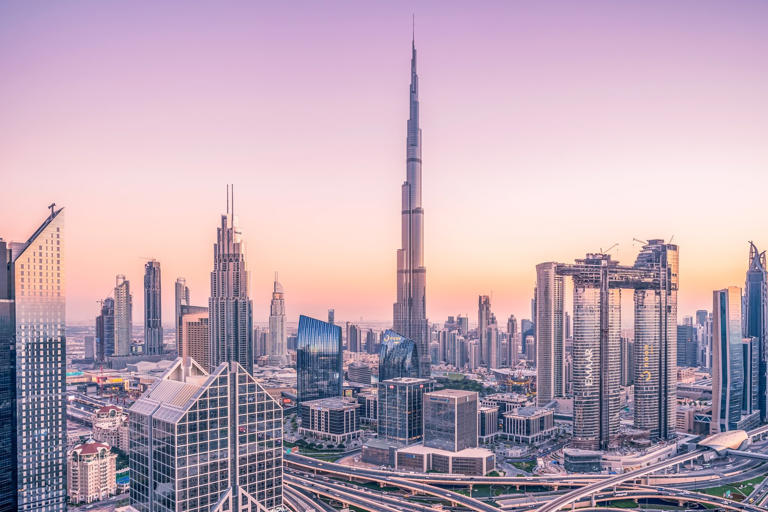
Want to Influence the Future? Be “E-Shaped”
By Sarah DaVanzo
Sarah DaVanzo
Back in the early ’90s, a guy named David Guest conceptualized a “ T-shaped ” person, someone whose skills and knowledge were both broad and deep, general and specialized. Back in the early 2010s, I claimed my own letter-shaped concept in a blog about the skills of the future by coining the term “E-shaped person.” (People liked it. There were viral memes involving Mr. T and Richard Simmons. In fact, people liked it so much that you can now find my concept plagiarized across the web. I’m flattered.)
An E-shaped person is this: someone who is characterized by general experience, deep expertise, a penchant for exploration and the ability to execute — to make, build or produce the tangible result of an idea. AI is getting pretty good at the experience and expertise bit. Gen Z is getting really good at the exploration bit .
Cultural Forensics of America’s Love Affair With KPIs
Historically, the United States finds our pride in being human doings, rather than human beings. We ask, “What do you do?” as the second question out of our mouths at a dinner party. We live in the most competitive and generative economy on earth, boasting over 50% of the world’s VC spend. We’re number one in Nobel Laureates. We account for nearly 30% of the world’s R&D budget. America was founded by explorers and settlers with the wanderlust gene . No wonder KPIs, “upgrades” and seals of approval were born from American culture.
In America, self-worth and cultural currency come from being busy, it’s no wonder the “maker” and “creator” economies thrive in the USA. We are self-sufficient, independent, individualistic, self-made and have considered these traits to be virtues.
Editor’s picks
The 250 greatest guitarists of all time, the 500 greatest albums of all time, the 50 worst decisions in movie history, every awful thing trump has promised to do in a second term.
Because the ones who will really own the future will be those who know how to build it. E-shaped.
Consequences of a “Doing Deficit” in a Society of Generalists
My peers in the innovation space of the world’s largest companies tell me they aren’t short on strategy, insight, foresight and innovative ideas. What they’re lacking is people who can build stuff.They’re looking for talent to build and commercially scale things, leading projects from discovery through delivery.
Businesses today want employees who not only bring ideas to fruition but who lead the process end to end: from idea to invention to incubation to acceleration. This requires grit, focus, tenacity and new skills. Businesses expect executives to fly at different altitudes, toggling between 30,000-foot vision and strategy, and 30-foot project management, production and scale. This requires big-picture strategy and small-picture tactical attention to detail.
The Rolling Stone Culture Council is an invitation-only community for Influencers, Innovators and Creatives. Do I qualify?
Dua Lipa, Future, Metro Boomin', Girl in Red, and All the Songs You Need to Know This Week
Future and metro boomin tap j. cole for 'we still don't trust you' despite apparent diss, j. cole responds to kendrick lamar diss on hard-hitting ‘7 minute drill'.
It’s challenging to measure the KPI or ROI (return on investment) of an insight or idea. Everything in business is data-driven — we can’t compete without metrics. Ideas are like noses… everyone has one. In a world where anyone can be an armchair expert (or keyboard warrior), ideas are commodities. Executed ideas are more rare, and change the world.
To Impact Culture, Be the Long Read Version
In the early 2000s, I worked in the South African gold industry focused on economic stimulus and innovation after Apartheid, and I got an idea: What if we built a Gold of Africa museum? What if the museum not only celebrated ancient African goldsmithing heritage but was also a gold innovation hub and venue for cultural events?
It was a moonshot, but determined, I created a business plan, found investors, acquired a gold artifact collection, managed the construction of the museum over two years, hired and trained the staff, and oversaw the manufacturing of hundreds of gift shop items and gold innovations. The Gold of Africa Museum scaled to become Cape Town’s #3 tourist attraction.
Why did I do it? To make the biggest impact on South African culture. I had spent years sharing strategies and ideas, forging partnerships and exploring “what ifs,” but it was intangible stuff. I realized that making real change and being a social and political catalyst required tangible examples and proof of concepts. The museum became a place where we tested new products in a real-world selling environment.
A modern example of shaping culture through execution (making ideas reality) is MSCHF, an art collective that produces controversial viral products to spark debate and make social commentary. MSCHF challenges conventional notions of art, consumerism and internet culture by putting provocative products out into the wild. MSCHF turns an abstract concept into something concrete that can be seen, touched or physically experienced (“Making the intangible tangible”). I’m so inspired by this.
Jellyroll vs. Jelly Roll: Pennsylvania Band Sues Country Star for Trademark Infringement
Inside jimmy buffett's tribute concert: mccartney, margaritas, and one hell of a parrothead party, lana del rey brings romantic hits — and billie eilish — to enchanting coachella set, judge halts texas ag’s probe into media matters.
Demonstrate that you can turn your ideas into tangible deals, and that you can move smoothly from brainstorming to building.
Ideas are just the seeds to shaping culture; if you want to really change things, build things!
In Our Professional and Personal Lives, We Need to Embrace that People Are Nuanced
- Culture Council
- By Stephanie Dillon
Exploring the Profit Potential of Cannabis Accessories in Retail Dispensaries
- By Harrison Bard
The Good and Bad of Short-Form Video for Songwriting Artists
- By Howard Murphy
Rise of the 'Influencer' Employee
- By Peter Su
From Rolling Stone to Shopping Carts: The Unexplored Intersection of Music and eCommerce
- By Erik Huberman
Most Popular
Jodie foster pulled robert downey jr. aside on their 1995 film set and told him: 'i’m scared of what happens to you next' because of addiction, where to stream 'quiet on set: the dark side of kids tv' online, prince william & kate middleton are reportedly struggling with a 'tidal wave' of royal issues, angel reese signs multiyear agreement with panini america, you might also like, ‘player kings’ review: ian mckellen and toheeb jimoh give star turns in a chilly new take on shakespeare’s ‘henry iv’, from pucci to pulitzer: ‘palm royale’ stokes caftan nostalgia, the best running water bottles according to marathoners, giving away your baby for absolutely no reason please, watch ‘greener grass’ first, coyotes’ name, logo to remain in phoenix while team relocates.
Rolling Stone is a part of Penske Media Corporation. © 2024 Rolling Stone, LLC. All rights reserved.
Verify it's you
Please log in.

- The Star ePaper
- Subscriptions
- Manage Profile
- Change Password
- Manage Logins
- Manage Subscription
- Transaction History
- Manage Billing Info
- Manage For You
- Manage Bookmarks
- Package & Pricing
Tourism Malaysia promotes breakfast culture at Malaysia Travel Escapades in Singapore; nasi lemak and roti canai the main limelight
Saturday, 13 Apr 2024
Related News

Malaysia highlights Sarawak’s charms at Vietnam International Travel Mart
Tourism malaysia eyes five million chinese tourists, tourism, arts and culture ministry hosts break-fast for foreign diplomats.
SINGAPORE (Bernama): Malaysian breakfast delights stole the limelight at the inaugural Malaysia Travel Escapade 2024, at the Suntec City Mall, from April 12 to 14.
The aroma of nasi lemak and roti canai, as well as the chicken bak kut teh, wafted through the air - attracting visitors who came for a taste of Malaysia’s culinary heritage to the three-day travel fair.
Tourism Malaysia Singapore deputy director Mohana Murni Shanmugam said the Malaysian breakfast culture is chosen as the highlight of this travel fair, in line with the government’s submission to the UNESCO Intangible Cultural Heritage list
"We are thrilled to highlight Malaysian breakfast culture and give visitors a taste of authentic Malaysia's culinary delights.
"We believe the Malaysian breakfast culture is unique and becoming part and parcel of the country’s heritage, deserving recognition and promotion as we gear up for Visit Malaysia Year 2026," she told Bernama, here, Saturday.

Visitors were also treated to a mesmerising display of live teh tarik demonstrations by ‘Teh Tarik King’ Fakir Mohd Jamal Mohd from Kedah, showcasing the artistry behind Malaysia's iconic pulled tea.
Mohana Murni said this year Malaysia aims to welcome 27.3 million international tourists with 10 million arrivals from Singapore, generating RM102.7 billion in tourism receipts.
She said last year, Singapore ranked as the top source of tourist-generating markets, contributing significantly to 8.3 million arrivals.
The forthcoming Visit Malaysia Year 2026 has set a target of 35.6 million foreign tourist arrivals, with a target receipt of RM147.1 billion, she added.
The Malaysia Travel Escapade 2024 also offered a glimpse into Malaysia's vibrant culture with a showcase of traditional handicrafts and products including Sarawak’s black pepper, gula apong and coconut sugar, as well as rejuvenating spa services, courtesy of the Association of Malaysian Spas (AMSPA).
Spa Manja manager Roselyn said among the offer at the fair include a two-hour package worth S$48 for customers of the spa that is located in Johor Bahru.
"Our customers are 50-50 between locals and Singaporeans. Spa is one of the main attractions for Singaporeans when they visit Malaysia. This fair allows us to promote our products and the Malaysian spa experience to Singaporeans and help to increase tourism in Malaysia,” she said. - Bernama
Tags / Keywords: Tourism Malaysia , Singapore , Tourism , Breakfast Culture , Nasi Lemak , Roti Canai
Found a mistake in this article?
Report it to us.
Thank you for your report!

Popular BookFest kicks off
Next in aseanplus news.

Trending in AseanPlus
Air pollutant index, highest api readings, select state and location to view the latest api reading.
- Select Location
Source: Department of Environment, Malaysia
Others Also Read
Best viewed on Chrome browsers.

We would love to keep you posted on the latest promotion. Kindly fill the form below
Thank you for downloading.
We hope you enjoy this feature!
Tourist facilities in historic Pilbara town of Cossack closed as dispute with WA government deepens
Traditional owners overseeing the revival of a popular heritage town in Western Australia's north-west say it could become a "ghost town" again, accusing the state government of losing interest in the project.
The Ngarluma-Yindjibarndi Foundation (NYFL) has been trying to turn the abandoned town of Cossack, 1,566km north of Perth, into a tourism hotspot for the past four years.
But it says the Cook government has walked away and will not be offering them legal permissions or a contract to keep managing the town.
Cossack is a significant site for the Ngarluma people, who are the traditional owners of the land.
As the first pearling harbour in the country's north west in the late 19th century, it is also an important part of Australia's colonial history.
In recent years, it has also hosted the popular Cossack Art Awards.
Now, the town's museum and gift shop have been closed along with its campsites, as the dispute deepens.
Major economic, cultural loss
In a detailed statement released yesterday, NYFL said it was devastated and blamed the situation on "a series of bureaucratic bungles and broken promises" by the state government.
"NYFL's vision for Cossack offered huge potential for the area as an eco-tourism destination," the statement read.
"But over the four years that NYLF has managed the site, the [Department of Planning, Lands and Heritage] repeatedly delayed contracts and licenses so that NYFL was often without any guarantee of being paid for its services."
The foundation said uncertainty over the site's future had thwarted several tourism opportunities.
"Including [with] Tourism WA, which was investigating establishing a camping with custodians campground that could have been operational in 2025," the statement reads.
Cossack's future unclear
NYFL said they were recently told "there is insufficient interest" within the Department of Planning, Lands, and Heritage to partner with them going forward.
NYFL chief executive Sean-Paul Stephens said the town's future looked grim.
"Cossack will be closed for the foreseeable future," Mr Stephens said.
"We are disappointed and frustrated to be leaving Cossack but our dealings with the state government have reached breaking point."
A WA Department of Planning, Lands and Heritage spokesperson did not confirm whether it had told NYFL there was no longer interest in pursuing the project.
But they said NYFL's plans for Cossack were outside the scope of the government's original vision, and the government was continuing to fund conservation works at Cossack.
"The original EOI released by the department... was very specific about low-impact tourism offerings and activation of the existing heritage precinct," the spokesperson said.
"There are a number of existing government processes ... which NYFL is encouraged to explore."
- X (formerly Twitter)
Related Stories
'complex, nuanced and often uncomfortable': digging up the dark history of australia’s leprosariums.
Winner of major art prize takes aim at WA government over move to put teenage offenders in adult jail
Historic Pilbara ghost town gets new lease on life
Pilbara woman wins richest regional art prize for second time

- Indigenous Culture
- Regional Communities
- State and Territory Government

COMMENTS
As travel resumes and builds momentum, it's becoming clear that tourism is resilient—there is an enduring desire to travel. Against all odds, international tourism rebounded in 2022: visitor numbers to Europe and the Middle East climbed to around 80 percent of 2019 levels, and the Americas recovered about 65 percent of prepandemic visitors 1 "Tourism set to return to pre-pandemic levels ...
Preserving Cultural Identities for the Future of Tourism. All Regions; 13 Dec 2019 Kyoto (Japan), 13 December 2019 - The World Tourism Organization (UNWTO) and the United Nations Educational, Scientific and Cultural Organization's (UNESCO) Fourth World Conference on Culture and Tourism spotlights the added value of culture for destinations and focuses on the future sustainability of ...
Abstract. In the wake of the Covid-19 pandemic, the future of tourism is a much-debated topic both in academic and non-academic circles with commentators expounding contrasting perspectives. This conceptual paper contributes to such debates and aims at envisioning plausible futures of cultural tourism, in particular.
"Tourism policies and activities should be conducted with respect for the artistic, archaeological and cultural heritage, which they should protect and pass on to future generations; particular care should be devoted to preserving monuments, worship sites, archaeological and historic sites as well as upgrading museums which must be widely open and accessible to tourism visits"
Making Tourism Stronger and Ready for the Future. This has been another challenging year for our societies, our economies and tourism. Many millions of jobs and businesses remain in peril, at the mercy of an evolving crisis and of the actions of governments. However, we are by no means in the same place we were when the pandemic was declared in ...
A particular type of cultural tourism in China has grown dramatically as a result of this intensification of speed and accessibility. Imagine staged scenes of farmers leading cattle across picturesque bridges—with rows of tourists lined up in the right spot to catch the perfect photo.
The UNWTO Report on Tourism and Culture Synergies (2018) points to a number of areas of future cultural tourism development which may also become fruitful areas for research. The tourism experts surveyed by the UNWTO expect cultural tourism to grow in future (93% agree). Growth is also expected to increase the diversity of cultural tourism ...
In 2020 alone, the travel and tourism industry lost $4.5 trillion in GDP and 62 million jobs - the road to recovery remains long. The World Economic Forum's latest Travel & Tourism Development Index gives expert insights on how the sector will recover and grow.; We asked four business leaders in the sector to reflect on the state of its recovery, lessons learned from the pandemic, and the ...
Presents the scientific, technological and cultural drivers for the future of tourism; Considers alternative roles for tourism in the shaping of intelligent futures; Analyzes an integrative framework for tourism futures based upon innovation; Introduces policy and governance proposals for an inclusive and sustainable future of tourism
Future of cultural tourism for urban and regional destinations. Deliverable D2.2 of the Horizon 2020 project SmartCulTour (GA number 870708), published on the project web site on October, 2020 .
Emerging trends and future directions in cultural tourism research. This necessarily limited review of cultural tourism research over the past decade or so reflects many of the trends that are outlined in the UNWTO Report on Tourism and Culture Synergies (2018). The many academics who responded to the UNWTO survey not only underlined the growth ...
The realization of a future in which regenerative tourism, a further evolution of sustainable tourism, becomes mainstream depends on changing the behaviour of both hosts and travellers. In the World Economic Forum's Travel & Tourism Development Index 2021: Rebuilding for a Sustainable and Resilient Future , Japan took the top spot in the ...
Because of the 2020 Olympics' postponement, the Japan National Tourism Organization created a 360-degree virtual tour that can be viewed via smartphone or with VR goggles, Japan: Where Tradition Meets the Future, which virtually transports users to well-known landmarks including the Tokyo Tower and the Sagano Bamboo Forest, blending culture ...
Stakeholder collaboration in tourism and culture 29. 1.3.2 . Future needs and priorities 30. 1.3.3 . Statistics and measurement 33. 1.3.4 . Balancing promotion and protection 34. 1.3.5 . Community involvement 35. ... cultural tourism that, as the findings of the study confirm, is growing at an unprecedented rate. ...
The book charts a path towards sustainable tourism, one that is underpinned by a commitment to people, planet, and prosperity. Frenkiel added: "We came up with 13 guiding principles for the future of tourism, so for example, seeing the whole picture - tourism often isn't looked at very holistically. We used better metrics, so not just ...
The Advisory Committee provides the Future of Tourism Coalition with expertise and guidance on areas that are strategic for the transformation of tourism and may otherwise be under-represented. It provides broader perspectives to ensure the movement remains true to its Guiding Principles, mission, and vision, and that the approach is inclusive ...
Tencent's cloud-enabled MR cultural tourism solution significantly reduces the cost of producing immersive MR experiences compared to traditional on-site filming method. Six key features of the new MR solution: 1. Video shooting from fixed camera position, mirrored virtually with real-time rendering for seamless imagery.
e.g. Encyclopaedia Britannica (1926), "Psychology of culture contact", Vol. 1, 13th ed., Encyclopaedia Britannica, London and New York, NY, pp.765-771. ... Inspire the tourism industry and academic community about the future of tourism; The dissemination and formulation of the body of knowledge called tourism futures to practitioners, educators ...
Learn more about these key changes, their implications on the future of travel, and how travel and tourism companies can adapt to meet evolving traveler expectations. Save for later; Adapting to today's travelers. Travel is wired for slow changes. Given long aircraft manufacturing times and life cycles, it can take decades to roll out new ...
Changing the Future of Tourism NEOM is the world's most ambitious tourism project. Built on an ancient land, enhanced by world-leading design, immersive digital experiences and seamless travel, it will reshape the possibilities of global travel. ... Cultural Tourism Sr. Manager. With more than 22 years of experience in tourism, Abdulaziz Al ...
A European cooperation project that aims to promote sustainable cultural tourism and economic growth by focusing on cultural resources and cultural heritage. By integrating circular economy principles and sustainable development, the project seeks to promote the use and preservation of existing cultural assets, such as historic sites, buildings ...
Also placing young people at the centre of tourism's future is the Global Youth Tourism Summit (GYTS), the first edition was held on 29 June-July 2, 2022, in Sorrento, Italy, and welcomed more than 120 young delegates from more than 61 countries, alongside UNWTO Ambassadors for Tourism drawn from the worlds of sport, business and gastronomy ...
Reading time: 3 minutes (Photo credit: Paula Ota) The University of Hawaiʻi at Mānoa Shidler College of Business' School of Travel Industry Management (TIM school) held its 22nd annual Celebrate a Legacy in Tourism gala on April 10, at the Sheraton Waikīkī. Also marking the college's 75th anniversary, this year's fundraiser raised a record-breaking $517,000 thanks to the generous ...
Department of Culture and Tourism Abu Dhabi chairman Mohamed Khalifa Al Mubarak recently shared that the emirate's tourism strategy considers more than $10 billion in state-sponsored and public ...
In the wake of the Covid-19 pandemic, the future of tourism is a much-debated topic both in academic and non-academic circles with commentators expounding contrasting perspectives. This conceptual paper contributes to such debates and aims at envisioning plausible futures of cultural tourism, in particular. For that purpose, we first discuss ...
Dubai is a unique and vibrant city home to many art districts, making it an excellent tourist destination. The post Dubai Tourism: Top Art & Culture Districts in Dubai appeared first on Go ...
Back in the early 2010s, I claimed my own letter-shaped concept in a blog about the skills of the future by coining the term "E-shaped person." (People liked it. There were viral memes ...
Tourism Malaysia Singapore deputy director Mohana Murni Shanmugam said the Malaysian breakfast culture is chosen as the highlight of this travel fair, in line with the government's submission to ...
Major economic, cultural loss ... The foundation said uncertainty over the site's future had thwarted several tourism opportunities. "Including [with] Tourism WA, which was investigating ...
#1 (Intro) Lyrics: And it hurt me to say it (This beat is so, so Metro) / It really hurt me to say it (Southside, Southside, Southside) / I can find a million Future clones all around the world (Yes